Angiogenin Expression in Plants
Spangenberg; German ; et al.
U.S. patent application number 16/820051 was filed with the patent office on 2021-02-04 for angiogenin expression in plants. This patent application is currently assigned to Agriculture Victoria Services PTY LTD. The applicant listed for this patent is Agriculture Victoria Services PTY LTD. Invention is credited to Benjamin Graeme Cocks, Matthew Knight, Matthew McDonagh, Aidyn Mouradov, German Spangenberg, Jianghui Wang.
| Application Number | 20210032611 16/820051 |
| Document ID | / |
| Family ID | 1000005162156 |
| Filed Date | 2021-02-04 |
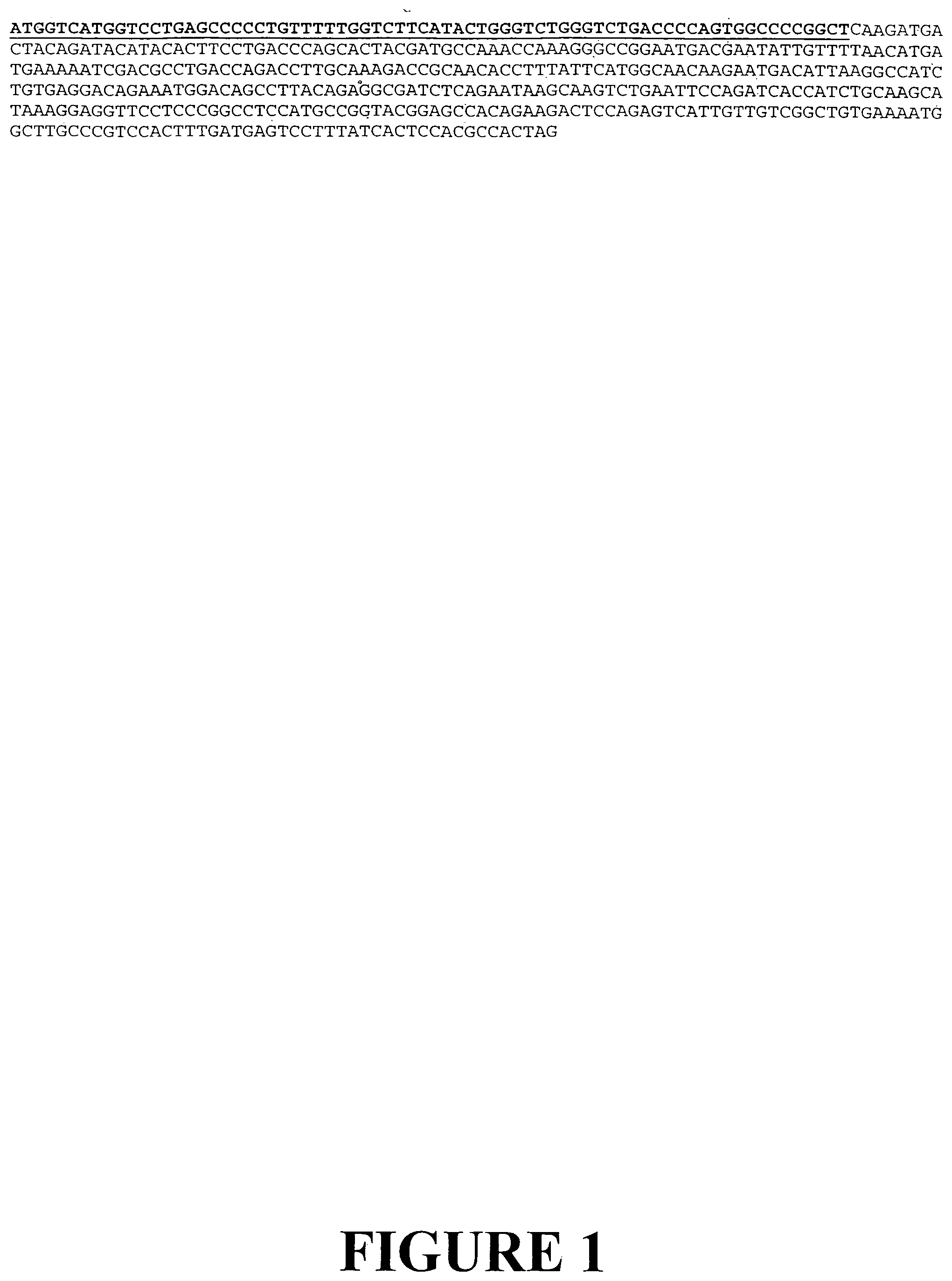
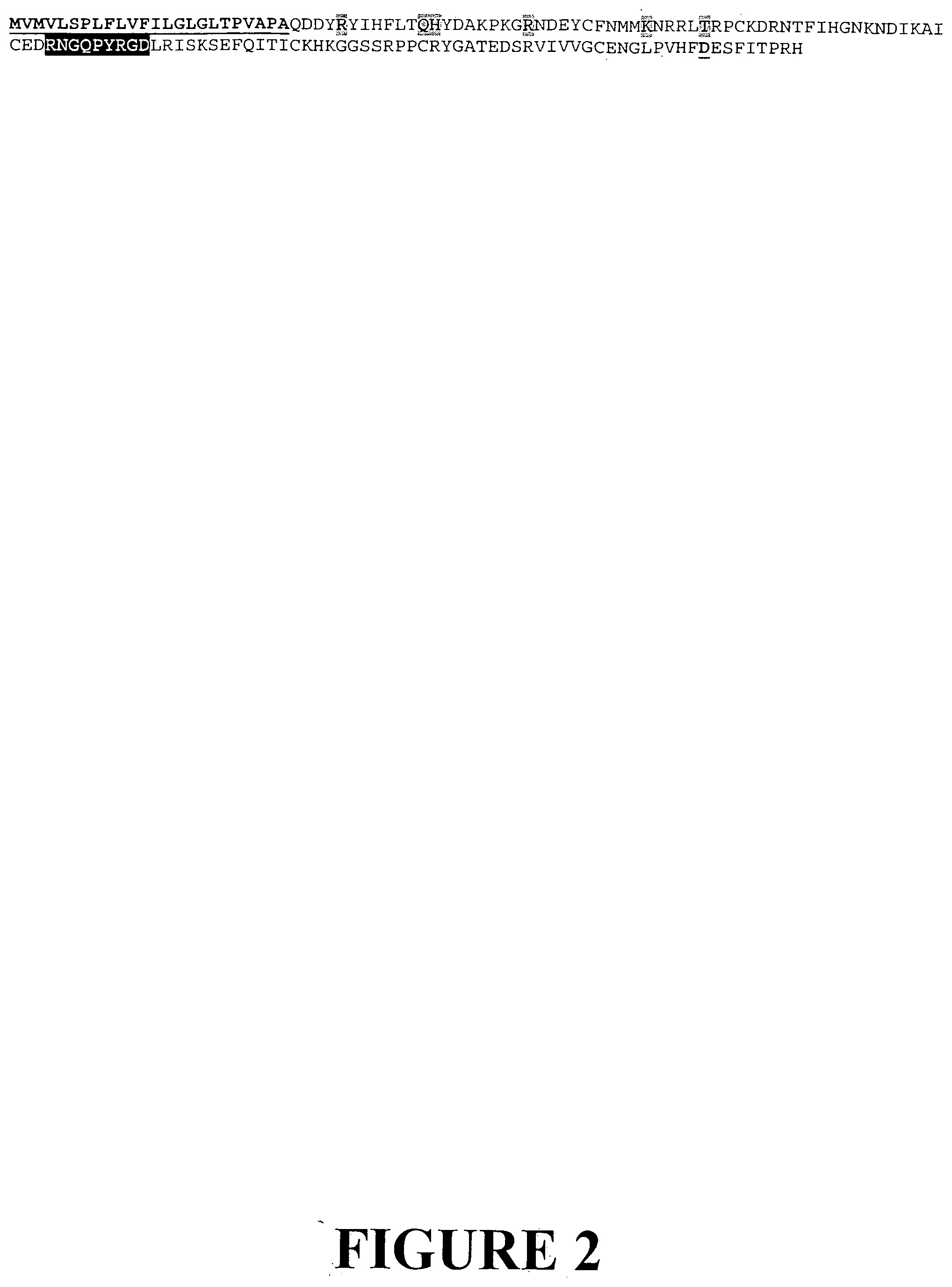

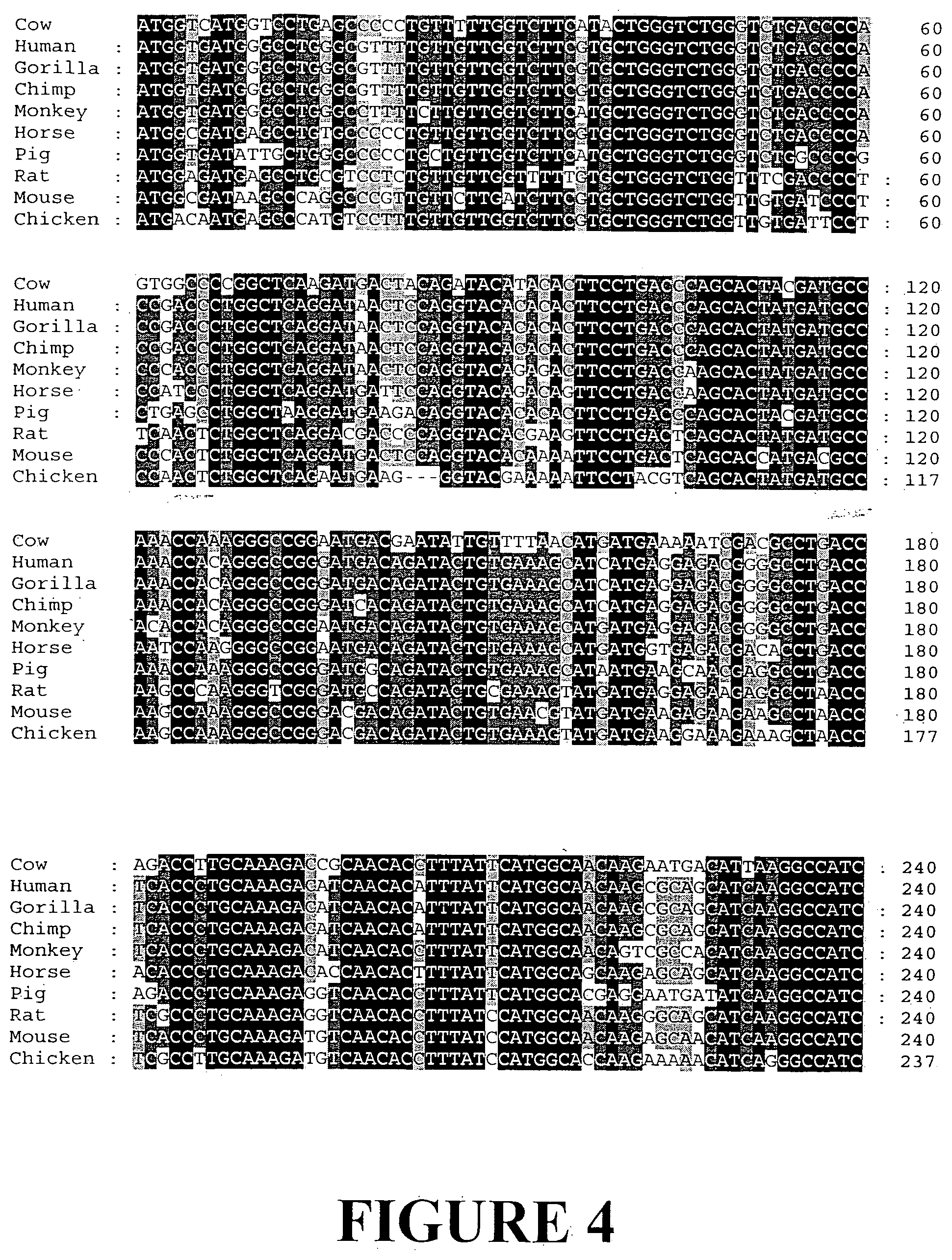
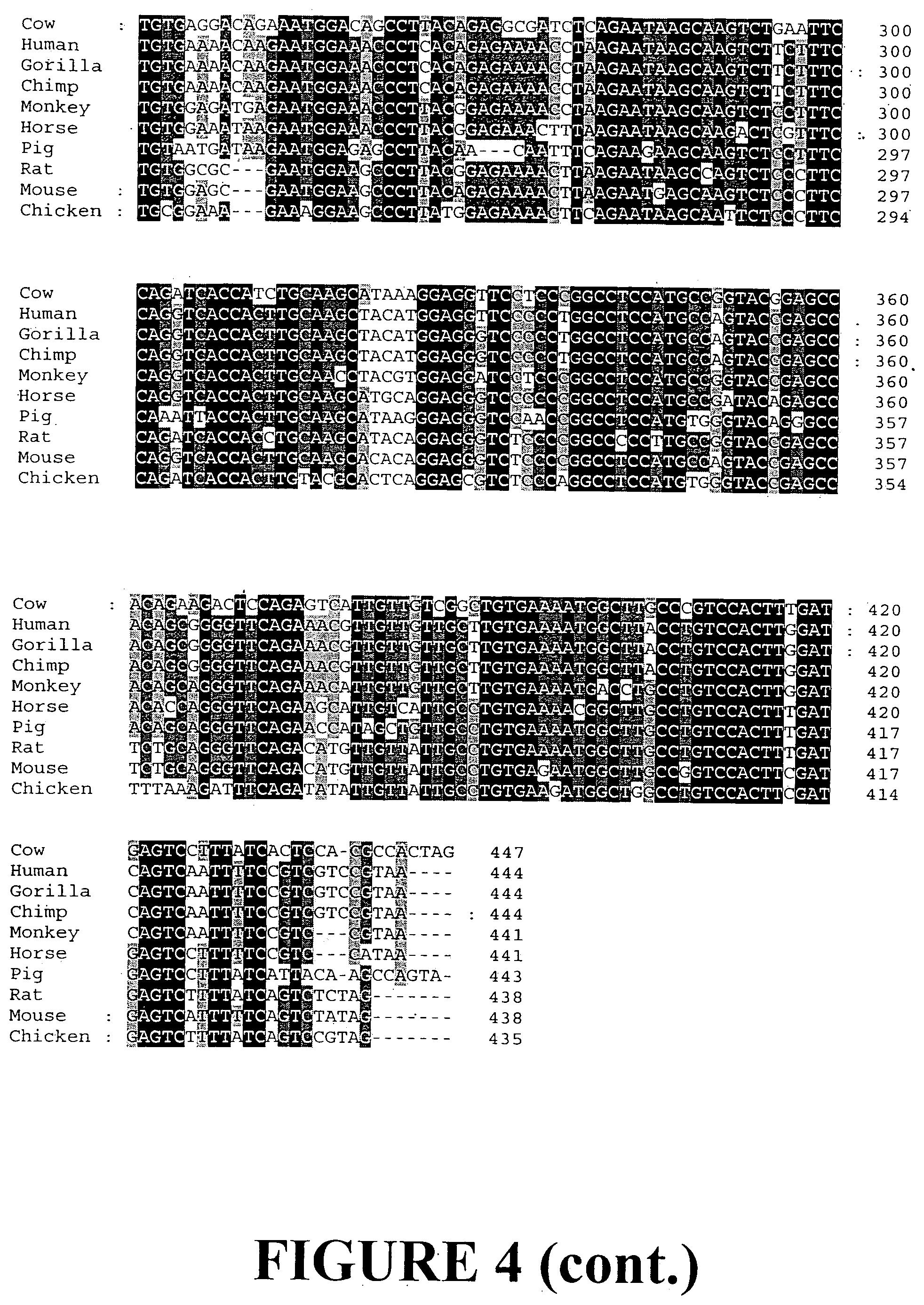
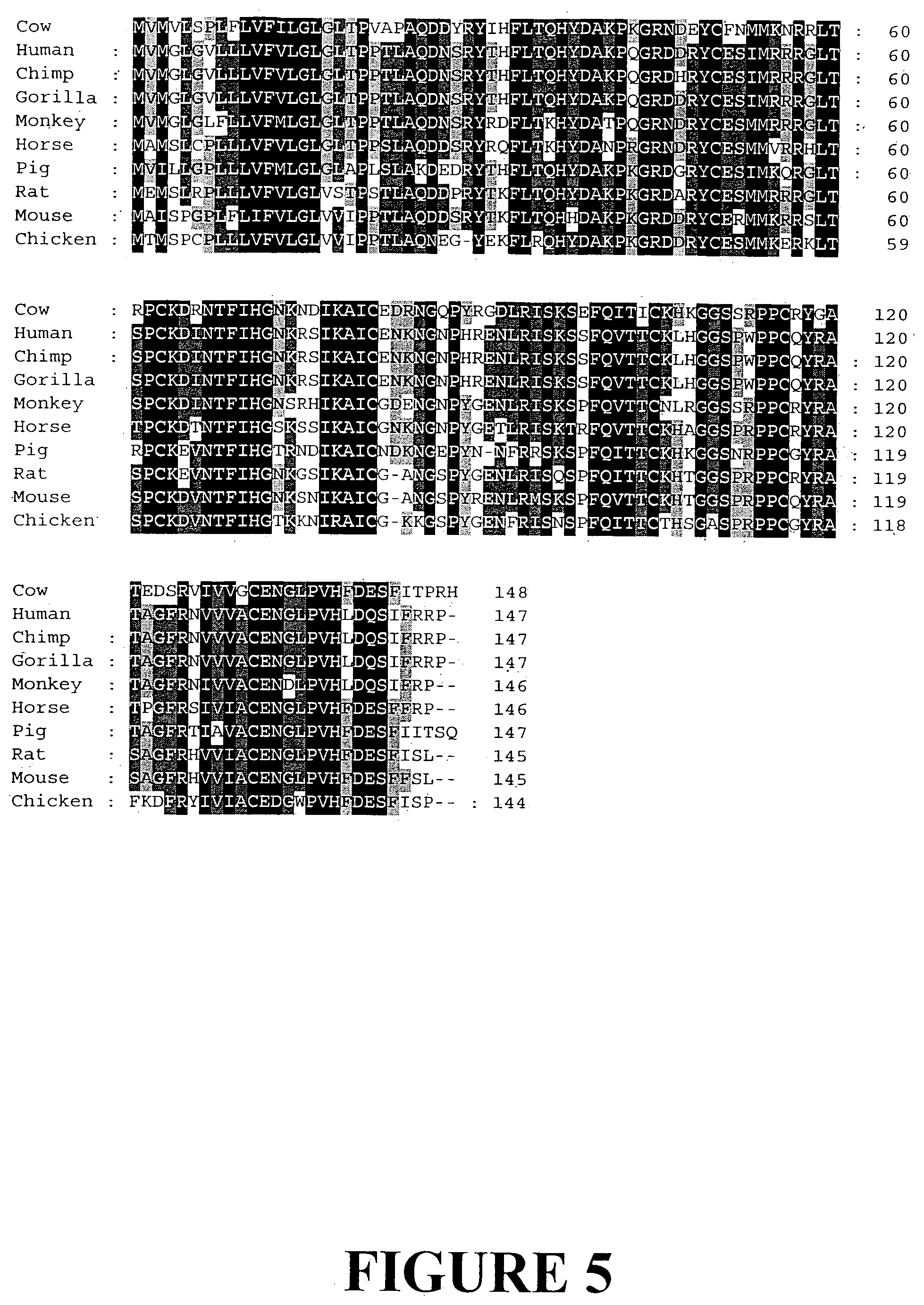
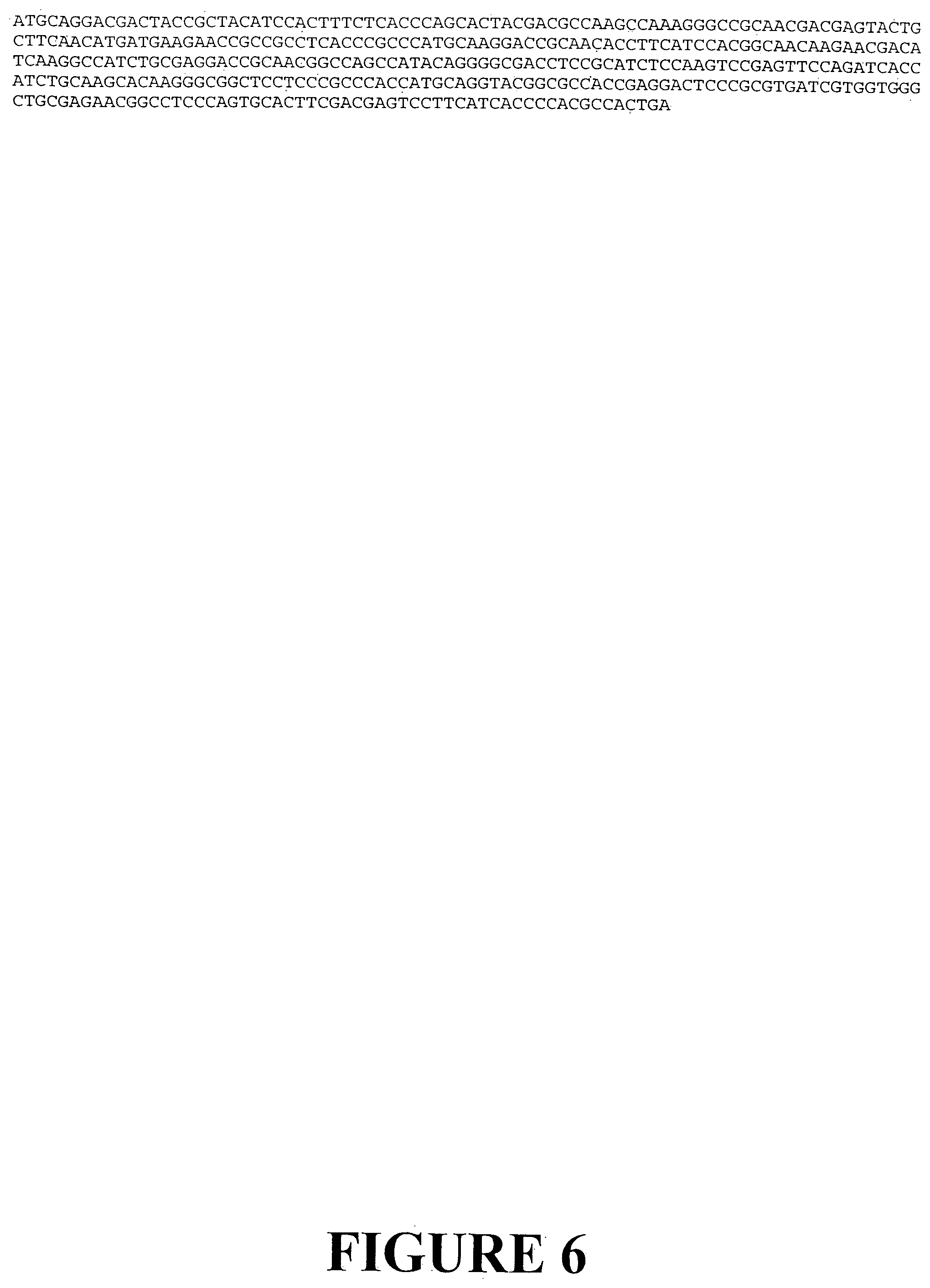
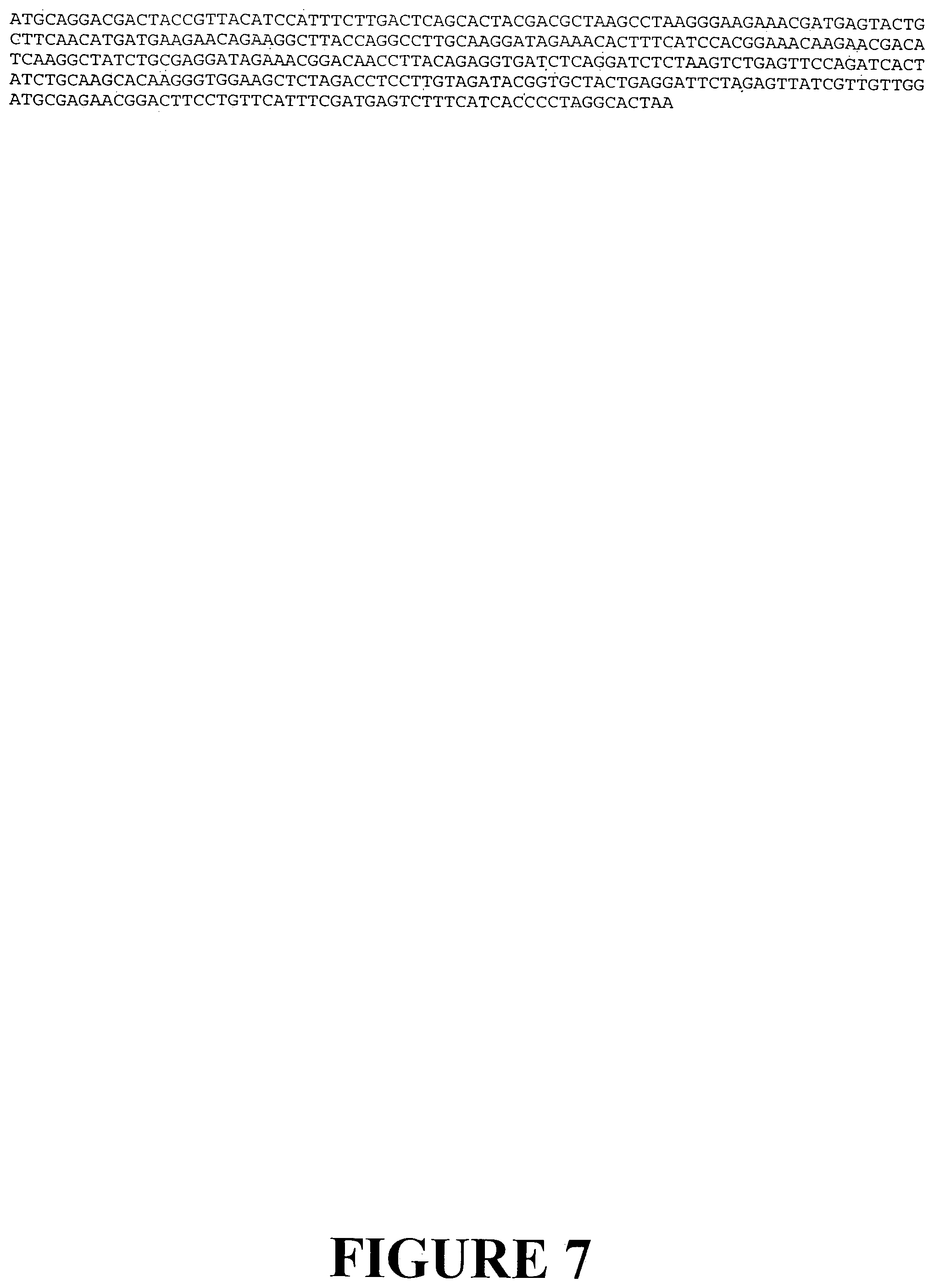
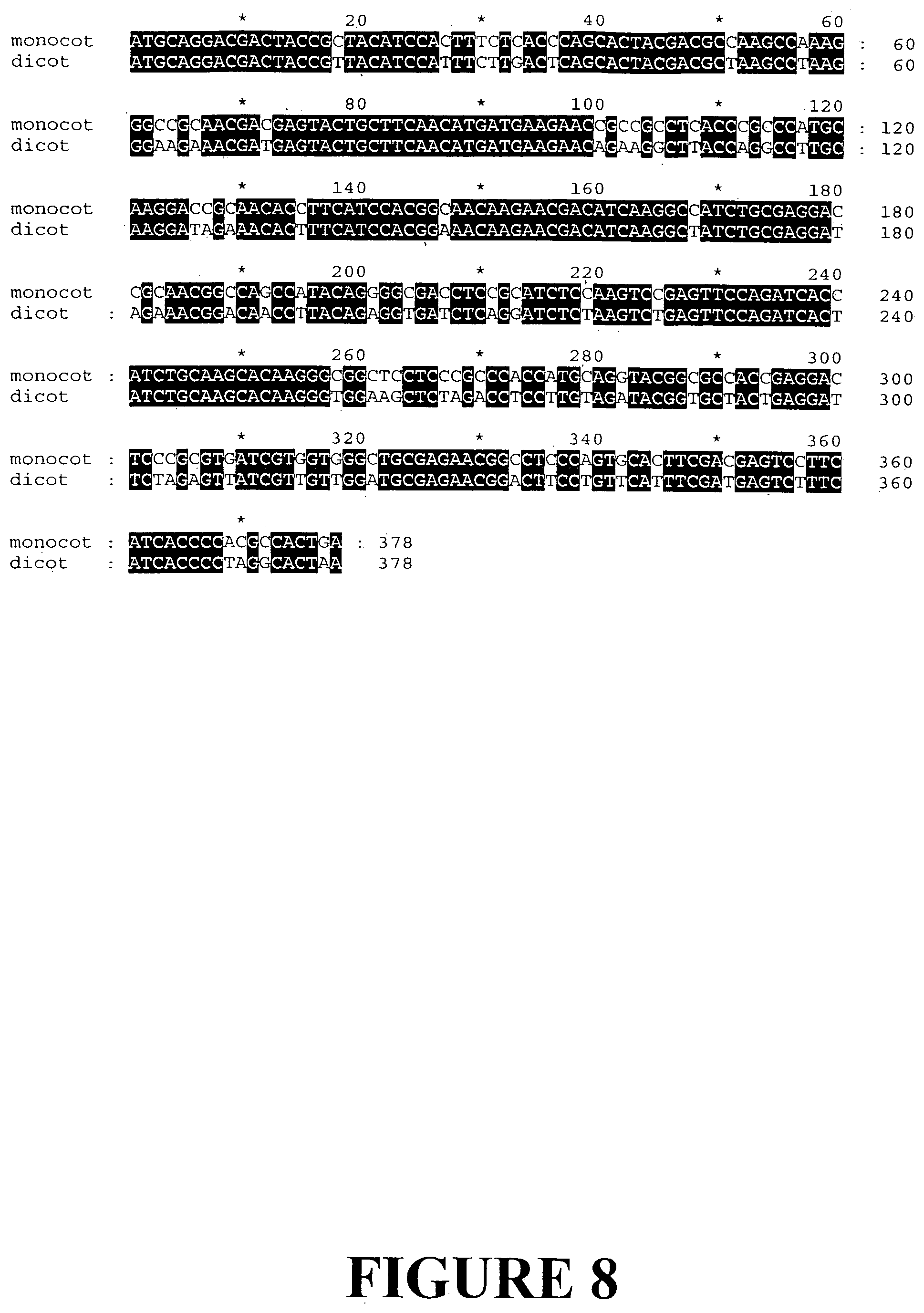

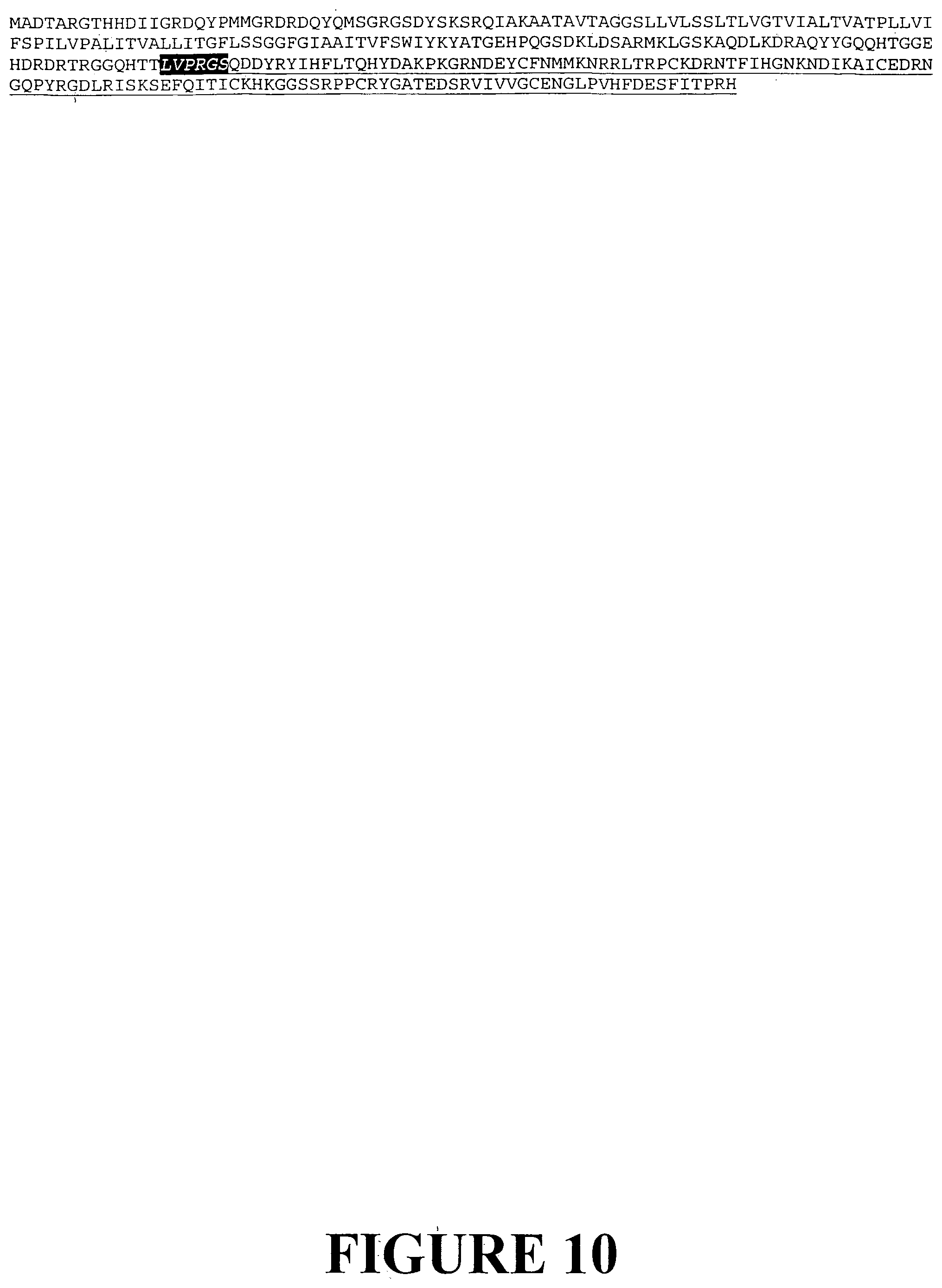
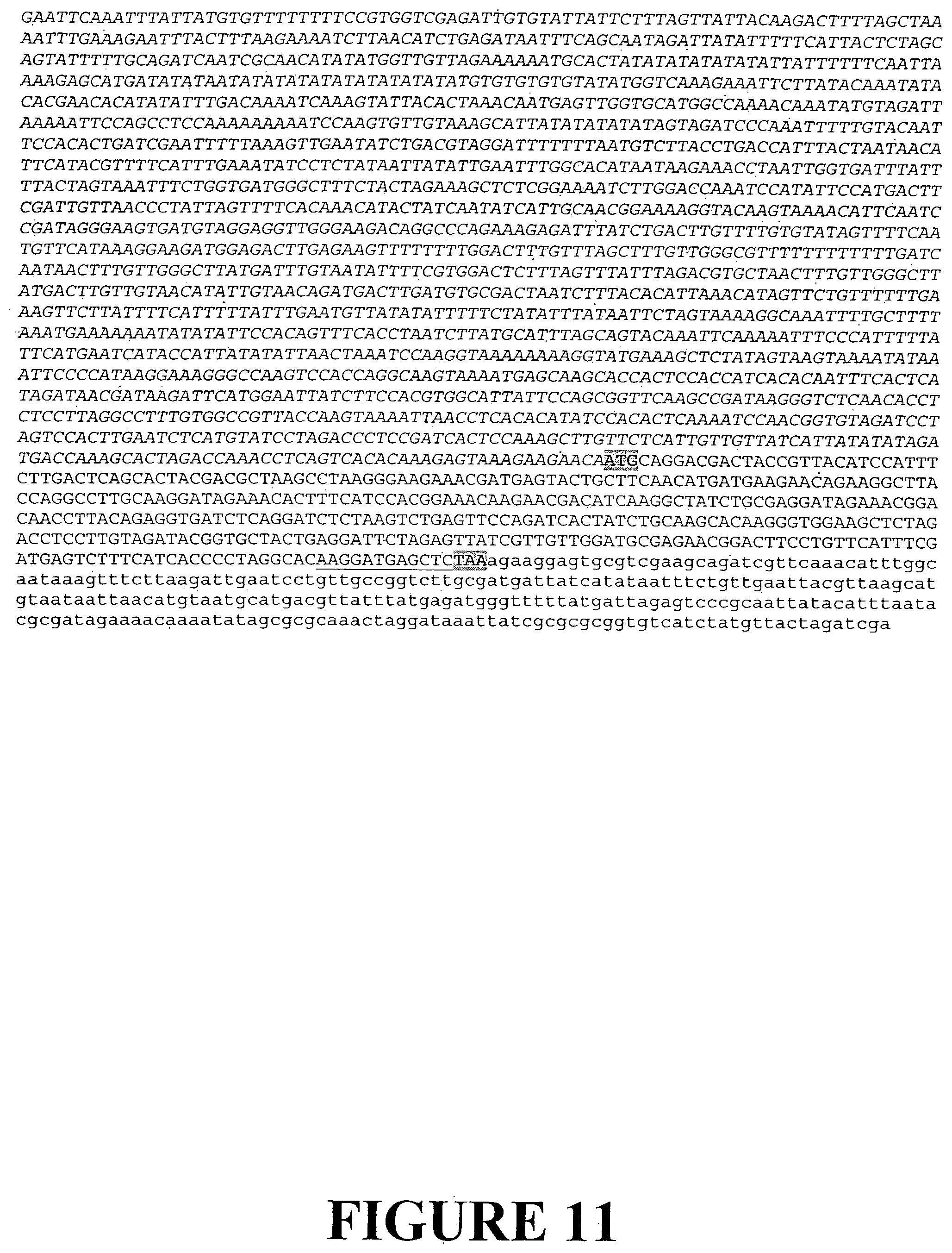
View All Diagrams
| United States Patent Application | 20210032611 |
| Kind Code | A1 |
| Spangenberg; German ; et al. | February 4, 2021 |
Angiogenin Expression in Plants
Abstract
The present invention relates to plant-produced angiogenins, to related plant cells, plant calli, plants, seeds and other plant parts and products derived therefrom and to uses of plant-produced angiogenins. The present invention also relates to expression of angiogenin genes in plants and to related nucleic acids, constructs and methods.
| Inventors: | Spangenberg; German; (Bundoora, AU) ; Mouradov; Aidyn; (Mill Park, AU) ; Wang; Jianghui; (Bundoora, AU) ; Cocks; Benjamin Graeme; (View Bank, AU) ; Knight; Matthew; (Airport West, AU) ; McDonagh; Matthew; (Williamstown, AU) | ||||||||||
| Applicant: |
|
||||||||||
|---|---|---|---|---|---|---|---|---|---|---|---|
| Assignee: | Agriculture Victoria Services PTY
LTD Bundoora AU |
||||||||||
| Family ID: | 1000005162156 | ||||||||||
| Appl. No.: | 16/820051 | ||||||||||
| Filed: | March 16, 2020 |
Related U.S. Patent Documents
| Application Number | Filing Date | Patent Number | ||
|---|---|---|---|---|
| 13510511 | Aug 20, 2012 | |||
| PCT/AU2010/001543 | Nov 18, 2010 | |||
| 16820051 | ||||
| Current U.S. Class: | 1/1 |
| Current CPC Class: | C12N 9/22 20130101; C12N 15/8257 20130101 |
| International Class: | C12N 9/22 20060101 C12N009/22; C12N 15/82 20060101 C12N015/82 |
Foreign Application Data
| Date | Code | Application Number |
|---|---|---|
| Nov 18, 2009 | AU | 2009905627 |
Claims
1-16. (canceled)
17. A plant cell, wherein the plant cell is optionally part of a plant callus, plant, seed or other plant part, said plant cell containing a nucleic acid encoding an angiogenin, wherein said nucleic acid encoding an angiogenin comprises (a) an N-terminal plant signal sequence that when expressed as the N-terminus of an angiogenin protein drives angiogenin accumulation in the plant cell to a sub-cellular component selected from mitochondria, chloroplast, nucleus and nucleolus, and (b) a nucleotide sequence encoding a functional angiogenin protein selected from the group consisting of: (i) SEQ ID NO: 52, (ii) variants of SEQ ID NO: 52, having at least 95% sequence identity to the full length of SEQ ID NO: 52, and (iii) nucleotide sequences encoding the same amino acid sequence as SEQ ID NO: 52, and wherein said nucleic acid provides for a yield of angiogenin protein between approximately 5 and 30% of the total soluble protein of said plant cell.
18. The plant cell of claim 17, wherein the sequence encoding a functional angiogenin is SEQ ID NO: 52, or a nucleotide sequence encoding the same amino acid sequence as SEQ ID NO: 52.
19. The plant cell of claim 18, wherein the N-terminal signal is selected from one or more of the 4-amino-acid sequence NTPP, an N-terminal MTS, a nucleotide sequence encoding oleosin or an N-terminal NLS or NOS.
20. An artificial construct comprising a nucleic acid encoding an angiogenin and a promoter, operatively linked to the nucleic acid encoding an angiogenin, wherein the promoter is effective for enabling expression of the nucleic acid encoding an angiogenin in a plant cell; and wherein said nucleic acid encoding an angiogenin comprises (a) an N-terminal plant signal sequence that when expressed as the N-terminus of an angiogenin protein drives angiogenin accumulation in the plant cell to a sub-cellular component selected from mitochondria, chloroplast, nucleus and nucleolus, and (b) a nucleotide sequence encoding a functional angiogenin protein selected from the group consisting of: (i) SEQ ID NO: 52, (ii) variants of SEQ ID NO: 52, having at least 95% sequence identity to the full length of SEQ ID NO: 52, and (iii) nucleotide sequences encoding the same amino acid sequence as SEQ ID NO: 52, and wherein said nucleic acid provides for a yield of angiogenin protein between approximately 5% and 30% of the total soluble protein of a transfected plant cell.
21. The artificial construct according to claim 20, wherein the sequence encoding a functional angiogenin is SEQ ID NO: 52, or a nucleotide sequence encoding the same amino acid sequence as SEQ ID NO: 52.
22. The artificial construct of claim 21, wherein the N-terminal signal is selected from one or more of the 4-amino-acid sequence NTPP, an N-terminal MTS, a nucleotide sequence encoding oleosin or an N-terminal NLS or NOS.
23. A plant cell, wherein the plant cell is optionally part of a plant callus, plant, seed or other plant part, said plant cell containing a construct comprising: (a) a nucleotide sequence encoding an N-terminal plant signal peptide that when expressed as the N-terminus of an angiogenin protein drives angiogenin accumulation in the plant cell to a sub-cellular component selected from mitochondria, chloroplast, nucleus and nucleolus, and (b) a nucleotide sequence encoding an angiogenin protein having RNase and cell-binding activity, and wherein said construct provides a yield of angiogenin protein between approximately 5% and 30% of the total soluble protein of said plant cell.
24. An artificial construct for expressing angiogenin in a plant cell comprising (a) an operatively linked promoter, (b) a nucleotide sequence encoding an N-terminal plant signal peptide that when expressed as the N-terminus of an angiogenin protein drives angiogenin accumulation in the plant cell to a sub-cellular component selected from mitochondria, chloroplast, nucleus and nucleolus, and (c) a nucleotide sequence encoding an angiogenin protein having RNase and cell-binding activity, and wherein said construct provides for a yield of angiogenin protein between approximately 5% and 30% of the total soluble protein of said plant cell.
Description
FIELD OF THE INVENTION
[0001] The present invention relates to plant-produced angiogenins, to related plant cells, plant calli, plants, seeds and other plant parts and products derived therefrom and to uses of plant-produced angiogenins.
[0002] The present invention also relates to expression of angiogenin genes in plants and to related nucleic acids, constructs and methods.
BACKGROUND OF THE INVENTION
[0003] Angiogenin, encoded by the ANG gene, is a member of the ribonuclease (RNase) superfamily. Angiogenin (also known as RNase5) is a 14 kDa, non-glycosylated secreted ribonuclease polypeptide. Angiogenin is known to regulate the formation of new blood vessels through a process called angiogenesis and is known to regulate neuron survival with functional mutations in the protein a cause of the neuromuscular disorder amyotrophic lateral sclerosis (ALS).
[0004] During angiogenisis, the angiogenin protein binds to receptors on the surface of endothelial cells and smooth muscle cells and undergoes nuclear translocation where it stimulates the production of ribosomal RNA (rRNA) which is required for the growth and division of cells for capillary formation. Angiogenesis associated with exercise causes capillary growth that allows for greater nutrient and oxygen delivery to muscle tissue.
[0005] In our co-pending application PCT/AU2009/000603 we demonstrated that angiogenin increases muscle cell growth and differentiation in vitro, and significantly alleviates the potent inhibitory effects of myostatin on myoblasts. Angiogenin is enriched in colostrum and milk, secretions which evolved to promote health, growth and development of suckling mammals. When added to the feed of mice, angiogenin purified from bovine milk increased exercising muscle growth by 50% over a 4 week period. We demonstrated that angiogenin is bioavailable when administered orally in our co-pending application PCT/AU2009/000602.
[0006] Angiogenin has also been shown to possess a number of other activities. These include the ability to remove skin defects such as pigmented spots, modulation of immune responses, protection of polymorphonuclear leukocytes from spontaneous degradation, and microbicidal activity against systemic bacterial and fungal pathogens. Angiogenin also appears to be required for effective activity of growth factors such as VEGF, EGF and FGF. In addition, functional mutations in the angiogenin protein cause the neuromuscular disorder amyotrophic lateral sclerosis (ALS).
[0007] Angiogenin may have numerous applications, including applications in medicine, dietary foodstuff supplements and cosmetics. However, the use of angiogenin in such applications requires an efficient process for the preparation of the protein on a commercial scale from an appropriate source.
[0008] Angiogenin is readily available in bovine milk, however its use as a source of angiogenin is not favoured as angiogenin is only present in bovine milk at a low level.
[0009] Also, certain proteins, such as caseins, and milk whey proteins such as immunoglobulin, lactoferrin and lactoperoxidase present in milk mask angiogenin, hindering its purification.
[0010] Reference to any prior art in the specification is not, and should not be taken as, an acknowledgment or any form of suggestion that this prior art forms part of the common general knowledge in Australia or any other jurisdiction or that this prior art could reasonably be expected to be ascertained, understood and regarded as relevant by a person skilled in the art.
[0011] It is an object of the present invention to overcome, or at least alleviate, one or more of the difficulties or deficiencies associated with the prior art.
SUMMARY OF THE INVENTION
[0012] In a first aspect, the present invention provides a plant cell, plant callus, plant, seed or other plant part including an angiogenin gene or a functionally active fragment or variant thereof and/or an angiogenin polypeptide.
[0013] In a second aspect, the present invention provides methods of using plant cells, plant calli, plants, seeds or other plant parts including an angiogenin, for example as feed stock or for human consumption.
[0014] In a further aspect, the present invention provides a plant-produced angiogenin.
[0015] In a further aspect, the present invention provides a feedstock, food supplement or veterinary product including a plant-produced angiogenin.
[0016] In a further aspect, the present invention provides a food, beverage, food supplement, nutraceutical or pharmaceutical including a plant-produced angiogenin.
[0017] In a further aspect the present invention provides a method for producing a transformed plant cell expressing an angiogenin gene.
[0018] In a further aspect, the present invention provides methods of isolating angiogenin from transformed plant cells.
[0019] In a further aspect, the present invention provides methods of regenerating transformed plant calli, plants, seeds or other plant parts from transformed plant cells.
[0020] In a still further aspect, the present invention provides methods of isolating angiogenin from transformed plant calli, plants, seeds or other plant parts.
[0021] In a still further aspect, the present invention provides methods of enhancing expression, activity or isolation of angiogenin in plants, said methods comprising co-expressing angiogenin with a mediator or modulator of angiogenin activity.
[0022] In a still further aspect, the present invention provides an artificial construct including an angiogenin gene, said construct enabling expression of said angiogenin gene in a plant cell.
[0023] In a still further aspect, the present invention provides artificial constructs or chimeric sequences comprising an angiogenin gene and a gene encoding a mediator or modulator of angiogenin activity.
[0024] In a still further aspect, the present invention provides a chimeric sequence comprising an angiogenin gene and a plant signal peptide.
[0025] In a still further aspect, the present invention provides an angiogenin gene with codon usage adapted for plants to enable expression of said angiogenin gene in a plant cell.
[0026] As used herein, except where the context requires otherwise, the term "comprise" and variations of the term, such as "comprising", "comprises" and "comprised", are not intended to exclude further additives, components, integers or steps.
[0027] As used herein, except where the context requires otherwise, the singular forms "a", "an" and "the" include plural aspects.
BRIEF DESCRIPTION OF THE DRAWINGS/FIGURES
[0028] FIG. 1. Nucleotide sequence of the Bos taurus angiogenin, ribonuclease, RNase A family, 5 (ANG) (SEQ ID NO: 1). NCBI Accession NM_001078144. The 72 bp signal peptide sequence identified by NCBI is in bold and underlined.
[0029] FIG. 2. Amino acid sequence of the Bos taurus angiogenin, ribonuclease, RNase A family, 5 (ANG) (SEQ ID NO: 2). NCBI Accession NP_001071612. The 24 aa signal sequence identified by NCBI is in bold and underlined. The angiogenin receptor binding domain is highlighted in black and the active site residues are highlighted in grey. The Asp (D) amino acid highlighted in bold and underlined is a possible site for mutation to enhance angiogenin activity.
[0030] FIG. 3. Nucleotide sequence of the Bos taurus angiogenin, ribonuclease, RNase A family, 5 (ANG) (SEQ ID NO: 3) modified for plant codon bias as defined by Murray et al., (1989). No changes in amino acid sequence to that outlined in FIG. 2 were observed.
[0031] FIG. 4. Nucleotide sequence alignment of representative angiogenin genes from different organisms (SEQ ID NOS: 4-12).
[0032] FIG. 5. Amino acid sequence alignment of representative angiogenin genes from different organisms (SEQ ID NOS: 13-21).
[0033] FIG. 6. Nucleotide sequence of the Bos taurus angiogenin, ribonuclease, RNase A family, 5 (ANG), minus its signal peptide sequence, modified for monocot plant codon bias (SEQ ID NO: 22).
[0034] FIG. 7. Nucleotide sequence of the Bos taurus angiogenin, ribonuclease, RNase A family, 5 (ANG), minus its signal peptide sequence, modified for dicot plant codon bias (SEQ ID NO: 23).
[0035] FIG. 8. Nucleotide sequence alignment, indicating 80.7% similarity, between ANG modified for monocot and dicot plant codon bias. No changes in amino acid sequence to that outlined in FIG. 2 were observed.
[0036] FIG. 9. Nucleotide sequence of Arabidopsis oleosin_ANG fusion gene (SEQ ID NO: 24). The Arabidopsis olesin gene is indicated in plain UPPERCASE. The thrombin protease recognition site is highlighted in black followed by the ANG gene in underlined UPPERCASE font. The start and stop codons are highlighted in grey.
[0037] FIG. 10. Amino acid sequence of the Arabidopsis oleosin_ANG fusion protein (SEQ ID NO: 25). The Arabidopsis olesin protein is indicated in plain UPPERCASE. The thrombin protease recognition site is highlighted in black italics followed by the ANG protein in underlined UPPERCASE font.
[0038] FIG. 11. Nucleotide sequence of an expression cassette containing the ANG gene with an ER signal retention peptide regulated by the AtRbcS light regulated promoter and nopaline synthase (nos) terminator for accumulation in dicot plant tissue (SEQ ID NO: 26). The expression cassette contains the dicot optimised ANG gene sequence outlined in FIG. 7. The AtRbcS promoter is indicated in UPPERCASE italics, the ANG gene is in plain UPPERCASE with the ER signal retention peptide UNDERLINED and the start and stop codon highlighted in grey. The nos terminator is presented in lowercase.
[0039] FIG. 12. Vector map of sequence outlined in FIG. 11 containing the ANG gene with an ER signal retention peptide regulated by the AtRbcS light regulated promoter and nos terminator for transfection and accumulation in dicot plant tissue.
[0040] FIG. 13. Vector map of a control expression cassette designed to express the fluorescent reporter (turboGFP) under control of the constitutive CaMV35s promoter from the plant Cauliflower Mosaic virus (CaMV) for confirmation of expression in dicot plant tissue.
[0041] FIG. 14. Nucleotide sequence of an expression cassette containing the ANG gene with an ER signal retention peptide regulated by the TaRbcS light regulated promoter and nopaline synthase (nos) terminator for accumulation in monocot plant tissue (SEQ ID NO: 27). The expression cassette contains the monocot optimised ANG gene sequence outlined in FIG. 6. The TaRbcS promoter is indicated in UPPERCASE italics, the ANG gene is in plain UPPERCASE with the ER signal retention peptide UNDERLINED and the start and stop codon highlighted in grey. The nos terminator is presented in lowercase.
[0042] FIG. 15. Vector map of sequence outlined in FIG. 14 containing the ANG gene with an ER signal retention peptide regulated by the TaRbcS light regulated promoter and nos terminator for accumulation in monocot plant tissue.
[0043] FIG. 16. Vector map of a control expression cassette designed to express the fluorescent reporter (dsRED) under control of the constitutive ubiquitin promoter from Zea mays (ZmUbi) for confirmation of expression in monocot plant tissue.
[0044] FIG. 17. Nucleotide sequence of an expression cassette containing the ANG gene with an ER signal retention peptide regulated by the AtRbcS light regulated promoter and CaMV35S terminator for transformation and accumulation in dicot plant tissue (SEQ ID NO: 28). The expression cassette contains the ANG gene sequence outlined in FIG. 3. The AtRbcS promoter is indicated in UPPERCASE ITALICS, the ANG gene is in plain UPPERCASE with the ER signal retention peptide UNDERLINED and the start and stop codon highlighted in grey. The CaMV35S terminator is presented in lowercase.
[0045] FIG. 18. Vector map of sequence outlined in FIG. 11 containing the ANG gene with an ER signal retention peptide regulated by the AtRbcS light regulated promoter and nos terminator for transformation and accumulation in monocot plant tissue. The base vector sequence contains the necessary elements for Agrobacterium-mediated transformation and regeneration under appropriate selection.
[0046] FIG. 19. Representative nucleotide sequence of an expression cassette containing the ANG gene with an ER signal retention peptide regulated by the TaRbcS light regulated promoter and terminator for accumulation in monocot plant tissue (SEQ ID NO: 29). The expression cassette contains the ANG gene sequence outlined in FIG. 6. The TaRbcS promoter is indicated in UPPERCASE italics, the ANG gene is in plain UPPERCASE with the ER signal retention peptide UNDERLINED and the start and stop codon highlighted in grey. The TaRbcS terminator is presented in lowercase.
[0047] FIG. 20. Vector map of sequence outlined in FIG. 14 containing the ANG gene with an ER signal retention peptide regulated by the TaRbcS light regulated promoter and nos terminator for transformation and accumulation in dicot plant tissue. The base vector sequence contains the necessary elements for regeneration under appropriate selection.
[0048] FIG. 21. Representative nucleotide sequence of an expression cassette containing the ANG gene with an ER signal retention peptide regulated by the LpRbcS light regulated promoter and LpFT4 terminator for accumulation in monocot plant tissue (SEQ ID NO: 30). The expression cassette contains the ANG gene sequence outlined in FIG. 6. The LpRbcS promoter is indicated in UPPERCASE italics, the ANG gene is in plain UPPERCASE with the ER signal retention peptide UNDERLINED and the start and stop codon highlighted in grey. The LpFT4 terminator is presented in lowercase.
[0049] FIG. 22. Representative nucleotide sequence of an expression cassette containing the ANG gene with an ER signal retention peptide regulated by the Brassica napus napin gene seed specific promoter and CaMV35S terminator for accumulation in dicot seeds (SEQ ID NO: 31). The expression cassette contains the ANG gene sequence outlined in FIG. 7. The napin gene promoter is indicated in UPPERCASE italics, the ANG gene is in plain UPPERCASE with the ER signal retention peptide UNDERLINED and the start and stop codons highlighted in grey. The CaMV35S terminator is presented in lowercase.
[0050] FIG. 23. Nucleotide sequence of an expression cassette containing the ANG gene with an ER signal retention peptide regulated by the Brassica napus napin gene seed specific promoter and nos terminator for accumulation in dicot seeds (SEQ ID NO: 32). The expression cassette contains the ANG gene sequence outlined in FIG. 7. The Bn_napin gene promoter is indicated in UPPERCASE italics, the ANG gene is in plain UPPERCASE with the ER signal retention peptide UNDERLINED and the start and stop codons highlighted in grey. The nos terminator is presented in lowercase.
[0051] FIG. 24. Vector map of sequence outlined in FIG. 23 containing the ANG gene with an ER signal retention peptide regulated by the Brassica napus napin promoter and nos terminator for transformation and accumulation in dicot seed tissue. The base vector sequence contains the necessary elements for Agrobacterium-mediated transformation and regeneration under appropriate selection.
[0052] FIG. 25. Representative nucleotide sequence of an expression cassette containing the ANG gene with an ER signal retention peptide regulated by the Zea mays zein 4 gene seed specific promoter and CaMV35S terminator for accumulation in monocot seeds (SEQ ID NO: 33). The expression cassette contains the ANG gene sequence outlined in FIG. 6. The Zm zein promoter is indicated in UPPERCASE italics, the ANG gene is in plain UPPERCASE with the ER signal retention peptide UNDERLINED and the start and stop codons highlighted in grey. The CaMV35S terminator is presented in lowercase.
[0053] FIG. 26. Nucleotide sequence of an expression cassette containing the ANG gene with an ER signal retention peptide regulated by the Zea mays zein 4 gene seed specific promoter and nos terminator for accumulation in monocot seeds (SEQ ID NO: 34). The expression cassette contains the ANG gene sequence outlined in FIG. 6. The Zm_zein 4 gene promoter is indicated in UPPERCASE italics, the ANG gene is in plain UPPERCASE with the ER signal retention peptide UNDERLINED and the start and stop codons highlighted in grey. The nos terminator is presented in lowercase.
[0054] FIG. 27. Vector map of sequence outlined in FIG. 26 containing the ANG gene with an ER signal retention peptide regulated by the Zea mays zein 4 promoter and nos terminator for transformation and accumulation in monocot seed tissue. The base vector sequence contains the necessary elements for Agrobacterium-mediated transformation and regeneration under appropriate selection.
[0055] FIG. 28. Nucleotide sequence of an expression cassette containing the ANG gene with an ER signal retention peptide regulated by the Orysa sativa PR602 gene seed specific promoter and nos terminator for accumulation in monocot seeds (SEQ ID NO: 35). The expression cassette contains the ANG gene sequence outlined in FIG. 6. The PR602 gene promoter is indicated in UPPERCASE italics, the ANG gene is in plain UPPERCASE with the ER signal retention peptide UNDERLINED and the start and stop codons highlighted in grey. The nos terminator is presented in lowercase.
[0056] FIG. 29. Vector map of sequence outlined in FIG. 28 containing the ANG gene with an ER signal retention peptide regulated by the Orysa sativa PR602 promoter and nos terminator for transformation and accumulation in monocot seed tissue. The base vector sequence contains the necessary elements for Agrobacterium-mediated transformation and regeneration under appropriate selection.
[0057] FIG. 30. Nucleotide sequence of an expression cassette containing the ANG gene with an ER signal retention peptide regulated by the Triticum aestivum glutelin gene seed specific promoter and nos terminator for accumulation in monocot seeds (SEQ ID NO: 36). The expression cassette contains the ANG gene sequence outlined in FIG. 6. The glutelin gene promoter is indicated in UPPERCASE italics, the ANG gene is in plain UPPERCASE with the ER signal retention peptide UNDERLINED and the start and stop codons highlighted in grey. The nos terminator is presented in lowercase.
[0058] FIG. 31. Vector map of sequence outlined in FIG. 30 containing the ANG gene with an ER signal retention peptide regulated by the Triticum aestivum glutelin promoter and nos terminator for transformation and accumulation in monocot seed tissue. The base vector sequence contains the necessary elements for Agrobacterium-mediated transformation and regeneration under appropriate selection.
[0059] FIG. 32. Representative nucleotide sequence of an expression cassette containing the ANG gene with the tobacco calreticulin apoplast signal peptide regulated by the constitutive CaMV35S promoter and terminator for guttation secretion in plants (SEQ ID NO: 37). The expression cassette contains the ANG gene sequence outlined in FIG. 7. The CaMV35S promoter is indicated in UPPERCASE italics, the ANG gene is in plain UPPERCASE with the apoplast signal peptide UNDERLINED and the start and stop codons highlighted in grey. The CaMV35S terminator is presented in lowercase.
[0060] FIG. 33. Representative nucleotide sequence of an expression cassette containing the ANG gene with the tobacco calreticulin apoplast signal peptide regulated by the Arabidopsis phosphate transporter (AtPHT1) gene root-specific promoter and CaMV35S terminator for secretion in dicot roots (SEQ ID NO: 38). The expression cassette contains the ANG gene sequence outlined in FIG. 7. The AtPHT1 promoter is indicated in UPPERCASE italics, the ANG gene is in plain UPPERCASE with the apoplast signal peptide UNDERLINED and the start and stop codons highlighted in grey. The CaMV35S terminator is presented in lowercase.
[0061] FIG. 34. Representative nucleotide sequence of an expression cassette containing the ANG gene with the tobacco calreticulin apoplast signal peptide regulated by the Hordeum vulgare phosphate transporter (HvPHT1) gene root-specific promoter and CaMV35S terminator for secretion in monocot roots (SEQ ID NO: 39). The expression cassette contains the ANG gene sequence outlined in FIG. 6. The HvPHT1 promoter is indicated in UPPERCASE italics, the ANG gene is in plain UPPERCASE with the apoplast signal peptide UNDERLINED and the start and stop codons highlighted in grey. The CaMV35S terminator is presented in lowercase.
[0062] FIG. 35. Representative nucleotide sequence of an expression cassette containing an oleosin_ANG gene fusion regulated by the Arabidopsis oleosin gene promoter and CaMV35S terminator for targeting to the oilbody in dicots (SEQ ID NO: 40). The expression cassette contains the ANG gene sequence outlined in FIG. 7. The Arabidopsis oleosin gene promoter is indicated in UPPERCASE italics. The Arabidopsis olesin gene is indicated in plain UPPERCASE and the ANG gene in underlined UPPERCASE with the thrombin protease recognition site highlighted in black and the start and stop codons highlighted in grey. The CaMV35S terminator is presented in lowercase.
[0063] FIG. 36. Representative nucleotide sequence of an expression cassette containing the tobacco 16sRNA operon (Prrn) promoter and terminator regulatory sequences (Zoubenko, et al., 1994) to express the angiogenin gene in chloroplasts (SEQ ID NO: 41). The 16sRNA operon (Prrn) promoter is indicated in UPPERCASE italics, the ANG gene is in plain UPPERCASE and the start and stop codons highlighted in grey. The 16sRNA operon (Prrn) terminator is presented in lowercase.
[0064] FIG. 37. A. Mesophyll-derived protoplasts of Nicotiana tabacum recovered from in-vitro grown leaves approximately 4-6 weeks old; 0 days post transfection; B. Assessment of protoplasts vigour, with dead cells indicated by dark staining, showing greater than 95 percent viability using Evan's Blue Stain; pre-transfection; C. Assessment of protoplast vigour, with dead cells indicated by dark staining, showing greater than 95 percent viability using Evan's Blue Stain; 36 hours post-transfection.
[0065] FIG. 38. Assessment of transient expression 36 hours post transfection with plasmid DNA containing the turboGFP gene encoding the green fluorescent protein. Protoplasts visualised under A. bright field and B. fluorescent light. The green fluorescent protein is observed as a bright spot under fluorescent light.
[0066] FIG. 39. Electrophoresis of Reverse-transcriptase PCR samples and controls. Lane 1: NO-RT control reaction performed with ANG (F and R) primers on tobacco mesophyll protoplasts transfected with 0957286 CaMV35S-p_turboGFP_nos-t. Lane 2: cDNA from tobacco mesophyll protoplasts transfected with 0957286 CaMV35S-p_turboGFP_nos-t amplified with ANG (F and R) primers. Lane3: NO-RT control reaction performed with ANG (F and R) primers on tobacco mesophyll protoplasts transfected with 1031308 AtRbcS-p_ANG_nos-t. Lane 4: cDNA from tobacco mesophyll protoplasts transfected with 1031308 AtRbcS-p_ANG_nos-t amplified with ANG (F and R) primers. Lane 5: Negative control reaction performed without template (ANG F and R primers). Lane 6: Positive control reaction performed with plasmid template (ANG F and R primers). Lane 7: 1 kb plus DNA Ladder (Invitrogen) Lane 8: NO-RT control reaction performed with Actin (F and R) primers on tobacco mesophyll protoplasts transfected with 0957286 CaMV35S-p_turboGFP_nos-t. Lane 9: cDNA from tobacco mesophyll protoplasts transfected with 0957286 CaMV35S-p_turboGFP_nos-t amplified with Actin (F and R) primers. Lane 10: NO-RT control reaction performed with Actin (F and R) primers on tobacco mesophyll protoplasts transfected with 1031308 AtRbcS-p_ANG_nos-t. Lane 11: cDNA from tobacco mesophyll protoplasts transfected with 1031308 AtRbcS-p_ANG_nos-t amplified with Actin (F and R) primers. Lane 12: Negative control reaction performed without template (Actin F and R primers).
[0067] FIG. 40. A. Mesophyll-derived protoplasts recovered from mature leaves of T. aestium; 0 days post transfection; B. Assessment of protoplast vigour, with dead cells indicated by dark staining, showing greater than 95 percent viability using Evan's Blue Stain; pre-transfection; C. Assessment of protoplast vigour, with dead cells indicated by dark staining, showing greater than 81 percent viability using Evan's Blue Stain; 24 hours post-transfection.
[0068] FIG. 41. Assessment of transient expression 36 hours post transfection with plasmid DNA containing the dsRED gene encoding the dsRED protein. Protoplasts visualised under A. bright field and B. fluorescent light. The dsRED protein is observed as a bright spot under fluorescent light.
[0069] FIG. 42. Electrophoresis of Reverse-transcriptase PCR samples and controls. Lane 1: NO-RT control reaction performed with ANG_F and polyT_R primers on wheat mesophyll protoplasts. Lane 2: cDNA generated by reverse transcription with oligo-dT from total RNA of wheat mesophyll protoplasts amplified with ANG_F and polyT_R primers. Lane3: NO-RT control reaction performed with ANG_F and polyT_R primers on wheat mesophyll protoplasts transfected with 1031312_TaRbcS-p_ANG_nos-t. Lane 4: cDNA from wheat mesophyll protoplasts transfected with 1031312_TaRbcS-p_ANG_nos-t amplified with ANG_F and polyT_R primers. Lane 5: Negative control reaction performed without template (ANG_F and polyT_R primers). Lane 6: 1 kb plus DNA Ladder (Invitrogen). Lane 7: NO-RT control reaction performed with Actin_F and polyT_R primers on wheat mesophyll protoplasts. Lane 8: cDNA from wheat mesophyll protoplasts amplified with Actin_F and polyT_R primers. Lane 9: NO-RT control reaction performed with Actin_F and polyT_R primers on tobacco mesophyll protoplasts transfected with 1031308 AtRbcS-p_ANG_nos-t. Lane 10: cDNA from wheat mesophyll protoplasts transfected with 1031312_TaRbcS-p_ANG_nos-t amplified with Actin_F and polyT_R primers. Lane 11: Negative control reaction performed without template (Actin_F and polyT_R primers).
[0070] FIG. 43. Agrobacterium-mediated transformation of Canola (Brassica napus): A. seed imbibed on filter paper support; B. synchronous germination of seed; C. pre-processing of germinated shoots; D, processing of cotyledons for use as explants; E. regeneration of shoots following cocultivation with Agrobacterium; and F. mature plant in glasshouse.
[0071] FIG. 44. Preparation of embryogenic callus and biolistic transformation of perennial ryegrass: A. tillers of flowering glasshouse-grown plants prior to surface-sterilisation; B. an immature inflorescence isolated for culture in vitro; C. embryogenic callus after culturing of immature inflorescence tissue in vitro for 4-6 weeks; D-E. isolation of 3-5 mm explants of friable embryogenic callus prior to particle bombardment; F. biolistic bombardment of callus with gold particles coated with a transformation construct; G-H. an antibiotic-resistant shoot on selective medium; I. antibiotic-resistant shoots in vessels of root-inducing medium; J. putative transgenic plantlets in soil.
[0072] FIG. 45. Agrobacterium-mediated transformation of bread wheat: A. donor plants ready for harvest; B&C. harvested material for use as source of embryo explants; D. callus material; E. pre-regeneration material on tissue culture medium; F. callus material illustrating reporter gene expression; G. regenerating shoots from callus; H. rooting shoots on selection media; and I. rooted plant in soil.
[0073] FIG. 46. Agrobacterium-mediated transformation of white clover: A. isolation of cotyledonary explants from a mature seed; B. selection of antibiotic-resistant shoots on regeneration medium, C. antibiotic-resistant shoots in vessels of root-inducing medium and D. a putative transgenic plantlet in soil.
[0074] FIG. 47. Map of transformation vector containing nos_nptII_nos selectable marker cassette and the AtRbcS_ANG_CamV35S (FIG. 17) expression cassette used in Agrobacterium mediated transformation of white clover.
[0075] FIG. 48. RT-PCR of positive and negative control (lanes 5 and 6) and putative transgenic angiogenin white clover plants (lanes 1 to 4). Primers used were specific to the angiogenin gene.
[0076] FIG. 49. 2DE gel protein analysis of non-transgenic control and transgenic white clover plants. The three circles represent the ribulose bisphosphate carboxylase small subunit. The angiogenin protein is represented by the square.
[0077] FIG. 50. 2DE gel protein sequence analysis (SEQ ID NO: 42). Sixty seven percent sequence coverage (indicated in bold and underlined) was obtained of the protein extracted from the gel.
[0078] FIG. 51. Electrophoresis of PCR samples and controls. Lane 1: 1 kb plus DNA Ladder (Invitrogen) Lane 2 and 3: PCR of DNA from Arabidopsis transgenic line 1, transformed with pPFG000023 AtRbcS-ANG_nos-t, amplified with ANG (F and R) primers. Lane 4 and 5: PCR of DNA from Arabidopsis transgenic line 2, transformed with pPFG000023 AtRbcS-ANG_nos-t, amplified with ANG (F and R) primers. Lane 6 and 7: PCR of DNA from wild-type untransformed Arabidopsis amplified with ANG (F and R) primers. Lane 8 and 9: Positive control reaction performed with pPFG000023 plasmid template (ANG F and R primers).
DETAILED DESCRIPTION OF THE EMBODIMENTS
[0079] In a first aspect, the present invention provides a plant cell, plant callus, plant, seed or other plant part including an angiogenin gene or a functionally active fragment or variant thereof and/or an angiogenin polypeptide. Preferably, said plant cell, plant callus, plant, seed or other plant part is produced by a method as described herein.
[0080] In a preferred aspect, the angiogenin gene or functionally active fragment or variant thereof may be co-expressed with a modular or mediator of angiogenin activity.
[0081] By `plant cell` is meant any self-propagating cell bounded by a semi-permeable membrane and containing a plastid. Such a cell also requires a cell wall if further propagation is desired. Plant cell, as used herein includes, without limitation, algae, cyanobacteria, seeds suspension cultures, embryos, meristematic regions, callus tissue, leaves, roots, shoots, gametophytes, sporophytes, pollen and microspores.
[0082] In a second aspect, the present invention provides methods of using the plant cells, plant calli, plants, seeds or other plant parts including an angiogenin as a composition such as a feed stock, food supplement or veterinary product for animals or a food, food supplement, nutraceutical or pharmaceutical suitable for human consumption. For example, the value added plant material, including the angiogenin protein, may be used as an enhanced feedstock for a variety of applications.
[0083] Accordingly, the present invention provides a method of using a plant cell, plant callus, plant, seed or other plant part including an angiogenin as feed stock for animals or as a composition suitable for human consumption, said method comprising producing the angiogenin in the plant cell, plant callus, plant, seed or other plant part and preparing it in a form suitable for use as a feed stock for animals or a composition suitable for human consumption.
[0084] Animals to which the invention may be applied include pigs, chickens (broilers and layers), beef, dairy, goats, sheep are livestock, that can benefit from abundant sources of angiogenin provided by plants, as would companion animals and performance animals eg horses, dogs.
[0085] It may be desirable to administer plant derived angiogenin encapsulated or otherwise protected to passage the rumen or stomach more effectively. Less digestible tissues such as seed coat and roots (as opposed to fruit and leaves) may extend gut passage and digestive tract protein release for intestinal binding and uptake.
[0086] Co-administration with other supplements and treatments, eg growth hormone such as bovine somatotrophin, antibiotics, nutrient supplements for animals, is also contemplated.
[0087] In a third aspect, the present invention provides a plant-produced angiogenin. Preferably said angiogenin is produced by a method as described herein.
[0088] In a further aspect, the present invention provides a feedstock, food supplement or veterinary product including a plant-produced angiogenin. Preferably said angiogenin is produced by a method as described herein.
[0089] In a further aspect, the present invention provides a food, beverage, food supplement, nutraceutical or pharmaceutical including a plant-produced angiogenin. Preferably said angiogenin is produced by a method as described herein.
[0090] In a further aspect, the present invention provides a method of producing a transformed plant cell expressing an angiogenin gene, said method comprising [0091] providing a gene encoding angiogenin or a functionally active fragment or variant thereof, and a plant cell; [0092] introducing the angiogenin gene into the plant cell to produce a transformed plant cell; and [0093] culturing the transformed plant cell to produce a transformed plant cell expressing the angiogenin gene.
[0094] By a `transformed plant cell` is meant a plant cell which has undergone transformation.
[0095] By `transformation` is meant the transfer of nucleic acid into a plant cell.
[0096] By a `gene encoding angiogenin" or `angiogenin gene` is meant a nucleic acid encoding a polypeptide having one or more of the biological properties of angiogenin. The gene encoding angiogenin may be a transgene. The gene encoding angiogenin may include an angiogenin coding sequence optionally operatively linked to a sequence encoding one or more of a promoter, signal peptide, terminator, and mediator or modulator of angiogenin activity.
[0097] By a `transgene` is meant a nucleic acid suitable for transforming a plant cell.
[0098] By a `functionally active` fragment or variant of an angiogenin gene is meant that the fragment or variant (such as an analogue, derivative or mutant) encodes a polypeptide having one or more of the biological properties of angiogenin. Such variants include naturally occurring allelic variants and non-naturally occurring variants. Additions, deletions, substitutions and derivatizations of one or more of the nucleotides are contemplated so long as the modifications do not result in loss of functional activity of the fragment or variant.
[0099] Preferably the functionally active fragment or variant has at least approximately 80% identity to the relevant part of the specified sequence to which the fragment or variant corresponds, more preferably at least approximately 90% identity, even more preferably at least approximately 95% identity, most preferably at least approximately 98% identity.
[0100] Preferably the fragment has a size of at least 20 nucleotides, more preferably at least 50 nucleotides, more preferably at least 100 nucleotides, more preferably at least 200 nucleotides, more preferably at least 300 nucleotides.
[0101] Such functionally active variants and fragments include, for example, those having conservative nucleic acid changes, those having codon usage adapted for plants, and those in which the signal peptide is removed and optionally replaced by another signal peptide.
[0102] By `conservative nucleic acid changes` is meant nucleic acid substitutions that result in conservation of the amino acid in the encoded protein, due to the degeneracy of the genetic code. Such functionally active variants and fragments also include, for example, those having nucleic acid changes which result in conservative amino acid substitutions of one or more residues in the corresponding amino acid sequence.
[0103] By `conservative amino acid substitutions` is meant the substitution of an amino acid by another one of the same class, the classes being as follows: [0104] Nonpolar: Ala, Val, Leu, Ile, Pro, Met Phe, Trp [0105] Uncharged polar: Gly, Ser, Thr, Cys, Tyr, Asn, Gln [0106] Acidic: Asp, Glu [0107] Basic: Lys, Arg, His
[0108] Other conservative amino acid substitutions may also be made as follows: [0109] Aromatic: Phe, Tyr, His [0110] Proton Donor: Asn, Gln, Lys, Arg, His, Trp [0111] Proton Acceptor: Glu, Asp, Thr, Ser, Tyr, Asn, Gln
[0112] Particularly preferred fragments and variants include one or more conserved binding domains such as sequences encoding a catalytic core or a cell binding site. Examples of such domains are shown in FIG. 2 and preferably include the sequence Arg, Asn, Gly, Gln, Pro, Tyr, Arg, Gly, Asp (SEQ ID NO: 43).
[0113] Particularly preferred fragments and variants include a catalytic core. By a "catalytic core" is meant an internal region of the polypeptide excluding signal peptide and N- and C-terminal variable regions including catalytic amino acids. Examples of catalytic amino acids are shown in FIG. 2.
[0114] Two distinct regions of angiogenin are required for its angiogenic activity including a catalytic site containing His-13, Lys-41, and His-115 that is capable of cleaving RNA and a noncatalytic, cell binding site encompassing minimally residues 60-68. RNase activity and receptor binding capacity, while required, are not sufficient for angiogenic activity: endocytosis and nuclear translocation are required as well.
[0115] Catalytic residues in angiogenin include His-13, Lys-40, Gln-12 and Thr-44, for example. These residues may be conserved to retain RNase and/or cellular activity.
[0116] Activity may be increased or decreased by changing key amino acids at or near the active site with improved activity substituting Asp-116 to His being an example (Acharva, Shapiro et al). Arg-5 and Arg-33 may also be important for activity.
[0117] Cellular uptake of angiogenin in proliferating endothelial cells is mediated by domains and is not dependent upon RNase activity as enzymatically inactive mutants can be internalized. K41Q and H13A mutants for example are enzymatically inactive but are translocated. Improved versions of angiogenin more readily internalised by cells and more potent are within the scope of the present invention, and such variants can be tested for by conducting in vitro uptake and activity tests on epithelial and muscle cells in culture.
[0118] Particularly preferred fragments and variants include those lacking a signal peptide. By a "signal peptide" is meant an N-terminal signal sequence. An example of a signal peptide is shown in FIG. 2 and includes the sequence Met, Val, Met, Val, Leu, Ser, Pro, Leu, Phe, Leu, Val, Phe, Ile, Leu, Gly, Leu, Gly, Leu Thr, Pro, Val, Ala, Pro, Ala (SEQ ID NO: 44).
[0119] Particularly preferred fragments and variants have codon usage adapted for plants, including the start of translation for monocots and dicots. Thus, the fragment or variant encodes a polypeptide having one or more of the biological properties of angiogenin, but one or more codons, particularly in the third position, may be changed so that the gene is more readily expressed in plants compared with the corresponding animal gene. Changes to one or more of the nucleotides are contemplated so long as the modifications do not result in loss of functional activity of the fragment or variant. Preferably the fragment or variant has at least approximately 60% identity to the relevant part of the original animal sequence to which the modified gene corresponds, more preferably at least approximately 80% identity, even more preferably at least approximately 95% identity, most preferably at least approximately 98% identity. Particularly preferred fragments and variants have cryptic splice sites and/or RNA destabilizing sequence elements inactivated or removed.
[0120] It may also be desirable to remove A+T--rich sequences that may cause mRNA instability. This may increase mRNA stability or aberrant splicing and improve efficiency of transcription in plant cell nuclei. This may also eliminate a potential premature poly(A).
[0121] Preferably, the angiogenin gene is isolated from or corresponds to an angiogenin gene from an animal, more preferably from a cow, human, gorilla, chimp, monkey, horse, pig, rat, mouse, fish or chicken, even more preferably from Bos taurus (cow).
[0122] In a particularly preferred embodiment the angiogenin gene encodes a polypeptide comprising the sequence shown in FIG. 2.
[0123] In another particularly preferred embodiment, the angiogenin gene comprises a sequence selected from the group consisting of the sequences shown in FIG. 4; and functionally active fragments and variants thereof.
[0124] To reduce the possibility of aberrant developmental phenotypes the angiogenin gene may be modified to alter its targeting signal sequence to direct the angiogenin gene to a target sub-cellular component or plant tissue, such as ER, apoplast, peroxisome or vacuole.
[0125] More particularly, a chimeric sequence may be created, whereby the signal peptide of the angiogenin gene may be removed and optionally replaced by another signal peptide, for example a plant signal peptide, said plant signal peptide optionally driving angiogenin accumulation to a selected sub-cellular component or plant tissue.
[0126] Accordingly, in a still further aspect, the present invention provides a chimeric sequence comprising an angiogenin gene, or a functionally active fragment or variant thereof, and a plant signal peptide.
[0127] In a preferred embodiment, the plant signal peptide may be from or correspond to a signal peptide from an ER-derived protein, such as a protein containing a C-terminus 4-amino-acid retention sequence, KDEL (lys-asp-glu-leu).
[0128] The angiogenin gene may be introduced into the plant cell by any suitable technique. Techniques for incorporating the angiogenin gene into plant cells (for example by transduction, transfection, transformation or gene targeting) are well known to those skilled in the art. Such techniques include Agrobacterium-mediated introduction, Rhizobium-mediated introduction, electroporation to tissues, cells and protoplasts, protoplast fusion, injection into reproductive organs, injection into immature embryos and high velocity projectile introduction to cells, tissues, calli, immature and mature embryos, biolistic transformation, Whiskers transformation, and combinations thereof.
[0129] The choice of technique will depend largely on the type of plant cell to be transformed, and may be readily determined by an appropriately skilled person.
[0130] The present invention may be applied to a variety of plants, including monocotyledons [such as grasses (e.g. forage grasses including perennial ryegrass, tall fescue, Italian ryegrass, brachiaria, paspalum), sorghum, sugarcane, corn, oat, wheat, rice and barley)], dicotyledons [such as forage legumes (e.g. white clover, red clover, subterranean clover, alfalfa), soybean, lupin, peas, lentils, chickpeas, canola, vegetable brassicas, lettuce, spinach, fruiting plants (e.g. bananas, citrus, strawberries, apples), oil palm, linseed, cottonseed, safflower, tobacco] and gymnosperms.
[0131] In a further aspect the present invention provides a method of producing an angiogenin in a plant, said method comprising [0132] providing a gene encoding angiogenin or a functionally active fragment or variant thereof, and a plant cell; [0133] introducing the angiogenin gene into the plant cell to produce a transformed plant cell; [0134] culturing the transformed plant cell to produce a transformed plant cell expressing the angiogenin gene; and [0135] isolating the angiogenin produced by the plant cell.
[0136] The angiogenin may be isolated by techniques known to those skilled in the art. For example, cation exchange purification (or enrichment), or size selection may be used.
[0137] The term "isolated" means that the angiogenin is removed from its original environment, and preferably separated from some or all of the coexisting materials in the transformation system. Preferably, the angiogenin is at least approximately 90% pure, more preferably at least approximately 95% pure, even more preferably at least approximately 98% pure.
[0138] In a further aspect, the present invention provides a method of producing transformed plant calli, plants, seeds or other plant parts including angiogenin, said method comprising [0139] providing a gene encoding angiogenin or a functionally active fragment or variant thereof, and a plant cell; [0140] introducing the angiogenin gene into the plant cell to produce a transformed plant cell; [0141] culturing the transformed plant cell to produce transformed plant calli, plants, seeds or other plant parts including angiogenin.
[0142] Cells incorporating the angiogenin gene may be selected, as described below, and then cultured in an appropriate medium to regenerate transformed plant calli, plants, seeds or other plant parts, using techniques well known in the art. The culture conditions, such as temperature, pH and the like, will be apparent to the person skilled in the art. The resulting plants may be reproduced, either sexually or asexually, using methods well known in the art, to produce successive generations of transformed plants.
[0143] In a further aspect, the method further includes isolating angiogenin from the transformed plant calli, plants, seeds or other plant parts.
[0144] The angiogenin may be isolated by techniques known to those skilled in the art, for example by extraction. For example, angiogenin may be isolated from ultrafiltrate (Fedorova et al., 2002), including precipitation with ammonium sulfate, followed by cation exchange purification, or using a placental ribonuclease inhibitor binding assay (Bond and Vallee, 1988). More purification may be required for human applications and processed food ingredients and construction.
[0145] In a still further aspect, the present invention provides methods of enhancing expression, activity or isolation of angiogenin in plants. The angiogenin gene may be modified to improve its function in animals, particularly mammals. Plant expression may be tailored for enhanced active protein preparation, digestive uptake and biological activity in humans and other animals. For example, the angiogenin gene may be modified to improve a function selected from the group consisting of cellular delivery, myogenic activity, RNase enzyme activity, rRNA transcriptional activity and/or DNA binding activity, rRNA processing and/or splicing activity and receptor binding and/or endocytosis. For example, protease stability, heat stability and/or pH resistance may be improved, which may in turn assist in processing and/or purification of plant-produced angiogenin.
[0146] Post-harvest treatment and/or processing may also enhance heat stability, protease stability and/or, cellulase treatment compatibility.
[0147] The present invention also contemplates silage compatible expression in plants. Antimicrobial co-expression may be used to stabilize native protein by protecting from or reducing bacterial and/or fungal degradation. Examples include antimicrobial peptides made by bacteria (bacteriocins) or plants (eg thionines, plant defensins) or fungi (AFP and PAF from filamentous fungi) or animals (cathelicidins, defensins, lysozymes). Angiogenin may be complexed with RNase inhibitor to enhance angiogenin expression when co-expressed to reduce toxicity in plants.
[0148] The present invention also contemplates co-expressing an angiogenin gene or functionally active fragment or variant thereof with a gene encoding a mediator or modulator of angiogenin activity.
[0149] By a `mediator or modulator of angiogenin activitiy` is meant a molecule that enhances or otherwise modifies expression, activity or isolation of angiogenin in a plant cell, plant callus, plant, seed or other plant part. For example, the mediator or modulator of angiogenin activity may improve protein accumulation, enhance protein action or activity, or make isolation of the protein more effective. Other examples include enhancement of post-harvest treatment, silage compatibility or processing, improvement of protease stability or heat stability and improvement of treatment compatibility.
[0150] For example, the angiogenin gene may be co-expressed with a gene encoding one or more of antimicrobials, protease inhibitors, RNase inhibitors, follistatin, and delayed plant organ senescence gene or genes.
[0151] The present invention also contemplates artificial constructs or chimeric sequences comprising an angiogenin gene or functionally active fragment or variant thereof and a gene encoding a mediator or modulator of angiogenin activity.
[0152] By a `chimeric sequence` is meant a hybrid produced recombinantly by expressing a fusion gene including two or more linked nucleic acids which originally encoded separate proteins, or functionally active fragments or variants thereof.
[0153] By a `fusion gene` is meant that two or more nucleic acids are linked in such a way as to permit expression of the fusion protein, preferably as a translational fusion. This typically involves removing the stop codon from a nucleic acid sequence coding for a first protein, then appending the nucleic acid sequence of a second protein in frame. The fusion gene is then expressed by a cell as a single protein. The protein may be engineered to include the full sequence of both original proteins, or a functionally active fragment or variant of either or both.
[0154] The present invention also provides an angiogenin gene with codon usage adapted for plants, said angiogenin gene being capable of being expressed in a plant cell which has been transformed with said gene.
[0155] Preferably, the angiogenin gene is isolated from or corresponds to an angiogenin gene from an animal, more preferably Bos taurus (cow).
[0156] In a particularly preferred embodiment the angiogenin gene encodes a polypeptide comprising the sequence shown in FIG. 2.
[0157] In another particularly preferred embodiment, the angiogenin gene comprises a sequence selected from the group consisting of the sequences shown in FIG. 4; and functionally active fragments and variants thereof.
[0158] By an `angiogenin gene with codon usage adapted for plants` is meant that the angiogenin gene encodes a polypeptide having one or more of the biological properties of angiogenin, but that one or more codons, particularly in the third position, have been changed so that the gene is more readily expressed in plants compared with the corresponding animal gene. Changes to one or more of the nucleotides are contemplated so long as the modifications do not result in loss of functional activity of the fragment or variant. Preferably the angiogenin gene with codon usage adapted for plants has at least approximately 60% identity to the relevant part of the original animal sequence to which the modified gene corresponds, more preferably at least approximately 80% identity, even more preferably at least approximately 95% identity, most preferably at least approximately 98% identity.
[0159] In a further aspect of the present invention, there is provided an artificial construct capable of enabling expression of an angiogenin gene in a plant cell, said artificial construct including a promoter, operatively linked to an angiogenin gene, or a functionally active fragment or variant thereof.
[0160] By `artificial construct` is meant a recombinant nucleic acid molecule.
[0161] By a `promoter` is meant a nucleic acid sequence sufficient to direct transcription of an operatively linked nucleic acid sequence.
[0162] By `operatively linked` is meant that the nucleic acid(s) and a regulatory sequence, such as a promoter, are linked in such a way as to permit expression of said nucleic acid under appropriate conditions, for example when appropriate molecules such as transcriptional activator proteins are bound to the regulatory sequence. Preferably an operatively linked promoter is upstream of the associated nucleic acid.
[0163] By `upstream` is meant in the 3'->5' direction along the nucleic acid.
[0164] By `gene` is meant a chain of nucleotides capable of carrying genetic information. The term generally refers to genes or functionally active fragments or variants thereof and or other sequences in the genome of the organism that influence its phenotype. The term `gene` includes DNA (such as cDNA or genomic DNA) and RNA (such as mRNA or microRNA) that is single- or double-stranded, optionally containing synthetic, non-natural or altered nucleotide bases, synthetic nucleic acids and combinations thereof.
[0165] In a preferred embodiment, the artificial construct according to the present invention may be a vector.
[0166] By a `vector` is meant a genetic construct used to transfer genetic material to a target cell.
[0167] The vector may be of any suitable type and may be viral or non-viral. The vector may be an expression vector. Such vectors include chromosomal, non-chromosomal and synthetic nucleic acid sequences, eg. derivatives of plant viruses; bacterial plasmids; derivatives of the Ti plasmid from Agrobacterium tumefaciens; derivatives of the Ri plasmid from Agrobacterium rhizogenes; phage DNA; yeast artificial chromosomes; bacterial artificial chromosomes; binary bacterial artificial chromosomes; vectors derived from combinations of plasmids and phage DNA. However, any other vector may be used as long as it is replicable or integrative or viable in the plant cell.
[0168] In a preferred embodiment of this aspect of the invention, the artificial construct may further include a terminator; said promoter, gene and terminator being operably linked.
[0169] The promoter, gene and terminator may be of any suitable type and may be endogenous to the target plant cell or may be exogenous, provided that they are functional in the target plant cell.
[0170] The promoter used in the constructs and methods of the present invention may be a constitutive, tissue specific or inducible promoter. For example, the promoter may be a constitutive cauliflower mosaic virus (CaMV35S) promoter for expression in many plant tissues, an inducible `photosynthetic promoter` (eg. ribulose 1,5-bisphosphate), capable of mediating expression of a gene in photosynthetic tissue in plants under light conditions, or a tissue specific promoter such as a seed specific promoter, for example from a gene selected from the group consisting of Brassica napus napin gene, Zea mays zein 4 gene, Orysa sativa PR602 gene and Triticum aestivum glutelin gene.
[0171] A variety of terminators which may be employed in the artificial constructs of the present invention are also well known to those skilled in the art. The terminator may be from the same gene as the promoter sequence or a different gene. Particularly suitable terminators are polyadenylation signals, such as the CaMV35S polyA and other terminators from the nopaline synthase (nos) and the octopine synthase (ocs) genes.
[0172] The artificial construct, in addition to the promoter, the gene and the terminator, may include further elements necessary for expression of the gene, in different combinations, for example vector backbone, origin of replication (ori), multiple cloning sites, spacer sequences, enhancers, introns (such as the maize Ubiquitin Ubi intron), antibiotic resistance genes and other selectable marker genes [such as the neomycin phosphotransferase (nptll) gene, the hygromycin phosphotransferase (hph) gene, the phosphinothricin acetyltransferase (bar or pat) gene], and reporter genes (such as beta-glucuronidase (GUS) gene (gusA)]. The artificial construct may also contain a ribosome binding site for translation initiation. The artificial construct may also include appropriate sequences for amplifying expression.
[0173] Those skilled in the art will appreciate that the various components of the artificial construct are operably linked, so as to result in expression of the angiogenin gene. Techniques for operably linking the components of the artificial construct of the present invention are well known to those skilled in the art. Such techniques include the use of linkers, such as synthetic linkers, for example including one or more restriction enzyme sites.
[0174] Preferably, the artificial construct is substantially purified or isolated. By `substantially purified` is meant that the artificial construct is free of the genes, which, in the naturally-occurring genome of the organism from which the nucleic acid or promoter of the invention is derived, flank the nucleic acid or promoter. The term therefore includes, for example, an artificial construct which is incorporated into a vector; into an autonomously replicating plasmid or virus; or into the genomic DNA of a prokaryote or eukaryote; or which exists as a separate molecule (eg. a cDNA or a genomic or cDNA fragment produced by PCR or restriction endonuclease digestion) independent of other sequences. It also includes an artificial construct which is part of a hybrid gene encoding additional polypeptide sequence. Preferably, the substantially purified artificial construct is at least approximately 90% pure, more preferably at least approximately 95% pure, even more preferably at least approximately 98% pure.
[0175] The term "isolated" means that the material is removed from its original environment (eg. the natural environment if it is naturally occurring). For example, a naturally occurring nucleic acid present in a living plant is not isolated, but the same nucleic acid separated from some or all of the coexisting materials in the natural system, is isolated. Such nucleic acids could be part of a vector and/or such nucleic acids could be part of a composition, and still be isolated in that such a vector or composition is not part of its natural environment.
[0176] As an alternative to use of a selectable marker gene to provide a phenotypic trait for selection of transformed host cells, the presence of the artificial construct in transformed cells may be determined by other techniques well known in the art, such as PCR (polymerase chain reaction), Southern blot hybridisation analysis, histochemical assays (e.g. GUS assays), thin layer chromatography (TLC), northern and western blot hybridisation analyses.
[0177] Applicant has surprisingly found that the methods of the present invention may result in enhanced yield of angiogenin in the transformed plant cell relative to yields of proteins typically produced in transgenic plant cells.
[0178] In a preferred embodiment the methods of the present invention provide a yield of between approximately 0.1% and 5%, more preferably between approximately 5% and 10%, more preferably between approximately 10% and 30%, of total soluble protein.
EXAMPLES
Example 1
Cloning of the Bovine Angiogenin Gene
[0179] The Bos taurus (cow) angiogenin, ribonuclease, RNase A family, 5 (ANG), mRNA sequence is available from the National Centre for Biotechnology Information (NCBI), accession number AM_0011078144. The predicted open reading frame (ORF) contains 444 base pairs (bp) (FIG. 1) encoding a 148 amino acid (aa) (FIG. 2) sequence. Using the SignalP 3.0 server to predict the presence and location of signal peptide cleavage sites in amino acid sequences a 24 aa (72 bp) signal peptide sequence was identified (FIGS. 1 and 2).
[0180] The angiogenin protein sequence has been analysed by comparison to a database of known allergens, the Food Allergy and Resource Research Program at the University of Nebraska allergen protein database (FARRP Allergen Online version 7.0). A BLASTp for every 80 amino acid peptides contained within the protein was searched against the FAARP Allergen Online database. None of the amino acid peptides contained 35% or higher identity to any of the known allergens of the database, a standard often used as a threshold for allergenicity concern. A BLASTp for the angiogenin protein in its entirety was also searched against the FARRP Allergen Online dataset. The angiogenin protein did not contain eight or more consecutive amino acids in common with any member of the database, a standard frequently used as a threshold for allergenicity concern.
[0181] Using the angiogenin NCBI sequence, primers were designed to amplify a modified ANG gene adapted for plant codon usage as defined by Murray et al. (1989) (FIG. 3). No changes in amino acid sequence to that outlined in FIG. 2 were observed.
[0182] The angiogenin gene from divergent organisms
[0183] Using the bovine angiogenin gene as a query sequence a range of different sequences have been identified and are available from NCBI. Nucleotide and amino acid sequence alignments of angiogenin from divergent organisms have been produced (FIGS. 4 and 5).
Codon Optimisation of Angiogenin Genes for Expression in Plants
[0184] Different ANG nucleotide sequences to those outlined in FIGS. 1 and 3, optimised by alternate methods for codon bias of both monocot and dicot plants have been produced to enhance protein expression in plants (FIGS. 6 and 7). Negative cis-acting sites which may negatively influence expression were eliminated wherever possible and GC content was adjusted to prolong mRNA half life. An alignment to indicate the difference in sequence homology between the monocot and dicot optimised sequences is presented in FIG. 8. The degree of sequence homology between the two sequences is 80.7%. The codon optimisation undertaken did not alter the amino acid sequence translation that is outlined in FIG. 2 (without the signal peptide sequence).
Example 2
Production of Fusion Proteins for Greater Accumulation, Enhanced Action, or Improved Extraction, of Angiogenin
[0185] It is possible to create fusion proteins of angiogenin with mediators or modulators of its activity to assist in the improvement of protein accumulation, enhancement of protein action, or for effective extraction of the protein.
Fusion Proteins for Enhancing the Action of Angiogenin
[0186] Yeast two-hybrid technology has identified potential ANG-interacting molecules (Goa and Xu, 2008) such as alpha-actin 2 (ACTN-2) (Hu et al., 2005), regulatory proteins such as follistatin (FS) (Goa et al., 2007) and extracellular matrix proteins such as fibulin-1 (Zhang et al., 2008). It is hypothesised that through interacting with ACTN-2, ANG may regulate the movement or the cytokinesis of the cells, follistatin may act as a regulator on angiogenin's actions and interaction between ANG and fibulins may facilitate cell adhesion.
[0187] Follistatin is known to have a role in muscle growth and regulates muscle cell development through binding and blocking myostatin, a TGF family member and potent negative regulator of myoblast growth and differentiation. In partnership with RNase5, follistatin can act directly and synergistically as a positive regulator of muscle growth and differentiation. It has been demonstrated that RNase5 activation of muscle cell growth and differentiation in vitro is enhanced by follistatin (patent PCT/AU2009/000603). Creation of a translational fusion of these two genes, codon optimised for expression in plants, can be used to enhance the ability of angiogenin to control muscle development.
[0188] The activity of angiogenin may be blocked by ribonuclease inhibitors. Co-expression of angiogenin with ribonuclease inhibitor both codon optimised for expression in plants, may be used to regulate the intracellular activity of angiogenin and improve expression by reducing toxicity in plants.
Fusion Proteins for the Improved Extraction of Angiogenin
[0189] Oleosins provide an easy way of purifying proteins which have been produced recombinantly in plants. Oleosins are structural proteins found in a unique seed-oil storage organelle know as the oilbody. It is suggested that a central hydrophobic domain within the oleosin gene is most likely to play a role in localisation to the oil body. Therefore, through covalent fusions with oleosin a recombinant protein can be directed to the oil bodies allowing easy extraction. Abenes et al. (1997) showed that an Arabidopsis oleosin-GUS fusion protein could be expressed and targeted to oil bodies in at least five species of oilseeds. Consequently, the angiogenin protein may be directed to the oil body by the creation of an oleosin_angiogenin fusion sequence (FIGS. 9 and 10). Incorporating a protease recognition site between the two sequences allows the oleosin to be cleaved from the protein of interest.
Example 3
Identification of Promoter Sequences for Targeted Expression of Angiogenin
[0190] Promoters with tissue-specificity are required to drive expression of transgenes in crops to target accumulation in particular tissues/organs and to avoid unwanted expression elsewhere. Therefore highly expressing but yet tightly controlled promoters are desirable.
Tissue Specific or Regulated Promoters
[0191] The choice of promoters affects transgene expression concentration, as well as developmental, tissue and cell specificity. Examples of different promoters to drive transgene expression for different objectives are presented in Table 1.
TABLE-US-00001 TABLE 1 Examples of different promoters to drive transgene expression. Targeted expression Gene promoter Organism Reference Constitutive Constitutive Ubiquitin, Ubi Zea mays (maize) Christensen et al. (1992) CaMV35S.sup.2 Cauliflower mosaic Kay et al. virus (1987) Polyubiquitin, RUBQ2 Oryza sativa (rice) Liu et al. (2003) Actin 1, OsAct1 Oryza sativa (rice) McElroy et al. (1990) Tissue Specific Tuber and Sucrose synthetase, Sus4 Solanum Lin et al. stolon specific tuberosum (potato) (2008) Cathepsin D inhibitor gene, Solanum Herbers et al. Cathinh tuberosum (potato) (1994) Root and shoot Helicase -like genes, helA, Pseudomonas Zhang et al. of sugar beet helB and helC plasmid (2004) Root specific Phosphate Transporter Arabidopsis Koyama et al., AtPHT1 thaliana (2005) Phosphate Transporter Hordeum vulgare Schunnman et al., HvPHT1 (barley) (2004) Seed specific .beta.-conglycinin, a soybean Glycine max Chen et al. seed storage protein (soybean) (1988) 11S seed storage protein Coffea Arabica Marraccini et al. gene (coffee bean) (1999) Napin gene Brasica napus Lee et al. (canola) (1991) Glutelin A Oryza staiva (rice) Hashizume et al. (2008) Glutelin Triticum aestivum Lamacchia et al. (wheat) (2001) Zein gene, ZmZ4 Zea mays (maize) Penderson et al. (1982) Schernthaner et al. (1988) Endoperm Specific, Oryza staiva (rice) Li et al., OsPR602 (2008) Seed - Aluerone Maize regulatory gene B- Zea mays (maize) Selinger et al. Peru (1998) Fruit specific Fruit specific E8 Tomato Ramierez et al. (2007) Phloem Sucrose synthase, Suc2 Zea mays (maize) Yang and Russell (1990) Xylem phenylalanine Nicotiana Keller and ammonialyase gene 2, benthamiana Baumgartner PAL2 (tobacco) (1991) 4-coumarate:coenzyme A Nicotiana Hauffe et al. ligase. 4CL benthamiana (1993) (tobacco) Xylem - lignified cinnamoyl coenzymeA Eucalyptus gunnii Baghdady et al. cells reductase (OCR) and (Eucalyptus) (2006) cinnamyl alcohol dehydrogenase (CAD2) Inducible Cold, Calcium dependent protein Oryza sativa (rice) Wan et al. dehydration and kinases, OsCPK6, (2007) salt stress OsCPK13, OsCPK25 responsive Dehydration early responsive to Arabidopsis Tran et al. stress dehydration stress, ERD1 thaliana (2004) Stress Rd29A Arabidopsis Yamaguchi- responsive thaliana Shinozaki and Shinozaki (1993) Sucrose ADP-glucose Ipomoea batatas Kwak et al. responsive pyrophosphorylase, IbAGP1 (sweet potato) (2005) ADP-glucose Lycopersicon Li et al. pyrophosphorylase, LeAgp esculentum (2001) S1 (tomato) 14-3-3 protein family, 16R Solanum Szopa et al. tuberosum (potato) (2003) Ethylene ethelyene responsive Gossypium Jin and Lui responsive binding elements, GhERF4 hirsutum (cotton) (2008) Cold responsive wcs120 Triticum aestivum Ouellet et al. (wheat) (1998) Dessication StDS2 Solanum Doczi et al. responsive in tuberosum (potato) (2005) leaves, flowers and green fruit LeDS2 Lycopersicon Doczi et al. esculentum (2005) Oxidative stress Peptide methionine Arabidopsis Romero et al. induced by high sulfoxide reductase A, thaliana (2006) light and ozone PMRSA Wound Wun1, proteinase inhibitor II Solanum Siebertz et al. genes of potato tuberosum (potato) (1989) Starch ADP Glucose Arabidopsis Stark et al. Pyrophosphorylase, ADPGIc thaliana 1992 Light regulated Ribulose-1,5-bisphosphate Triticum aestivum Zeng, et al., carboxylase/oxygenase (wheat), (1995), Small subunit, TaRbcS, Arabidopsis thaliana, Sasanuma, AtRbcS, and LpRbcS and Lolium (2001) respectively perenne respectively Chlorophyll a/b Binding Lolium perenne Protein, LpCAB (ryegrass)
[0192] Representative examples of promoters for light regulated, seed and root specific linked to the angiogenin gene are presented in FIGS. 11-34.
Example 4
Identification of Signal Peptide Sequences for Targeted Expression of Angiogenin
[0193] Signal peptides are short (3-60 amino acids long) peptide chains that direct the transport of a protein to different subcellular compartments such as the nucleus, mitochondrial matrix, endoplasmic reticulum (ER), chloroplast, apoplast, vacuole and peroxisome.
[0194] Most proteins that are transported to the ER have a sequence consisting of 5-10 hydrophobic amino acids on the N-terminus. The majority of these proteins are then transported from the ER to the Golgi apparatus unless these proteins have a C-terminus 4-amino-acid retention sequence, KDEL (lys-asp-glu-leu), which holds them in the ER.
[0195] The nucleus and nucleolus can be targeted with either a nuclear localization signal (NLS) or a nucleolar localization signal (abbreviated NoLS or NOS), respectively. The signal peptide that directs to the mitochondrial matrix is usually called the mitochondrial targeting signal (MTS). There are two types (N- and C-terminus) peroxisomal targeting signals (PTS). PTS1, consists of three amino acids at the C-terminus while PTS2, is made of a 9-amino-acid sequence present on the N-terminus of the protein.
Constructs Containing Tissue Specific or Regulated Promoters
[0196] Signal peptides are desirable to target accumulation of recombinant proteins for extraction from plant secretions or plant tissue. Examples of different signal peptides to drive target protein accumulation in different sub-cellular compartments are presented in Table 2.
TABLE-US-00002 TABLE 2 Examples of different signal peptide sequences for targeted transgene expression. Signal target Gene signal peptide Organism Reference ER H/KDEL Plant species Hara- (C-terminal) Nishimura et al., (2004) apoplast Proteinase Tobacco Denecke et al., inhibitor II (1990) Calreticulin Borisjuk et al., (1998) peroxisome SKL, Tobacco Kragler et al., SQL, -SML, -SSL, - (1998) SAL (all C-terminal) vacuole NTPP (N-terminal) Plant species Marty, CTPP (C-terminal) (1999)
Example 5
Generation of Vectors for Transfection of Dicot and Monocot Protoplasts
Generation of Vectors for Transfection of Dicot Protoplasts
[0197] An expression vector was generated for transient expression of Angiogenin in dicot protoplast cells. The nucleotide sequence of the expression cassette contains the ANG gene with an ER signal retention peptide regulated by the AtRbcS light regulated promoter and nopaline synthase (nos) terminator from Agrobacterium tumefaciens for accumulation in dicot plant tissue (1031312_AtRbcS-p_ANG_nos-t; FIGS. 11 and 12).
[0198] A control vector (0957286 CaMV35s-p_turboGFP_nos-t; FIG. 13) encoding a cassette for expressing a fluorescent marker (turboGFP) in dicot plant cells was also used to confirm protein expression. The cassette consists of the CaMV35S promoter, coding sequence for the turboGFP protein which was codon-optimised for expression in dicots and the nopaline synthase (nos) terminator.
Generation of Vectors for Transfection in Monocot Protoplasts
[0199] An expression vector was generated for transient expression of Angiogenin in monocot protoplast cells. The nucleotide sequence of the expression cassette contains the ANG gene with an ER signal retention peptide regulated by the TaRbcS light regulated promoter and nopaline synthase (nos) terminator from Agrobacterium tumefaciens for accumulation in monocot plant tissue (1031308_TaRbcS-p_ANG_nos-t; FIGS. 14 and 15).
[0200] A control vector (0957284 ZmUbi-p_dsRED_nos-t; FIG. 16) encoding a cassette for expressing a fluorescent marker (dsRED) in monocot plant cells was also used to confirm protein expression. The cassette consists of the Ubiquitin promoter from Zea mays, coding sequence for the dsRED protein which is codon-optimised for expression in wheat, and the nopaline synthase (nos) terminator.
Example 6
Generation of Vectors for Stable Transformation and Production of Transgenic Plants
[0201] Expression of the recombinant protein in edible tissue for feed stock or human consumption offers a convenient and inexpensive source of delivery. However, an added value may also be obtained by the extraction of a recombinant protein as a by-product from the primary source. Accordingly, the combination of elements chosen to regulate the expression, and direct the angiogenin protein, is central to both these methods.
Production of Expression Vectors for Biolistic and Agrobacterium-Mediated Transformation
[0202] Base transformation vectors are required to contain all the necessary elements for bilolistic and Agrobacterium mediated transformation of plants. To this end, various selectable marker cassettes, containing a selectable marker gene controlled by promoter and terminator regulatory sequences, are required for selection within different transformation process, and for distinct plant types.
[0203] Expression vectors are generated for biolistic and Agrobacterium mediated transformation by the introduction of expression cassettes, containing the ANG gene with a modified signal sequence driven by targeted expression promoters, into different base vectors. Expression cassette promoters and signal sequences will be optimised to a particular strategy such that the strength and targeted delivery of the protein will be suited to the final processing of the transgenic plant.
Expression Cassette Containing an ER Signal Peptide and Light Regulated Promoter for Accumulation in Dicot Plant Tissue
[0204] To achieve high levels of protein accumulation in photosynthetic dicot plant tissue a light-regulated promoter (AtRbcS) was combined with the FIG. 3 modified ANG gene containing the KDEL ER retention signal, and the cauliflower mosaic virus CamV35S terminator sequence (FIG. 17).
[0205] An expression vector was generated for stable expression of Angiogenin in dicot cells. The nucleotide sequence of the expression cassette contains the ANG gene with an ER signal retention peptide regulated by the AtRbcS light regulated promoter and nopaline synthase (nos) terminator from Agrobacterium tumefaciens for accumulation in dicot plant tissue (pPFG000023 AtRbcS-p_ANG_nos-t; FIGS. 11 and 18).
Expression Cassette Containing an ER Signal Peptide and Light Regulated Promoter for Accumulation in Monocot Plant Tissue
[0206] To achieve high levels of protein accumulation in photosynthetic monocot plant tissue light-regulated promoters (TaRbcS and LpRbcS) were combined with the FIG. 6 modified ANG gene containing the KDEL ER retention signal, and the cauliflower mosaic virus CamV35S terminator sequence (FIGS. 20 and 21 respectively).
Expression Cassette Containing a ER Signal Peptide and Brassica napus Napin Gene Promoter for Accumulation in Dicot Plant Seed
[0207] Recombinant seed offers the possibility of direct use as edible plant tissue or is a promising target for extraction. To achieve high levels of protein accumulation in dicot plant seed, a seed specific promoter (Brassica napus napin gene) was combined with, the FIG. 7 modified ANG gene containing a KDEL ER retention signal, and the cauliflower mosaic virus CaMV35S or nos terminator sequences (FIGS. 22, 23 and 24).
Expression Cassette Containing a ER Signal Peptide and Zea mays Zein Gene Promoter for Accumulation in Monocot Plant Seed
[0208] Recombinant seed offers the possibility of direct use as edible plant tissue or is a promising target for extraction. To achieve high levels of protein accumulation in plant monocot seed, a seed specific promoter (Zea mays zein gene) was combined with, the FIG. 6 modified ANG gene containing a KDEL ER retention signal, and the cauliflower mosaic virus CaMV35S or nos terminator sequences (FIGS. 25, 26 and 27).
Expression Cassette Containing an Apoplast Signal Peptide and Constitutive Promoter for Secretion in Guttation Fluid
[0209] Targeted secretion has the potential of increasing the efficiency of recombinant protein production technology by increasing yield, abolishing extraction and simplifying its downstream process. For example, by using endoplasmic reticulum signal peptides fused to recombinant protein sequences plants may secrete the protein through the leaf intracellular space into guttation fluid. Guttation is liquid formation at the edges of plant leaves produced at night due to excess water potential. Guttation fluid can be collected throughout a plant's life, thus providing a continuous and non-destructive system for recombinant protein production.
[0210] To achieve high levels of protein secretion through guttation in both monocots and dicots, the cauliflower mosaic virus (CaMV35S) constitutive promoter and terminator sequences were combined with, the FIG. 7 modified ANG gene containing a tobacco calreticulin apoplast signal peptide (FIG. 32).
Expression Cassette Containing an Apoplast Signal Peptide and Root-Specific Promoter for Rhizosecretion in Dicots
[0211] Targeted and directed expression can be also used to generate rhizosecretion, a method for the production and secretion of recombinant proteins from roots (Gleba, et al., 1998). Expression of ANG using an Arabidopsis root specific promoter (AtPHTI) and targeted by a tobacco calreticulin apoplast signal peptide the recombinant protein could be extracted from rhizosecretion of hydroponically grown transgenic monocot plants (FIG. 33).
Expression Cassette Containing an Apoplast Signal Peptide and Root-Specific Promoter for Rhizosecretion in Dicots
[0212] Targeted and directed expression can be also used to generate rhizosecretion, a method for the production and secretion of recombinant proteins from roots (Gleba, et al., 1998). Expression of ANG using a Hordeum vulgare root specific promoter (HvPHTI) and targeted by a tobacco calreticulin apoplast signal peptide the recombinant protein could be extracted from rhizosecretion of hydroponically grown transgenic plants (FIG. 34).
Expression Cassette Containing an Oleosin Promoter and ANG_Oleosin Fusion Gene for Extraction from Oil Bodies
[0213] To achieve high levels of protein in oil bodies, the Arabidopsis oleosin promoter and CaMV35S terminator were combined with, the oleosin_ANG fusion gene (FIG. 9) to produce an expression cassette (FIG. 35).
Expression Cassette for Transformation of the Plant Chloroplast Genome
[0214] Many biopharmaceutical transgenes have been stably integrated and expressed using the tobacco chloroplast genome to confer desired agronomic traits or express high levels of protein (Daniell et al., 2005). The FIG. 7 modified ANG gene has been paired with the tobacco 16sRNA operon (Prrn) promoter and terminator sequences (Zoubenko, et al., 1994) to express the angiogenin gene in chloroplasts (FIG. 36).
Example 7
Production of Transgenic Plants Expressing Chimeric Angiogenin Genes
[0215] The genetic constructs may be introduced into the plant by any suitable technique. Techniques for incorporating the genetic constructs of the present invention into plant cells (for example by transduction, transfection or transformation). Such techniques include Agrobacterium-mediated introduction, electroporation of tissues, cells and protoplasts, protoplast fusion, injection into reproductive organs, injection into immature embryos and high velocity projectile introduction to cells, tissues, calli, immature and mature embryos, biolistic transformation and combinations thereof. The choice of technique will depend largely on the type of plant to be transformed and the appropriate vector for the method chosen will be used.
[0216] Cells incorporating the genetic constructs of the present invention may be selected, as directed by the vectors used, and then cultured in an appropriate medium to regenerate transformed plants, using techniques well established. The resulting plants may be reproduced, either sexually or asexually, to produce successive generations of transformed plants.
[0217] The present invention may be applied to a variety of plants, including monocotyledons [such as grasses (e.g. forage grasses including perennial ryegrass, tall fescue, Italian ryegrass, brachiaria, paspalum), sorghum, sugarcane, corn, oat, wheat, rice and barley)], dicotyledons [such as forage legumes (e.g. white clover, red clover, subterranean clover, alfalfa), soybean, lupin, peas, lentils, chickpeas, canola, vegetable brassicas, lettuce, spinach, fruiting plants (e.g. bananas, citrus, strawberries, apples), oil palm, linseed, cottonseed, safflower, tobacco] and gymnosperms.
Example 8
Transfection of Dicot and Monocot Protoplasts
Dicot Protoplast Transfection of Angiogenin
[0218] Protoplasts were released from mesophyll tissue of the dicot, Nicotiana tabacum using the method described in Spangenberg and Potrykus, 1996. The viability of tobacco protoplasts was assessed using Evans Blue stain as described in Huang et al., 1986 (FIG. 37).
[0219] DNA from two plasmids encoding either an expression cassette designed to express the ANG protein under control of the AtRbcS promoter (1031312_TaRbcS-p_ANG_nos-t; FIGS. 11 and 12), or a control expression cassette designed to express the fluorescent reporter (turboGFP) under control of the constitutive CaMV35S promoter (0957286 CaMV35s-p_turboGFP_nos-t; FIG. 13), were purified.
[0220] Both plasmid vectors were linearised by restriction endonuclease digestion and delivered to aliquots of protoplasts cells. After 24 hours, successful delivery and gene expression were confirmed by visualisation of the fluorescent marker in the control samples (FIG. 38).
Transient Gene Expression and Detection of Angiogenin in Dicot Protoplasts
[0221] To detect expression of Angiogenin, DNA-free RNA was purified from protoplast samples. Complimentary DNA (cDNA) was synthesised and reverse transcriptase-PCR (RT-PCR) analysis of each sample was conducted using primers, as outlined in Table 3, to Angiogenin (ANG F and R) and the endogenous house-keeping gene, Actin (Actin F and R).
TABLE-US-00003 TABLE 3 Primers for detection of ANG transgene and endogenous Actin expression. Primer Name Primer Sequence SEQ ID NO: ANG_Forward (F) 5' GAACGACATCAAGGCTATCTG 3' 45 ANG_Reverse (R) 5' AGCACCGTATCTACAAGGAG 3' 46 Actin_Forward (F) 5' CCCTCCCACATGCTATTCT 3' 47 Actin_Reverse (R) 5' AGAGCCTCCAATCCAGACA 3' 48 oligo-dT_Reverse (R) 5' TTCTAGAATTCAGCGGCCGCT.sub.30RN 3' 49 poly-T_Reverse (R) 5' TTCTAGAATTCAGCGGCCGCT 3' 50
[0222] Each PCR sample was loaded onto an agarose gel, subjected to electrophoresis and the DNA was visualised (FIG. 39).
[0223] The integrity of the cDNA of both turboGFP and ANG transfected protoplast samples was confirmed by the presence of a band of expected size (524 bp) from samples amplified with the Actin primers. (FIG. 39, lanes 9 and 11, respectively). Confirmation that product amplification does not occur from the transfected DNA template can be observed by the absence of a band from both turboGFP and ANG transfected protoplast samples amplified with the same primers to which no reverse-transcriptase was added (FIG. 39, lanes 8 and 10).
[0224] Expression of Angiogenin was confirmed by the presence of a band of expected size (138 bp) in samples amplified with primers to ANG from cells transfected with 1031308 AtRbcS-p_ANG_nos-t (FIG. 29, lane 4) and the absence of a band in samples with the same primers to which no reverse-transcriptase was added (FIG. 39, lane 3). A positive control performed with ANG primers and 1031308 AtRbcS-p_ANG_nos-t plasmid DNA is observed in FIG. 39, lane 6 and indicates the size of the expected fragment.
Monocot Protoplast Transfection of Angiogenin
[0225] Protoplasts were released from mesophyll tissue of the monocot, Triticum aestivum using the method described in Spangenberg and Potrykus, 1996. The viability of tobacco protoplasts was assessed using Evans Blue stain as described in Huang et al, 1986 (FIG. 40).
[0226] DNA from two plasmids encoding either an expression cassette designed to express the ANG protein under control of the TaRbcS promoter (1031308 AtRbcS-p_ANG_nos-t; FIGS. 14 and 15) or a control expression cassette designed to express the fluorescent reporter (dsRED) under control of the constitutive ubiquitin promoter from Zea mays (0957284 ZmUbi-p_dsRED_nos-t; FIG. 16), were purified. Plasmid DNA was delivered to aliquots of protoplasts cells. After 24 hours, successful delivery and gene expression were confirmed by visualisation of the fluorescent marker in the control samples (FIG. 41).
Transient Gene Expression and Detection of Angiogenin in Monocot Protoplasts
[0227] To detect expression of Angiogenin, DNA-free RNA was purified from protoplasts and cDNA was synthesised with a oligo-dT reverse primer (Table 3). RT-PCR analysis of each sample was conducted using forward primers designed to Angiogenin or Actin and a poly-T reverse primer (Table 3) designed to anneal to the adapter sequence of the oligo-dT primer from which cDNA was synthesised, ensuring that there was no amplification from plasmid template.
[0228] Each PCR sample was loaded onto an agarose gel, subjected to electrophoresis and the DNA was visualised (FIG. 42).
[0229] The integrity of the cDNA of all wheat protoplast samples was confirmed by the presence of a band of expected size (920 bp) from samples amplified with the Actin_F and poly-T_R primer. (FIG. 42, lanes 8 and 10) and absence of a band from samples amplified with the same primers to which no reverse-transcriptase was added (FIG. 42, lanes 7 and 9).
[0230] Expression of Angiogenin (Rnase5) was confirmed by the presence of a band of expected size (740 bp) in samples amplified with primers to ANG_F and poly-T_R primer from cells transfected with 1031312 TaRbcS-p_ANG_nos-t (FIG. 42, lane 4) and the absence of a band in samples with the same primers to which no reverse-transcriptase was added (FIG. 42, lane 3) and from samples that were not transfected with 1031312 TaRbcS-p_ANG_nos-t (FIG. 42, lanes 1 and 2).
Example 9
[0231] Agrobacterium-Mediated Transformation of Canola (Brassica napus) for Expression of Chimeric Angiogenin Genes
[0232] Binary vectors containing chimeric ANG genes under control of different promoters are used for Agrobacterium-mediated transformation of Brassica napus hypocotyl segments as outlined below and demonstrated in FIG. 43.
[0233] Brassica napus seeds are surface sterilised in 70% ethanol for 2 minutes, washed 3 times in sterile water then further surface sterilised in a solution containing 1% (w/v) Calcium hypochlorite and 0.1% (v/v) Tween 20 for 30 minutes. The seeds are washed at least 3 times in sterile water and planted in 120 ml culture vessels containing a solidified germination medium containing 1.times. Murashige and Skoog (Murashige and Skoog Physiol. Plant, 15: 473-497, 1962) macronutrients, 1.times. micronutrients and B5 organic vitamins, supplemented with 500 mg/L MES, 2% (w/v) sucrose at a pH of 5.8 with the addition of 4 g/L Gelrite. The vessels are incubated at 25.degree. C. under 16 h light/8 h dark conditions for 7 days to encourage germination.
[0234] After 7 days, seedlings of Brassica napus (whole seedlings) are transferred to a liquid medium consisting of 1.times. Murashige and Skoog macronutrients, 1.times. micronutrients and B5 organic vitamins, supplemented with 500 mg/L MES, 3% (w/v) sucrose at a pH of 5.8. Seedlings are grouped together and the roots and cotyledons removed prior to cutting the hypocotyls into 7-10 mm sections and plating on 9.times.1.5 cm petri dishes containing a preconditioning medium consisting of 1.times. Murashige and Skoog macronutrients, 1.times. micronutrients and B5 organic vitamins, supplemented with 500 mg/L MES, 3% (w/v) sucrose at a pH of 5.8 solidified with 6.4 g/l Bacto-Agar.
[0235] Hypocotyl sections are cultured for 24 hours prior to inoculation with an Agrobacterium suspension OD.sub.600=0.2 for 30 minutes consisting of 1.times. Murashige and Skoog macronutrients, 1.times. micronutrients and B5 organic vitamins, supplemented with 500 mg/L MES, 100 .mu.M Acetosyringone, 3% (w/v) sucrose at a pH of 5.8.
[0236] Following inoculation, hypocotyl sections are blotted on sterile paper towels and transferred to 9.times.1.5 cm petri dishes containing 1.times. Murashige and Skoog macronutrients, 1.times. micronutrients and B5 organic vitamins, supplemented with 500 mg/L MES, 100 .mu.M Acetosyringone, 1 mg/L 2,4-D, 3% (w/v) sucrose at a pH of 5.8 solidified with 8 g/l Bacto-Agar. Explants are incubated at 25.degree. C. under 16 h light/8 h dark conditions for 72 hours for co-cultivation.
[0237] Following co-cultivation, 20-30 hypocotyl explants are transferred to 9.times.1.5 cm petri dishes containing a solidified selection medium consisting of 1.times. Murashige and Skoog macronutrients, 1.times. micronutrients and B5 organic vitamins, supplemented with 500 mg/L MES, 1 mg/L 2,4-D, 3% (w/v) sucrose at a pH of 5.8 solidified with 8 g/l Bacto-Agar, supplemented with 250 mg/l timentin and 10 mg/l hygromycin to select for hygromycin-resistant shoots. Plates are incubated at 25.degree. C. under 16 h light/8 h dark conditions.
[0238] After 7 days hypocotyl explants are transferred to 9.times.2.0 cm petri dishes containing a solidified regeneration media consisting of 1.times. Murashige and Skoog macronutrients, 1.times. micronutrients and B5 organic vitamins, supplemented with 500 mg/L MES, 1 mg/L 2,4-D, 3% (w/v) sucrose at a pH of 5.8 solidified with 8 g/l Bacto-Agar, supplemented with 4 mg/l BAP, 2 mg/l Zeatin, 5 mg/l Silver Nitrate, 250 mg/l timentin and 10 mg/l hygromycin. Plates are incubated under direct light at 25.degree. C. under fluorescent light conditions (16 hr light/8 hr dark photoperiod; 55 .mu.mol m.sup.-2 sec.sup.-1) for 4 weeks to encourage shoot development.
[0239] Regeneration is monitored weekly and hypocotyl explants transferred to fresh 9.times.2.0 cm petri dishes containing solidified regeneration media, RM supplemented with 4 mg/l benzyladenine, 2 mg/l zeatin, 5 mg/l silver nitrate, 250 mg/l timentin and 10 mg/l hygromycin for 6-8 weeks to encourage shoot development.
[0240] Hygromycin-resistant (Hyg.sup.r) shoots are transferred to 120 ml vessels containing solidified root induction medium, RIM1, consisting of 1.times. Murashige and Skoog macronutrients, 1.times. micronutrients and B5 organic vitamins, supplemented with 500 mg/L MES, 1 mg/L 2,4-D, 1% (w/v) sucrose at a pH of 5.8 solidified with 8 g/l Bacto-Agar supplemented with 250 mg/l timentin. Shoots are incubated under direct fluorescent light at 25.degree. C. (16 hr light/8 hr dark photoperiod; 55 .mu.mol m.sup.-2 sec.sup.-1) to encourage shoot elongation and root development over 4-5 weeks. All Hyg.sup.r shoots with developed shoot and root systems are transferred to soil and grown under glasshouse conditions.
Example 10
[0241] Biolistic Transformation of Wheat (Triticum aestivum L.) for Expression of Chimeric Angiogenin Genes
[0242] Transformation vectors containing chimeric ANG genes are used for biolistic transformation of wheat (Triticum aestivum L. MPB Bobwhite 26) as outlined below.
Step 1 (Donor Plant Production):
[0243] Triticum aestivum (Bobwhite 26) seed is used for the production of donor plant material. Wheat plants are grown in a nursery mix consisting of composted pine bark, perlite and vermiculite, with five plants per pot to a maximum pot size of 20 cm. Plants are kept under glasshouse conditions at approximately 22-24.degree. C. for 12-16 weeks (FIG. 45A). Once the first spike emerges from the flag leaf, plants are tagged and embryos collected from the tallest heads 12-15 days post anthesis.
Step 2 (Day 1):
[0244] Spikes at the desired stage of development are harvested (FIG. 45B). Caryopsis are removed from the spikes and surface sterilised for 20 minutes in a 0.8% (v/v) NaOCl solution and rinsed at least four times in sterile distilled water.
[0245] Embryos up to 10 mm in length are aseptically excised from each caryopsis (removing the axis) using a dissecting microscope and cultured axial side down on an osmotic medium (E3maltose) consisting of 2.times. Murashige and Skoog (1962) macronutrients, 1.times. micronutrients and organic vitamins, 40 mg/L thiamine, 150 mg/L L-asparagine, supplemented with 15% (w/v) maltose, 0.8% (w/v) Sigma-agar and 2.5 mg/L 2,4-D (FIGS. 45C and D). Embryos are cultured on 60 mm.times.15 mm clear polypropylene petrie dishes with 15 mL of media. Culture plates are incubated at 24.degree. C. in the dark for 4 hours prior to bombardment. Embryos are bombarded using a BioRad PDS1000 gene gun at 900 psi and at 6 cm with 1 .mu.g of vector plasmid DNA precipitated onto 0.6 gold particles. Following bombardment, embryos are incubated overnight in the dark on the osmotic media.
Step 3 (Day 2):
[0246] Embryos are transferred to a callus induction medium (E3calli) consisting of 2.times. Murashige and Skoog (1962) macronutrients and 1.times. micronutrients and organic vitamins, 40 mg/L thiamine, 150 mg/L L-asparagine, supplemented with 6% (w/v) sucrose, 0.8% (w/v) Sigma-agar and 2.5 mg/L 2,4-D. Embryos are cultured for two weeks at 24.degree. C. in the dark.
Step 4 (Day 16):
[0247] After 2 weeks of culture on E3calli, embryos have produced embryogenic callus and are subcultured onto a selection medium (E3Select) consisting of 2.times. Murashige and Skoog (1962) macronutrients and 1.times. micronutrients and organic vitamins, 40 mg/L thiamine, 150 mg/L L-asparagine, supplemented with 2% (w/v) sucrose, 0.8% (w/v) Sigma-agar, 5 mg/L of D,L phosphinothricin (PPT) and no plant growth regulators (FIGS. 45E-G). Cultures are incubated for further 14 days on E3Select at 24.degree. C. in the light and a 12-hour photoperiod.
Step 5 (Day 30):
[0248] After 14 days culture on E3Select, embryogenic callus is sub-cultured onto fresh E3Select for a further 14 days (FIGS. 45E-G).
Step 6 (Day 44):
[0249] After about 4 weeks on E3Select, developing plantlets are excised from the embryonic callus mass and grown for a further three weeks in 65 mm.times.80 mm or 65 mm.times.150 mm polycarbonate tissue culture vessels containing root induction medium (RM). Root induction medium consists of 1.times. Murashige and Skoog (1962) macronutrients, micronutrients and organic vitamins, 40 mg/L thiamine, 150 mg/L L-asparagine, supplemented with 2% (w/v) sucrose, 0.8% (w/v) Sigma-agar, and 5 mg/L of PPT (FIG. 45H). Remaining embryogenic callus is sub-cultured onto E3Select for another 14 days.
Step 7 (Day 65+):
[0250] Regenerated plantlets surviving greater than 3 weeks on RM with healthy root formation are potted into a nursery mix consisting of peat and sand (1:1) and kept at 22-24.degree. C. with elevated humidity under a nursery humidity chamber system. After two weeks, plants are removed from the humidity chamber and hand watered and liquid fed Aquasol.TM. weekly until maturity. The T.sub.0 plants are sampled for genomic DNA and molecular analysis. T.sub.1 seed is collected and planted for high-throughput Q-PCR analysis.
Example 11
[0251] Agrobacterium-Mediated Transformation of Wheat (Triticum aestivum L.) for Expression of Chimeric Angiogenin Genes
[0252] Agrobacterium-mediated transformation of bread wheat is represented in FIG. 45. Wheat donor plants ready are harvested for use as source of embryo explants for Agrobacterium mediated transformation. Post infection from Agrobacterium, callus material is regenerated on tissue culture medium under appropriate selection until regenerating shoots are observed. Following several rounds of selection the rooted plant is potted in soil.
Example 12
[0253] Agrobacterium-Mediated Transformation of Tobacco (Nicotiana benthamiana) for Expression of Chimeric Angiogenin Genes
[0254] In tobacco Agrobacterium-transformation adventitious shoots can be regenerated at high frequencies from leaf explants. Agrobacterium-mediated tobacco transformation is a four stage process.
1. Inoculation of regenerative explants with a cell suspension of Agrobacterium. 2. Co-cultivation of inoculated explants on regeneration medium for 2-3 days during gene transfer occurs. 3. Regeneration and selection of transformed shoots and the elimination of bacteria. 4. Biochemical and molecular analysis of putative transgenic plants.
Example 13
[0255] Agrobacterium-Mediated Transformation of Alfalfa (Medicago sativa) for Expression of Chimeric Angiogenin Genes
[0256] Binary vectors containing chimeric ANG genes under control of different promoters are used for Agrobacterium-mediated transformation of Medicago sativa petiole explants from highly-regenerable alfalfa (M. sativa) clones.
[0257] Following co-cultivation with Agrobacterium tumefaciens strain LBA 4404 harbouring the binary vector, the alfalfa explants were washed with medium containing cefotaxime and used for induction of embryogenic callus under selective medium containing 25 mg/l kanamycin. Transgenic embryogenic alfalfa calli were recovered and allowed to regenerate transgenic alfalfa shoots, which were transferred on rooting medium leading to the recovery of transgenic alfalfa plants expressing chimeric ANG genes.
Example 14
[0258] Biolistic Transformation of Perennial Ryegrass (Lolium perenne) for Expression of Chimeric Angiogenin Genes
[0259] Biolistic co-transformation of perennial ryegrass with the vectors containing the TaRbcS and LpRbcS regulatory sequences, driving the expression of the ANG gene (FIGS. 19, 20 and 21) and the pAcH1 vector for hygromycin resistance is conducted on embryogenic calli for perennial ryegrass. The pAcH1 vector was previously constructed and has been used successfully in plant transformation experiments (Bilang, et al., 1991; Spangenberg, et al., 1995a; Spangenberg, et al., 1995b; Ye, et al., 1997; Bai, et al., 2001). The perennial ryegrass biolistic transformation method is outlined in FIG. 44.
Example 15
Agrobacterium-Mediated Transformation of White Clover (Trifolium Repens) for Expression of Chimeric Angiogenin Genes
[0260] Vectors containing chimeric ANG genes under control of different promoters are used for Agrobacterium-mediated transformation of Trifolium repens cotelydons as outlined below.
[0261] All material in tissue culture are grown at 24.degree. C. with a 16 h light/8 h dark regime. White clover seeds are washed in 70% v/v ethanol, surface-sterilised in 1.5% sodium hypochlorite (12.5 g/L active chlorine), rinsed in sterile distilled water and imbibed overnight at 4.degree. C. in the dark. Cotyledonary explants are excised with a 1-2 mm segment of hypocotyl attached. Explants are incubated in Agrobacterium culture (OD.sub.600=approx 0.35) for 40 min and co-cultivated on regeneration medium, consisting of: 1.times. Murashige and Skoog Basal Medium (Sigma), 30 g/L sucrose, 5 M thidiazuron (Sigma), 0.5 M naphthalene-acetic acid, 250 mg/L cefotaxime (Claforan, Hoechst) and 8 g/L Bacto-Agar (Becton-Dickinson), pH 5.75, supplemented with 40 mg/L acetosyringone. Explants are co-cultivated for 3 days at 24.degree. C., and transferred to regeneration medium containing an appropriate selective agent and are subcultured every 2-3 weeks. Regenerated shoots are transferred to root-inducing medium, consisting of: 1.times. MS basal medium, 15 g/L sucrose, 1.2 M indole-butyric acid, 250 mg/L cefotaxime, an appropriate selective agent and 8 g/L Bacto-Agar, pH 5.75. Antibiotic-resistant plantlets are transferred to soil and established under glasshouse conditions. The white clover Agrobacterium-mediated transformation method is demonstrated in FIG. 46.
Example 16
Production of Transgenic White Clover Plants Expressing Chimeric Angiogenin Genes
[0262] Use of constructs containing a light regulated promoter and endoplasmic reticulum retention signal
[0263] The AtRbcS_ANG_35S expression cassette was incorporated into a vector backbone containing a selectable marker cassette of the neomycin phosphotransferase (npt II) gene driven by the nopaline synthase (nos) promoter and terminator sequences (FIG. 47). This vector was inserted into the white clover genome by Agrobacterium mediated transformation.
Example 17
Characterisation of Transgenic White Clover Plants Expressing Chimeric Angiogenin Genes
Detection of Angiogenin Expression in Transgenic White Clover
[0264] Total RNA was extracted from leaves and stems of white clover transformed with AtRbcS_ANG_35 S and an untransformed control. Reverse transcriptase polymerase chain reaction (RT-PCR) analysis was performed using primers specific to the angiogenin gene to detect angiogenin expression in the transgenic plants (FIG. 48).
Detection of the Angiogenin Protein in Transgenic White Clover
[0265] Total protein extract was obtained from non-transgenic (control) and transgenic white clover plant tissue and separated using 2DE gel apparatus. Two dimensional protein profiles were compared between the non-transgenic and transgenic plants. The transgenic tissue was observed to contain a rich protein spot not observed in the control material (FIG. 49). The MOWSE scoring algorithm was used to determine the identity of this rich protein spot in the transgenic white leaf clover. This was achieved as follows.
[0266] The protein spot of interest was excised from the 2DE gel and digested with overnight porcine trypsin. The digested protein sample was then C18 zip-tipped and spotted onto an MALDI-TOF/TOF mass spectrometry target. The spotted protein sample was then sequenced using MALDI-TOF/TOF mass spectrometry (FIG. 50). The observed peptide masses obtained from the peptide mass fingerprint data and the observed peptide ion fragmentation masses obtained from the peptide ion fragmentation pattern were then combined together and searched against the NCBInr sequence database of known calculated peptide masses and known calculated ion fragmentation masses. The mass spectra obtained by MALDI-TOF/TOF mass spectrometry matched bovine angiogenin in the NCBInr sequence database. The protein score and ion scores received were positive for bovine angiogenin using the MOWSE scoring algorithm.
Protein Quantification of Bovine Angiogenin in Soluble Transgenic White Leaf Clover Extract
[0267] Approximately, 50 ug of the soluble transgenic white leaf clover extract was loaded on to the 2DE gel. Bovine angiogenin represents 10% of the soluble transgenic white leaf clover extract and is therefore 5 mg of the soluble transgenic white leaf clover extract. This was determined by densitometry using Progenesis PG240 software (Non Linear Dynamics, Newcastle upon Tyne, UK).
[0268] The soluble transgenic white leaf clover extract was prepared by homogenising 200 mg of ground plant tissue in 1.5 ml of homogenistion buffer. The level of expression in transgenic white leaf clover equates to 7.5 mg of bovine angiogenin per milligram of plant extract. This level is equivalent to angiogenin expression in bovine cows milk which is between 4-8 mg/ml.
Example 18
Production of Transgenic Plants Co-Expressing Angiogenin and Other Proteins for Enhanced Angiogenin Productivity
[0269] It would be possible to pyramid existing technologies to generate a significant impact on the efficacy of a variety of applications by increasing the range of productivity in plants.
[0270] The productivity of angiogenin expressed in plants may be enhanced through co-expression with antimicrobials, protease inhibitors, RNase inhibitors, follistatin or delayed plant organ senescence nucleic acids and constructs.
[0271] Technologies for the extend life of plants (patent PCT/AU01/01092), increased biomass and high fructans (patent PCT/AU2009/001211), have been established. Pyramiding the current application technology with technologies that address these other factors should greatly increase plant health and production which should, in turn, increase animal health and production, as well as enhance the generation of value added products in plant biomass.
Example 19
[0272] Agrobacterium-Mediated Transformation of Arabidopsis (Arabidopsis thaliana) for Expression of Chimeric Angiogenin Genes
[0273] Vectors containing chimeric ANG genes under control of different promoters are used for Agrobacterium-mediated transformation of Arabidopsis thaliana as outlined below.
1. Inoculation with a cell suspension of Agrobacterium to Arabidopsis using infiltration to facilitate access of Agrobaterium to immature flowers where T-DNA transfer may then take place. 2. Plant growth and monitoring and collection of potentially transgenic seed. 3. Regeneration and selection of transformed seeds on germination media with appropriate selection antibiotic. 4. Biochemical and molecular analysis of putative transgenic plants.
Example 20
Production of Transgenic Arabidopsis Plants Containing Chimeric Angiogenin Genes
Use of Constructs Containing a Light Regulated Promoter and Endoplasmic Reticulum Retention Signal
[0274] The AtRbcS_ANG_nos expression cassette (FIG. 11) was incorporated into a vector backbone containing a selectable marker cassette of the hygromcin phsophotransferase (hptII) gene driven by the CSVMV promoter and CaMV35S terminator sequences (FIG. 18). This vector was inserted into the Arabidopsis genome by Agrobacterium mediated transformation.
Example 21
Characterisation of Transgenic White Clover Plants Containing Chimeric Angiogenin Genes
Detection of the Angiogenin Gene in Transgenic Arabidopsis
[0275] DNA was extracted from Arabidopsis leaves of two different transgenic lines with AtRbcS_ANG_nos and a wild-type untransformed control. Polymerase chain reaction (PCR) analysis was performed using primers specific to the angiogenin gene (Table 3) to detect the presence of the angiogenin gene in the transgenic plant lines (FIG. 51).
REFERENCES
[0276] Abenes, M., Holbrook, L., and Moloney, M. (1997) Transient expression and oil body targeting of an Arabidopsis oleosin-GUSreporter fusion protein in a range of oilseed embryos. Plant Cell Reports, 17: 1-7. [0277] Acharya, K. R., Shapiro, R., S C, Allen, S. C., Riordan, J. F., Vallee, B. L. Crystal structure of human angiogenin reveals the structural basis for its functional divergence from ribonuclease. [0278] Baghdady, A,. Blervacq, A., Jouanin, L., Grima-Pettenati, J., Sivadon, P., Hawkins, S. (2006) Eucalyptus gunnii CCR and CAD2 promoters are active in lignifying cells during primary and secondary xylem formation in Arabidopsis thaliana. Plant Physiol. Biochem., 44:674-683. [0279] Bai, Y., et al. (2001) Genetic transformation of elite turf-type cultivars of Tall Fescue. International Turfgrass Society Research Journal, 9: 129-136. [0280] Bilang, R., et al. (1991) The 3'-terminal region of the hygromycin-B-resistance gene is important for its activity in Escherichia coli and Nicotiana tabacum. Gene, 100: 247-250. [0281] Bond, M. D., and Vallee, B. L. (1988). Isolation of bovine angiogenin using a placental ribonuclease inhibitor binding assay. Biochemistry 27: 6282-6287. [0282] Borisjuk, N., Sitailo, L., Adler, K., Malysheva, L., Tewes, A., Borisjuk, L., Manteuffel, R. (1998) Calreticulin expression in plant cells: developmental regulation, tissue specificity and intracellular distribution. Planta, 206: 504-14. [0283] Chen, Z. et al. (1988) A DNA sequence element that confers seed-specific enhancement to a constitutive promoter. EMBO J., 7:297-302. [0284] Christensen, A. H., et al. (1992). Maize polyubiquitin genes: structure, thermal perturbation of expression and transcript splicing, and promoter activity following transfer to protoplasts by electroporation. Plant Mol Biol., 18: 675-689. [0285] Daniell, H., Kumar, S. and Dufourmantel, N. (2005) Breakthrough in chloroplast genetic engineering of agronomically important crops. TRENDS in Biotechnology, 23: 238-245. [0286] Denecke, j., Botterman, J. and Deblaere, R. (1990) Protein secretion in plant cells can occur via a defult pathway. Plant Cell, 2: 51-59. [0287] Doczi, R., et al. (2005) Conservation of the drought-inducible DS2 genes and divergences from their ARS paralogues in solanaceous species. Plant Phys. Biochem., 43: 269-276. [0288] Fedorova, T. V., Komolova, G. S., Rabinovich, M. L., Tikhomirova, N. A., and Shalygina, A. M. (2002) Milk ultrafiltrate as a promising source of angiogenin. Prikl. Biokhim. Mikrobiol., 38: 221-224. [0289] Gao, X., Hu, H., Zhu, J. and Xu, Z. (2007) Identification and characterisation of folistatin as a noverl angiogenin-binding protein. FEBS Left., 581:5505-5510. [0290] Gao, X., and Xu, Z. (2008) Mechanisms of action of angiogenin. Acta Biochim Biophys Sin., 40: 619-24. [0291] Gleba, D., Borisjuk, N. V., Borisjuk, L. G., Kneer, R., Poulev, A., Skarzhinskaya, M., Dushenkov, S., Logendra, S., Gleba, Y. Y. and Raskin, I. (1999) Use of plant roots for phytoremediation and molecular farming. Proc. Natl. Acad. Sci. USA, 96: 5973-5977. [0292] Hara-Nishimura, I., Matsushima, R., Shimada T., Nishimura, M. (2004) Diversity and formation of endoplasmic reticulum-derived compartments in plants. Are these compartments specific to plant cells. Plant Physiol., 136: 3435-3439. [0293] Harper, J. W., Vallee, B. L. (1988) Conformational characterization of human angiogenin by limited proteolysis. J Protein Chem., 7: 355-363. [0294] Hashizume, F., Hino, S., Kakehashi, M., Okajima, T., Nadano, Aoki D. N. and Matsuda, T. (2008) Development and evaluation of transgenic rice seeds accumulating a type II-collagen tolerogenic peptide. Transgenic Res., 17: 1117-1129 [0295] Hauffe K. D., Lee S. P., Subramaniam R., Douglas C. J. (1993) Combinatorial interactions between positive and negative cis-acting elements control spatial patterns of 4CL-1 expression in transgenic tobacco. Plant J., 4: 235-253. [0296] Huang, C. N., Cornejo, M. J., Bush, D. S., Jones, R. L. (1986) Estimating Viability of Plant Protoplasts Using Double and Single Staining. Protoplasma, 135:80-87. [0297] Herbers, K., et al. (1994) Cloning and characterization of a cathepsin D inhibitor gene from Solanum tuberosum L. Plant Mol Biol., 26:73-83. [0298] Hu, H, goa, X,. Sun, Y., Zhou, J., Yang, M. and Xu, Z. (2005) alpha-actin-2, a cytoskeletal protein binds to angiogenin. Biochem. Biophys. Res. Commun. 329: 661-667. [0299] Jin, L. and Lui, J. (2008) Molecular cloning, expression profile and promoter analysis of the novel ethylene responsive transcription factor gene GhERF4 from cotton. Plant Phys Biochem., 46: 46-53. [0300] Kay, R., et al. (1987). Duplication of CaMV35S promoter sequences creates a strong enhancer for plant genes. Science, 236: 1299-1302. [0301] Keller, B. and Baumgartner C. (1991) Vascular-Specific Expression of the Bean GRP 1.8 Gene Is Negatively Regulated. Plant Cell, 3: 1051-1061. [0302] Kishimoto K, et al., (2005) Endogenous angiogenin in endothelial cells is a general requirement for cell proliferation and angiogenesis. Oncogene, 24:445-456. [0303] Kragler F, Lametschwandtner G, Christmann J, Hartig A, Harada J J. (1998) Identification and analysis of the plant peroxisomal targeting signal 1 receptor NtPEX5. Proc. Natl. Acad. Sci. USA, 95: 13336-41. [0304] Kwak, M., et al. (2005) Two sweet potato ADP-glucose phsophorylase isoforms are regulated antagonistically in response to sucrose content in storage roots. Gene, 366: 87-96. [0305] Lamacchia, C., Shewry, P. R., Di Fonzo, N., Forsyth, J. L., Harris, N., Lazzeri, P. A., Napier, J. A., Halford, N. G., Barcelo, P., (2001) Endosperm-specific activity of a storage protein gene promoter in transgenic wheat seed. J Exp Bot. 52:243-50. [0306] Lee, W. S., Tzen, J. T., Kridl, J. C., Radke, S. E. and Huang, A. H. (1991) Maize oleosin is correctly targeted to seed oil bodies in Brassica napus transformed with the maize oleosin gene. Proc. Natl. Acad. Sci. USA, 88: 6181-6185. [0307] Li M., Singh, R., Bazanova, N., Milligan, A. S., Shirley, N., Langridge, P., Lopato, S., (2008) Spatial and temporal expression of endosperm transfer cell-specific promoters in transgenic rice and barley. Plant Biotechnol J. 6:465-476. [0308] Li, X., et al. (2001) Sucrose regulation of ADP-glucose pyrophosphorylase subunit genes transcript levels in leaves and fruit. Plant Science, 162: 239-244. [0309] Lin, K., et al. (2008) Generation and analysis of the transgenic potatoes expressing heterologous Thermostable B-amylase. Plant science, 174: 649-657. [0310] Liu, D., et al. (2003) High transgene expression levels in sugarcane (Saccharum officinarum L.) driven by the rice ubiquitin promoter RUBQ2. Plant Science, 165: 743-750. [0311] Markert, Y., Koditz, J., Mansfeld, J., Arnold, U., Ulbrich-Hofmann, R. (2001) Increased proteolytic resistance of ribonuclease A by protein engineering. Protein Eng., 14: 791-796. [0312] Marraccini, P., Deshayes, A., Petiard, P., Rogers, W. J. (1999) Molecular cloning of the complete 11S seed storage protein gene of Coffea arabica and promoter analysis in transgenic tobacco plants. Plant Physiol. Biochem., 37: 273-282. [0313] Marty, F. (1999) Plant Vacuoles. Plant Cell, 11: 587-600. [0314] McElroy, D., et al. (1990). Isolation of an efficient actin promoter for use in rice transformation. Plant Cell, 2: 163-171. [0315] Murray, E. E, Lotzer, J. and Eberle, M. (1989) Codon usage in plants. Nuleic Acids Research, 17:477-498. [0316] Ouellet, F., et al. (1998) The wheat wcs120 promoter is cold-inducible in both monocottyledeonous and dicotelydonous species. FEBS Letters, 423: 324-328. [0317] Pedersen, K., Devereux, J., Wilson, D. R., Sheldon, E. and Larkins, B. A. (1982) Cloning and sequence analysis reveal structural variation among related zein genes in maize. Cell, 29: 1015-1026. [0318] Ramirez, Y., Tasciotti, E., Gutierrez-Ortega, A., and Torres, A. J. D. (2007) Fruit-Specific Expression of the Human Immunodeficiency Virus Type 1 Tat Gene in Tomato Plants and Its Immunogenic Potential in Mice. Clin Vaccine Immunol. 14: 685-692. [0319] Romero, H., et al. (2006) Expression profile analysis and biochemical properties of the peptide methionine sulfoxide reductase A (PMSRA) gene family in Arabidopsis. Plant Science, 170: 705-714. [0320] Sasanuma, (2001). Characterization of the rbcS multigene family in wheat: subfamily classification, determination of chromosomal location and evolutionary analysis. Mol Genetics Genomics, 265: 161-171. [0321] Schernthaner, J. P., Matzke, M, A, Matzke, A. J., (1988) Endosperm-specific activity of a zein gene promoter in transgenic tobacco plants. EMBO J. 7:1249-1255. [0322] Schunmann, P. H. D., Richardson, A. E., Smith, F. W. and Delhaize, E. (2004) Characterization of promoter expression patterns derived from the Pht1 phosphate transporter genes of barley (Hordeum vulgare L.). Journal of Experimental Botany, 55: 855-865. [0323] Selinger, D. A., Lisch, D. and Chandler, V. L. (1998) The Maize Regulatory Gene B-Peru Contains a DNA Rearrangement That Specifies Tissue-Specific Expression Through Both Positive and Negative Promoter Elements. Genetics, 149: 1125-1138. [0324] Siebertz, B., et al. (1989) cis-Analysis of the wound inducible promoter wun-1 in transgenic tobacco plants and histochemical localisation of its expression. The Plant Cell, 1: 960-968. [0325] Spangenberg, G., et al. (1995a). Transgenic tall fescue and red fescue plants from microprojectile bombardment of embryogenic suspension cells. J Plant Physiol., 145: 693-701. [0326] Spangenberg, G. and Potrykus, I. (1996) Polyethylene glycol-mediated direct gene transfer to tobacco protoplasts and regeneration of transgenic plants: Gene transfer to plants (eds. I Potrykus and G. Spangenberg, Springer-Verlag Berlin, Heidelberg New York, pp 59-65) [0327] Shapiro, R. and Vallee, B. L. (1987) Human placental ribonuclease inhibitor abolishes both angiogenic and ribonucleolytic activities of angiogenin. Proceedings of the National Academy of Sciences USA, 84: 2238-2241. [0328] Spangenberg, G., et al. (1995b). Transgenic perennial ryegrass (Lolium perenne) plants from microprojectile bombardment of embryogenic suspension cells. Plant Sci., 108: 209-217. [0329] Stark, D. et al. (1992) Regulation of the Amount of Starch in Plant Tissues by ADP Glucose Pyrophosphorylase. Science, 258: 287-292. [0330] Szopa, J., et al. (2003) Structural organisation, expression, and promoter analysis of a 16R isoform of 14-3-3 protein gene from potato. Plant Phys Biochem., 41: 417-423. [0331] Takayoshi Koyama, Toshiro Ono, Masami Shimizu, Tetsuro Jinbo, Rie Mizuno, Keiji Tomita, Norihiro Mitsukawa, Tetsu Kawazu, Tetsuya Kimura, Kunio Ohmiya and Kazuo Sakka (2005) Promoter Of Arabidopsis Thaliana Phosphate Transporter Gene Drives Root-Specific Expression of Transgene in Rice. Journal of Bioscience and Bioengineering, 99: 38-42. [0332] Tran, L. et al. (2004) Isolation and functional analysis of Arabidopsis stress-inducible NAC transcription factors that bind to a drought-responsive cis-element in the early responsive to dehydration stress 1 promoter. Plant Cell, 16: 2481-98. [0333] Wan, B., et al. (2007) Expression of rice Ca.sup.2+-dependent protein kinases (CDPKs) genes under different environmental stresses. FEBS Letters, 581: 1179-1189. [0334] Xiangwei, G., et al., (2007) Identification and characterization of follistatin as a novel angiogenin-binding protein. FEBS letters, 581: 5505-5510. [0335] Xu, Z., Monti D. M., and Hu, G. (2001) Angiogenin activates human umbilical artery smooth muscle cells. Biochem Biophysi Res Commun, 285: 909-914. [0336] Yamaguchi-Shinozaki K. and Shinozaki K. (1993) Characterisation of the expression of a desiccation-responsive rd29 gene of Arabidopsis thaliana and analysis of its promoter in transgenic plants. Mol. Gen. Genet., 236: 331-340. [0337] Yang, N. S. and Russell, D. (1990) Maize sucrose synthase-I promoter directs phloem cell-specific expression of GUS gene in transgenic tobacco plants. Proc. Natl. Acad. Sci. USA, 87: 4144-4148. [0338] Ye, X., et al. (1997) Transgenic Italian ryegrass (Lolium multiflorum) plants from microprojectile bombardment of embryogenic suspension cells. Plant Cell Rep., 16: 379-384. [0339] Zeng, W. K., et al. (1995). PCR Amplification and Sequencing of a Wheat rbcS Gene Promoter. Acta Bot Sinica 37: 496-500. [0340] Zhang, X., et al. (2004) The indigenous plasmid pQBR103 encodes plant-inducible genes, including three putative helicases. FEMS Micro. Ecol., 51: 9-17. [0341] Zhang, H., et al., (2008) Interaction between angiogenin and fibulin 1: Evidence and implication. Acta Biochimica et Biophysica Sinica, 40: 375-380. [0342] Zoubenko, O. V., Allison, L. A., Svab, Z. and Maliga, P. (1994) Efficient targeting of foreign genes into the tobacco plastid genome. Nucleic Acids Res., 22: 3819-3824.
Sequence CWU 1
1
521447DNABos taurus 1atggtcatgg tcctgagccc cctgtttttg gtcttcatac
tgggtctggg tctgacccca 60gtggccccgg ctcaagatga ctacagatac atacacttcc
tgacccagca ctacgatgcc 120aaaccaaagg gccggaatga cgaatattgt
tttaacatga tgaaaaatcg acgcctgacc 180agaccttgca aagaccgcaa
cacctttatt catggcaaca agaatgacat taaggccatc 240tgtgaggaca
gaaatggaca gccttacaga ggcgatctca gaataagcaa gtctgaattc
300cagatcacca tctgcaagca taaaggaggt tcctcccggc ctccatgccg
gtacggagcc 360acagaagact ccagagtcat tgttgtcggc tgtgaaaatg
gcttgcccgt ccactttgat 420gagtccttta tcactccacg ccactag
4472148PRTBos taurus 2Met Val Met Val Leu Ser Pro Leu Phe Leu Val
Phe Ile Leu Gly Leu1 5 10 15Gly Leu Thr Pro Val Ala Pro Ala Gln Asp
Asp Tyr Arg Tyr Ile His 20 25 30Phe Leu Thr Gln His Tyr Asp Ala Lys
Pro Lys Gly Arg Asn Asp Glu 35 40 45Tyr Cys Phe Asn Met Met Lys Asn
Arg Arg Leu Thr Arg Pro Cys Lys 50 55 60Asp Arg Asn Thr Phe Ile His
Gly Asn Lys Asn Asp Ile Lys Ala Ile65 70 75 80Cys Glu Asp Arg Asn
Gly Gln Pro Tyr Arg Gly Asp Leu Arg Ile Ser 85 90 95Lys Ser Glu Phe
Gln Ile Thr Ile Cys Lys His Lys Gly Gly Ser Ser 100 105 110Arg Pro
Pro Cys Arg Tyr Gly Ala Thr Glu Asp Ser Arg Val Ile Val 115 120
125Val Gly Cys Glu Asn Gly Leu Pro Val His Phe Asp Glu Ser Phe Ile
130 135 140Thr Pro Arg His1453447DNAArtificial SequenceModified Bos
taurus sequence 3atggtcatgg tcctgagccc cctgttcctg gtcttcatcc
tgggtctggg tctgacccca 60gtggccccag ctcaagatga ctacagatac atccacttcc
tgacccagca ctacgatgcc 120aaaccaaagg gccggaacga cgagtactgc
ttcaacatga tgaagaaccg acgcctgacc 180agaccttgca aagaccgcaa
caccttcatc cacggcaaca agaacgacat caaggccatc 240tgtgaggaca
gaaatggaca gccttacaga ggcgatctca gaatcagcaa gtctgagttc
300cagatcacca tctgcaagca taaaggaggt tcctcccggc ctccatgccg
gtacggagcc 360acagaagact ccagagtcat tgttgtcggc tgtgagaatg
gcttgcccgt ccactttgat 420gagtccttta tcactccacg ccactag
4474444DNAHomo sapiens 4atggtgatgg gcctgggcgt tttgttgttg gtcttcgtgc
tgggtctggg tctgacccca 60ccgaccctgg ctcaggataa ctccaggtac acacacttcc
tgacccagca ctatgatgcc 120aaaccacagg gccgggatga cagatactgt
gaaagcatca tgaggagacg gggcctgacc 180tcaccctgca aagacatcaa
cacatttatt catggcaaca agcgcagcat caaggccatc 240tgtgaaaaca
agaatggaaa ccctcacaga gaaaacctaa gaataagcaa gtcttctttc
300caggtcacca cttgcaagct acatggaggt tccccctggc ctccatgcca
gtaccgagcc 360acagcggggt tcagaaacgt tgttgttgct tgtgaaaatg
gcttacctgt ccacttggat 420cagtcaattt tccgtcgtcc gtaa
4445444DNAGorilla gorilla 5atggtgatgg gcctgggcgt tttgttgttg
gtcttcgtgc tgggtctggg tctgacccca 60ccgaccctgg ctcaggataa ctccaggtac
acacacttcc tgacccagca ctatgatgcc 120aaaccacagg gccgggatga
cagatactgt gaaagcatca tgaggagacg gggcctgacc 180tcaccctgca
aagacatcaa cacatttatt catggcaaca agcgcagcat caaggccatc
240tgtgaaaaca agaatggaaa ccctcacaga gaaaacctaa gaataagcaa
gtcttctttc 300caggtcacca cttgcaagct acatggaggg tccccctggc
ctccatgcca gtaccgagcc 360acagcggggt tcagaaacgt tgttgttgct
tgtgaaaatg gcttacctgt ccacttggat 420cagtcaattt tccgtcgtcc gtaa
4446444DNAPan troglodytes 6atggtgatgg gcctgggcgt tttgttgttg
gtcttcgtgc tgggtctggg tctgacccca 60ccgaccctgg ctcaggataa ctccaggtac
acacacttcc tgacccagca ctatgatgcc 120aaaccacagg gccgggatca
cagatactgt gaaagcatca tgaggagacg gggcctgacc 180tcaccctgca
aagacatcaa cacatttatt catggcaaca agcgcagcat caaggccatc
240tgtgaaaaca agaatggaaa ccctcacaga gaaaacctaa gaataagcaa
gtcttctttc 300caggtcacca cttgcaagct acatggaggg tccccctggc
ctccatgcca gtaccgagcc 360acagcggggt tcagaaacgt tgttgttgct
tgtgaaaatg gcttacctgt ccacttggat 420cagtcaattt tccgtcgtcc gtaa
4447441DNAMacaca mulatta 7atggtgatgg gcctgggcct tttcttgttg
gtcttcatgc tgggtctggg tctgacccca 60cccaccctgg ctcaggataa ctccaggtac
agagacttcc tgaccaagca ctatgatgcc 120acaccacagg gccggaatga
cagatactgt gaaagcatga tgaggagacg gggcctgacc 180tcaccctgca
aagacatcaa cacctttatt catggcaaca gtcgccacat caaggccatc
240tgtggagatg agaatggaaa cccttacgga gaaaacctaa gaataagcaa
gtctcctttc 300caggtcacca cttgcaacct acgtggagga tcctcccggc
ctccatgccg gtaccgagcc 360acagcagggt tcagaaacat tgttgttgct
tgtgaaaatg acctgcctgt ccacttggat 420cagtcaattt tccgtccgta a
4418441DNAEquus caballus 8atggcgatga gcctgtgccc cctgttgttg
gtcttcgtgc tgggtctggg tctgacccca 60ccatccctgg ctcaggatga ttccaggtac
agacagttcc tgaccaagca ctatgatgcc 120aatccaaggg gccggaatga
cagatactgt gaaagcatga tggtgagacg acacctgacc 180acaccctgca
aagacaccaa cacttttatt catggcagca agagcagcat caaggccatc
240tgtggaaata agaatggaaa cccttacgga gaaactttaa gaataagcaa
gactcgtttc 300caggtcacca cttgcaagca tgcaggaggg tccccccggc
ctccatgccg atacagagcc 360acaccagggt tcagaagcat tgtcattgcc
tgtgaaaacg gcttgcctgt ccactttgat 420gagtcctttt tccgtccata a
4419443DNASus scrofa 9atggtgatat tgctgggccc cctgctgttg gtcttcatgc
tgggtctggg tctggccccg 60ctgagcctgg ctaaggatga agacaggtac acacacttcc
tgacccagca ctacgatgcc 120aaaccaaagg gccgggatgg cagatactgt
gaaagcataa tgaagcaacg aggcctgacc 180agaccctgca aagaggtcaa
cacctttatt catggcacga ggaatgatat caaggccatc 240tgtaatgata
agaatggaga gccttacaac aatttcagaa gaagcaagtc tcctttccaa
300attaccactt gcaagcataa gggagggtcc aaccggcctc catgtgggta
cagggccaca 360gcagggttca gaaccatagc tgttgcctgt gaaaatggct
tgcctgtcca ctttgatgag 420tcctttatca ttacaagcca gta
44310438DNARattus rattus 10atggagatga gcctgcgtcc tctgttgttg
gtttttgtgc tgggtctggt ttcgacccct 60tcaactctgg ctcaggacga ccccaggtac
acgaagttcc tgactcagca ctatgatgcc 120aagcccaagg gtcgggatgc
cagatactgc gaaagtatga tgaggagaag aggcctaacc 180tcgccctgca
aagaggtcaa cacctttatc catggcaaca agggcagcat caaggccatc
240tgtggcgcga atggaagccc ttacggagaa aacttaagaa taagccagtc
tcccttccag 300atcaccacct gcaagcatac aggagggtct ccccggcccc
cttgccggta ccgagcctct 360gcagggttca gacatgttgt tattgcctgt
gaaaatggct tgcctgtcca ctttgatgag 420tcttttatca gtctctag
43811438DNAMus musculus 11atggcgataa gcccaggccc gttgttcttg
atcttcgtgc tgggtctggt tgtgatccct 60cccactctgg ctcaggatga ctccaggtac
acaaaattcc tgactcagca ccatgacgcc 120aagccaaagg gccgggacga
cagatactgt gaacgtatga tgaagagaag aagcctaacc 180tcaccctgca
aagatgtcaa cacctttatc catggcaaca agagcaacat caaggccatc
240tgtggagcga atggaagccc ttacagagaa aacttaagaa tgagcaagtc
tcccttccag 300gtcaccactt gcaagcacac aggagggtct ccccggcctc
catgccagta ccgagcctct 360gcagggttca gacatgttgt tattgcctgt
gagaatggct tgccggtcca cttcgatgag 420tcatttttca gtctatag
43812435DNAGallus gallus 12atgacaatga gcccatgtcc tttgttgttg
gtcttcgtgc tgggtctggt tgtgattcct 60ccaactctgg ctcagaatga agggtacgaa
aaattcctac gtcagcacta tgatgccaag 120ccaaagggcc gggacgacag
atactgtgaa agtatgatga aggaaagaaa gctaacctcg 180ccttgcaaag
atgtcaacac ctttatccat ggcaccaaga aaaacatcag ggccatctgc
240ggaaagaaag gaagccctta tggagaaaac ttcagaataa gcaattctcc
cttccagatc 300accacttgta cgcactcagg agcgtctccc aggcctccat
gtgggtaccg agcctttaaa 360gatttcagat atattgttat tgcctgtgaa
gatggctggc ctgtccactt cgatgagtct 420tttatcagtc cgtag
43513147PRTHomo sapiens 13Met Val Met Gly Leu Gly Val Leu Leu Leu
Val Phe Val Leu Gly Leu1 5 10 15Gly Leu Thr Pro Pro Thr Leu Ala Gln
Asp Asn Ser Arg Tyr Thr His 20 25 30Phe Leu Thr Gln His Tyr Asp Ala
Lys Pro Gln Gly Arg Asp Asp Arg 35 40 45Tyr Cys Glu Ser Ile Met Arg
Arg Arg Gly Leu Thr Ser Pro Cys Lys 50 55 60Asp Ile Asn Thr Phe Ile
His Gly Asn Lys Arg Ser Ile Lys Ala Ile65 70 75 80Cys Glu Asn Lys
Asn Gly Asn Pro His Arg Glu Asn Leu Arg Ile Ser 85 90 95Lys Ser Ser
Phe Gln Val Thr Thr Cys Lys Leu His Gly Gly Ser Pro 100 105 110Trp
Pro Pro Cys Gln Tyr Arg Ala Thr Ala Gly Phe Arg Asn Val Val 115 120
125Val Ala Cys Glu Asn Gly Leu Pro Val His Leu Asp Gln Ser Ile Phe
130 135 140Arg Arg Pro14514147PRTGorilla gorilla 14Met Val Met Gly
Leu Gly Val Leu Leu Leu Val Phe Val Leu Gly Leu1 5 10 15Gly Leu Thr
Pro Pro Thr Leu Ala Gln Asp Asn Ser Arg Tyr Thr His 20 25 30Phe Leu
Thr Gln His Tyr Asp Ala Lys Pro Gln Gly Arg Asp His Arg 35 40 45Tyr
Cys Glu Ser Ile Met Arg Arg Arg Gly Leu Thr Ser Pro Cys Lys 50 55
60Asp Ile Asn Thr Phe Ile His Gly Asn Lys Arg Ser Ile Lys Ala Ile65
70 75 80Cys Glu Asn Lys Asn Gly Asn Pro His Arg Glu Asn Leu Arg Ile
Ser 85 90 95Lys Ser Ser Phe Gln Val Thr Thr Cys Lys Leu His Gly Gly
Ser Pro 100 105 110Trp Pro Pro Cys Gln Tyr Arg Ala Thr Ala Gly Phe
Arg Asn Val Val 115 120 125Val Ala Cys Glu Asn Gly Leu Pro Val His
Leu Asp Gln Ser Ile Phe 130 135 140Arg Arg Pro14515147PRTPan
troglodytes 15Met Val Met Gly Leu Gly Val Leu Leu Leu Val Phe Val
Leu Gly Leu1 5 10 15Gly Leu Thr Pro Pro Thr Leu Ala Gln Asp Asn Ser
Arg Tyr Thr His 20 25 30Phe Leu Thr Gln His Tyr Asp Ala Lys Pro Gln
Gly Arg Asp Asp Arg 35 40 45Tyr Cys Glu Ser Ile Met Arg Arg Arg Gly
Leu Thr Ser Pro Cys Lys 50 55 60Asp Ile Asn Thr Phe Ile His Gly Asn
Lys Arg Ser Ile Lys Ala Ile65 70 75 80Cys Glu Asn Lys Asn Gly Asn
Pro His Arg Glu Asn Leu Arg Ile Ser 85 90 95Lys Ser Ser Phe Gln Val
Thr Thr Cys Lys Leu His Gly Gly Ser Pro 100 105 110Trp Pro Pro Cys
Gln Tyr Arg Ala Thr Ala Gly Phe Arg Asn Val Val 115 120 125Val Ala
Cys Glu Asn Gly Leu Pro Val His Leu Asp Gln Ser Ile Phe 130 135
140Arg Arg Pro14516146PRTMacaca mulatta 16Met Val Met Gly Leu Gly
Leu Phe Leu Leu Val Phe Met Leu Gly Leu1 5 10 15Gly Leu Thr Pro Pro
Thr Leu Ala Gln Asp Asn Ser Arg Tyr Arg Asp 20 25 30Phe Leu Thr Lys
His Tyr Asp Ala Thr Pro Gln Gly Arg Asn Asp Arg 35 40 45Tyr Cys Glu
Ser Met Met Arg Arg Arg Gly Leu Thr Ser Pro Cys Lys 50 55 60Asp Ile
Asn Thr Phe Ile His Gly Asn Ser Arg His Ile Lys Ala Ile65 70 75
80Cys Gly Asp Glu Asn Gly Asn Pro Tyr Gly Glu Asn Leu Arg Ile Ser
85 90 95Lys Ser Pro Phe Gln Val Thr Thr Cys Asn Leu Arg Gly Gly Ser
Ser 100 105 110Arg Pro Pro Cys Arg Tyr Arg Ala Thr Ala Gly Phe Arg
Asn Ile Val 115 120 125Val Ala Cys Glu Asn Asp Leu Pro Val His Leu
Asp Gln Ser Ile Phe 130 135 140Arg Pro14517146PRTEquus caballus
17Met Ala Met Ser Leu Cys Pro Leu Leu Leu Val Phe Val Leu Gly Leu1
5 10 15Gly Leu Thr Pro Pro Ser Leu Ala Gln Asp Asp Ser Arg Tyr Arg
Gln 20 25 30Phe Leu Thr Lys His Tyr Asp Ala Asn Pro Arg Gly Arg Asn
Asp Arg 35 40 45Tyr Cys Glu Ser Met Met Val Arg Arg His Leu Thr Thr
Pro Cys Lys 50 55 60Asp Thr Asn Thr Phe Ile His Gly Ser Lys Ser Ser
Ile Lys Ala Ile65 70 75 80Cys Gly Asn Lys Asn Gly Asn Pro Tyr Gly
Glu Thr Leu Arg Ile Ser 85 90 95Lys Thr Arg Phe Gln Val Thr Thr Cys
Lys His Ala Gly Gly Ser Pro 100 105 110Arg Pro Pro Cys Arg Tyr Arg
Ala Thr Pro Gly Phe Arg Ser Ile Val 115 120 125Ile Ala Cys Glu Asn
Gly Leu Pro Val His Phe Asp Glu Ser Phe Phe 130 135 140Arg
Pro14518147PRTSus scrofa 18Met Val Ile Leu Leu Gly Pro Leu Leu Leu
Val Phe Met Leu Gly Leu1 5 10 15Gly Leu Ala Pro Leu Ser Leu Ala Lys
Asp Glu Asp Arg Tyr Thr His 20 25 30Phe Leu Thr Gln His Tyr Asp Ala
Lys Pro Lys Gly Arg Asp Gly Arg 35 40 45Tyr Cys Glu Ser Ile Met Lys
Gln Arg Gly Leu Thr Arg Pro Cys Lys 50 55 60Glu Val Asn Thr Phe Ile
His Gly Thr Arg Asn Asp Ile Lys Ala Ile65 70 75 80Cys Asn Asp Lys
Asn Gly Glu Pro Tyr Asn Asn Phe Arg Arg Ser Lys 85 90 95Ser Pro Phe
Gln Ile Thr Thr Cys Lys His Lys Gly Gly Ser Asn Arg 100 105 110Pro
Pro Cys Gly Tyr Arg Ala Thr Ala Gly Phe Arg Thr Ile Ala Val 115 120
125Ala Cys Glu Asn Gly Leu Pro Val His Phe Asp Glu Ser Phe Ile Ile
130 135 140Thr Ser Gln14519145PRTRattus rattus 19Met Glu Met Ser
Leu Arg Pro Leu Leu Leu Val Phe Val Leu Gly Leu1 5 10 15Val Ser Thr
Pro Ser Thr Leu Ala Gln Asp Asp Pro Arg Tyr Thr Lys 20 25 30Phe Leu
Thr Gln His Tyr Asp Ala Lys Pro Lys Gly Arg Asp Ala Arg 35 40 45Tyr
Cys Glu Ser Met Met Arg Arg Arg Gly Leu Thr Ser Pro Cys Lys 50 55
60Glu Val Asn Thr Phe Ile His Gly Asn Lys Gly Ser Ile Lys Ala Ile65
70 75 80Cys Gly Ala Asn Gly Ser Pro Tyr Gly Glu Asn Leu Arg Ile Ser
Gln 85 90 95Ser Pro Phe Gln Ile Thr Thr Cys Lys His Thr Gly Gly Ser
Pro Arg 100 105 110Pro Pro Cys Arg Tyr Arg Ala Ser Ala Gly Phe Arg
His Val Val Ile 115 120 125Ala Cys Glu Asn Gly Leu Pro Val His Phe
Asp Glu Ser Phe Ile Ser 130 135 140Leu14520145PRTMus musculus 20Met
Ala Ile Ser Pro Gly Pro Leu Phe Leu Ile Phe Val Leu Gly Leu1 5 10
15Val Val Ile Pro Pro Thr Leu Ala Gln Asp Asp Ser Arg Tyr Thr Lys
20 25 30Phe Leu Thr Gln His His Asp Ala Lys Pro Lys Gly Arg Asp Asp
Arg 35 40 45Tyr Cys Glu Arg Met Met Lys Arg Arg Ser Leu Thr Ser Pro
Cys Lys 50 55 60Asp Val Asn Thr Phe Ile His Gly Asn Lys Ser Asn Ile
Lys Ala Ile65 70 75 80Cys Gly Ala Asn Gly Ser Pro Tyr Arg Glu Asn
Leu Arg Met Ser Lys 85 90 95Ser Pro Phe Gln Val Thr Thr Cys Lys His
Thr Gly Gly Ser Pro Arg 100 105 110Pro Pro Cys Gln Tyr Arg Ala Ser
Ala Gly Phe Arg His Val Val Ile 115 120 125Ala Cys Glu Asn Gly Leu
Pro Val His Phe Asp Glu Ser Phe Phe Ser 130 135
140Leu14521144PRTGallus gallus 21Met Thr Met Ser Pro Cys Pro Leu
Leu Leu Val Phe Val Leu Gly Leu1 5 10 15Val Val Ile Pro Pro Thr Leu
Ala Gln Asn Glu Gly Tyr Glu Lys Phe 20 25 30Leu Arg Gln His Tyr Asp
Ala Lys Pro Lys Gly Arg Asp Asp Arg Tyr 35 40 45Cys Glu Ser Met Met
Lys Glu Arg Lys Leu Thr Ser Pro Cys Lys Asp 50 55 60Val Asn Thr Phe
Ile His Gly Thr Lys Lys Asn Ile Arg Ala Ile Cys65 70 75 80Gly Lys
Lys Gly Ser Pro Tyr Gly Glu Asn Phe Arg Ile Ser Asn Ser 85 90 95Pro
Phe Gln Ile Thr Thr Cys Thr His Ser Gly Ala Ser Pro Arg Pro 100 105
110Pro Cys Gly Tyr Arg Ala Phe Lys Asp Phe Arg Tyr Ile Val Ile Ala
115 120 125Cys Glu Asp Gly Trp Pro Val His Phe Asp Glu Ser Phe Ile
Ser Pro 130 135 14022378DNAArtificial SequenceModified Bos taurus
sequence 22atgcaggacg actaccgcta catccacttt ctcacccagc actacgacgc
caagccaaag 60ggccgcaacg acgagtactg cttcaacatg atgaagaacc gccgcctcac
ccgcccatgc 120aaggaccgca acaccttcat ccacggcaac aagaacgaca
tcaaggccat ctgcgaggac 180cgcaacggcc agccatacag gggcgacctc
cgcatctcca agtccgagtt ccagatcacc 240atctgcaagc acaagggcgg
ctcctcccgc ccaccatgca ggtacggcgc caccgaggac 300tcccgcgtga
tcgtggtggg ctgcgagaac ggcctcccag tgcacttcga cgagtccttc
360atcaccccac gccactga 37823378DNAArtificial SequenceModified Bos
taurus sequence 23atgcaggacg actaccgtta catccatttc ttgactcagc
actacgacgc taagcctaag
60ggaagaaacg atgagtactg cttcaacatg atgaagaaca gaaggcttac caggccttgc
120aaggatagaa acactttcat ccacggaaac aagaacgaca tcaaggctat
ctgcgaggat 180agaaacggac aaccttacag aggtgatctc aggatctcta
agtctgagtt ccagatcact 240atctgcaagc acaagggtgg aagctctaga
cctccttgta gatacggtgc tactgaggat 300tctagagtta tcgttgttgg
atgcgagaac ggacttcctg ttcatttcga tgagtctttc 360atcaccccta ggcactaa
37824912DNAArtificial SequenceFusion gene 24atggcggata cagctagagg
aacccatcac gatatcatcg gcagagacca gtacccgatg 60atgggccgag accgagacca
gtaccagatg tccggacgag gatctgacta ctccaagtct 120aggcagattg
ctaaagctgc aactgctgtc acagctggtg gttccctcct tgttctctcc
180agccttaccc ttgttggaac tgtcatagct ttgactgttg caacacctct
gctcgttatc 240ttcagcccaa tccttgtccc ggctctcatc acagttgcac
tcctcatcac cggttttctt 300tcctctggag ggtttggcat tgccgctata
accgttttct cttggattta caagtacgca 360acgggagagc acccacaggg
atcagacaag ttggacagtg caaggatgaa gttgggaagc 420aaagctcagg
atctgaaaga cagagctcag tactacggac agcaacatac tggtggggaa
480catgaccgtg accgtactcg tggtggccag cacactactc ttgttcctcg
tggatctcag 540gacgactacc gttacatcca tttcttgact cagcactacg
acgctaagcc taagggaaga 600aacgatgagt actgcttcaa catgatgaag
aacagaaggc ttaccaggcc ttgcaaggat 660agaaacactt tcatccacgg
aaacaagaac gacatcaagg ctatctgcga ggatagaaac 720ggacaacctt
acagaggtga tctcaggatc tctaagtctg agttccagat cactatctgc
780aagcacaagg gtggaagctc tagacctcct tgtagatacg gtgctactga
ggattctaga 840gttatcgttg ttggatgcga gaacggactt cctgttcatt
tcgatgagtc tttcatcacc 900cctaggcact aa 91225303PRTArtificial
SequenceFusion protein 25Met Ala Asp Thr Ala Arg Gly Thr His His
Asp Ile Ile Gly Arg Asp1 5 10 15Gln Tyr Pro Met Met Gly Arg Asp Arg
Asp Gln Tyr Gln Met Ser Gly 20 25 30Arg Gly Ser Asp Tyr Ser Lys Ser
Arg Gln Ile Ala Lys Ala Ala Thr 35 40 45Ala Val Thr Ala Gly Gly Ser
Leu Leu Val Leu Ser Ser Leu Thr Leu 50 55 60Val Gly Thr Val Ile Ala
Leu Thr Val Ala Thr Pro Leu Leu Val Ile65 70 75 80Phe Ser Pro Ile
Leu Val Pro Ala Leu Ile Thr Val Ala Leu Leu Ile 85 90 95Thr Gly Phe
Leu Ser Ser Gly Gly Phe Gly Ile Ala Ala Ile Thr Val 100 105 110Phe
Ser Trp Ile Tyr Lys Tyr Ala Thr Gly Glu His Pro Gln Gly Ser 115 120
125Asp Lys Leu Asp Ser Ala Arg Met Lys Leu Gly Ser Lys Ala Gln Asp
130 135 140Leu Lys Asp Arg Ala Gln Tyr Tyr Gly Gln Gln His Thr Gly
Gly Glu145 150 155 160His Asp Arg Asp Arg Thr Arg Gly Gly Gln His
Thr Thr Leu Val Pro 165 170 175Arg Gly Ser Gln Asp Asp Tyr Arg Tyr
Ile His Phe Leu Thr Gln His 180 185 190Tyr Asp Ala Lys Pro Lys Gly
Arg Asn Asp Glu Tyr Cys Phe Asn Met 195 200 205Met Lys Asn Arg Arg
Leu Thr Arg Pro Cys Lys Asp Arg Asn Thr Phe 210 215 220Ile His Gly
Asn Lys Asn Asp Ile Lys Ala Ile Cys Glu Asp Arg Asn225 230 235
240Gly Gln Pro Tyr Arg Gly Asp Leu Arg Ile Ser Lys Ser Glu Phe Gln
245 250 255Ile Thr Ile Cys Lys His Lys Gly Gly Ser Ser Arg Pro Pro
Cys Arg 260 265 270Tyr Gly Ala Thr Glu Asp Ser Arg Val Ile Val Val
Gly Cys Glu Asn 275 280 285Gly Leu Pro Val His Phe Asp Glu Ser Phe
Ile Thr Pro Arg His 290 295 300262396DNAArtificial
Sequenceexpression cassette 26gaattcaaat ttattatgtg ttttttttcc
gtggtcgaga ttgtgtatta ttctttagtt 60attacaagac ttttagctaa aatttgaaag
aatttacttt aagaaaatct taacatctga 120gataatttca gcaatagatt
atatttttca ttactctagc agtatttttg cagatcaatc 180gcaacatata
tggttgttag aaaaaatgca ctatatatat atatattatt ttttcaatta
240aaagagcatg atatataata tatatatata tatatatatg tgtgtgtgta
tatggtcaaa 300gaaattctta tacaaatata cacgaacaca tatatttgac
aaaatcaaag tattacacta 360aacaatgagt tggtgcatgg ccaaaacaaa
tatgtagatt aaaaattcca gcctccaaaa 420aaaaatccaa gtgttgtaaa
gcattatata tatatagtag atcccaaatt tttgtacaat 480tccacactga
tcgaattttt aaagttgaat atctgacgta ggattttttt aatgtcttac
540ctgaccattt actaataaca ttcatacgtt ttcatttgaa atatcctcta
taattatatt 600gaatttggca cataataaga aacctaattg gtgatttatt
ttactagtaa atttctggtg 660atgggctttc tactagaaag ctctcggaaa
atcttggacc aaatccatat tccatgactt 720cgattgttaa ccctattagt
tttcacaaac atactatcaa tatcattgca acggaaaagg 780tacaagtaaa
acattcaatc cgatagggaa gtgatgtagg aggttgggaa gacaggccca
840gaaagagatt tatctgactt gttttgtgta tagttttcaa tgttcataaa
ggaagatgga 900gacttgagaa gttttttttg gactttgttt agctttgttg
ggcgtttttt ttttttgatc 960aataactttg ttgggcttat gatttgtaat
attttcgtgg actctttagt ttatttagac 1020gtgctaactt tgttgggctt
atgacttgtt gtaacatatt gtaacagatg acttgatgtg 1080cgactaatct
ttacacatta aacatagttc tgttttttga aagttcttat tttcattttt
1140atttgaatgt tatatatttt tctatattta taattctagt aaaaggcaaa
ttttgctttt 1200aaatgaaaaa aatatatatt ccacagtttc acctaatctt
atgcatttag cagtacaaat 1260tcaaaaattt cccattttta ttcatgaatc
ataccattat atattaacta aatccaaggt 1320aaaaaaaagg tatgaaagct
ctatagtaag taaaatataa attccccata aggaaagggc 1380caagtccacc
aggcaagtaa aatgagcaag caccactcca ccatcacaca atttcactca
1440tagataacga taagattcat ggaattatct tccacgtggc attattccag
cggttcaagc 1500cgataagggt ctcaacacct ctccttaggc ctttgtggcc
gttaccaagt aaaattaacc 1560tcacacatat ccacactcaa aatccaacgg
tgtagatcct agtccacttg aatctcatgt 1620atcctagacc ctccgatcac
tccaaagctt gttctcattg ttgttatcat tatatataga 1680tgaccaaagc
actagaccaa acctcagtca cacaaagagt aaagaagaac aatgcaggac
1740gactaccgtt acatccattt cttgactcag cactacgacg ctaagcctaa
gggaagaaac 1800gatgagtact gcttcaacat gatgaagaac agaaggctta
ccaggccttg caaggataga 1860aacactttca tccacggaaa caagaacgac
atcaaggcta tctgcgagga tagaaacgga 1920caaccttaca gaggtgatct
caggatctct aagtctgagt tccagatcac tatctgcaag 1980cacaagggtg
gaagctctag acctccttgt agatacggtg ctactgagga ttctagagtt
2040atcgttgttg gatgcgagaa cggacttcct gttcatttcg atgagtcttt
catcacccct 2100aggcacaagg atgagctcta aagaaggagt gcgtcgaagc
agatcgttca aacatttggc 2160aataaagttt cttaagattg aatcctgttg
ccggtcttgc gatgattatc atataatttc 2220tgttgaatta cgttaagcat
gtaataatta acatgtaatg catgacgtta tttatgagat 2280gggtttttat
gattagagtc ccgcaattat acatttaata cgcgatagaa aacaaaatat
2340agcgcgcaaa ctaggataaa ttatcgcgcg cggtgtcatc tatgttacta gatcga
2396271290DNAArtificial Sequenceexpression cassette 27ggatccacgg
gctcactggc ggatatagag ggctggaaag ctttcaatag ttgccttgcg 60agaggggaaa
gaacttgttc tgcgtgtgga cggttactat gctagttcaa ttaattgtac
120caacaaaaca tatattttat tttgagaaac ggtgtacaaa tgtagacgtt
cacatacaca 180catgtacaac aacccctata aatgcacaca cgcacactct
acgcctatgg gcatactttc 240gagagagtga gccatcagat cttatgataa
aatgtaaaat attttgcccg caccactcaa 300gtcgcatctc agaaaatttg
tactcaagaa acttttggct ttaaatgaaa ccaaaaacaa 360gaaaagctgg
aaaaaggttg tgtggcagcc agccaatgac atgaaggact gaaatttcca
420gcacacacaa cgcatccgac ggccatgctt cttccactga tccggagaag
ataaggaaac 480gaggcaacca gagaacgtca gccaccccaa ccacatctgt
accaaagaaa cgacgctaag 540tgtctggcta tatataccgt agtgacccgg
caatggtggc ctcacctgta gccggcatcc 600tcctctcctc cgataataca
ataccatgca ggacgactac cgctacatcc actttctcac 660ccagcactac
gacgccaagc caaagggccg caacgacgag tactgcttca acatgatgaa
720gaaccgccgc ctcacccgcc catgcaagga ccgcaacacc ttcatccacg
gcaacaagaa 780cgacatcaag gccatctgcg aggaccgcaa cggccagcca
tacaggggcg acctccgcat 840ctccaagtcc gagttccaga tcaccatctg
caagcacaag ggcggctcct cccgcccacc 900atgcaggtac ggcgccaccg
aggactcccg cgtgatcgtg gtgggctgcg agaacggcct 960cccagtgcac
ttcgacgagt ccttcatcac cccacgccac aaggatgagc tctgaagaag
1020gagtgcgtcg aagcagatcg ttcaaacatt tggcaataaa gtttcttaag
attgaatcct 1080gttgccggtc ttgcgatgat tatcatataa tttctgttga
attacgttaa gcatgtaata 1140attaacatgt aatgcatgac gttatttatg
agatgggttt ttatgattag agtcccgcaa 1200ttatacattt aatacgcgat
agaaaacaaa atatagcgcg caaactagga taaattatcg 1260cgcgcggtgt
catctatgtt actagatcga 1290282320DNAArtificial SequenceExpression
casette 28ccgtggtcga gattgtgtat tattctttag ttattacaag acttttagct
aaaatttgaa 60agaatttact ttaagaaaat cttaacatct gagataattt cagcaataga
ttatattttt 120cattactcta gcagtatttt tgcagatcaa tcgcaacata
tatggttgtt agaaaaaatg 180cactatatat atatatatta ttttttcaat
taaaagtgca tgatatataa tatatatata 240tatatatata tgtgtgtgtg
tatatggtca aagaaattct tatacaaata tacacgaaca 300catatatttg
acaaaatcaa agtattacac taaacaatga gttggtgcat ggccaaaaca
360aatatgtaga ttaaaaattc cagcctccaa aaaaaaatcc aagtgttgta
aagcattata 420tatatatagt agatcccaaa tttttgtaca attccacact
gatcgaattt ttaaagttga 480atatctgacg taggattttt ttaatgtctt
acctgaccat ttactaataa cattcatacg 540ttttcatttg aaatatcctc
tataattata ttgaatttgg cacataataa gaaacctaat 600tggtgattta
ttttactagt aaatttctgg tgatgggctt tctactagaa agctctcgga
660aaatcttgga ccaaatccat attccatgac ttcgattgtt aaccctatta
gttttcacaa 720acatactatc aatatcattg caacggaaaa ggtacaagta
aaacattcaa tccgataggg 780aagtgatgta ggaggttggg aagacaggcc
cagaaagaga tttatctgac ttgttttgtg 840tatagttttc aatgttcata
aaggaagatg gagacttgag aagttttttt tggactttgt 900ttagctttgt
tgggcgtttt ttttttttga tcaataactt tgttgggctt atgatttgta
960atattttcgt ggactcttta gtttatttag acgtgctaac tttgttgggc
ttatgacttg 1020ttgtaacata ttgtaacaga tgacttgatg tgcgactaat
ctttacacat taaacatagt 1080tctgtttttt gaaagttctt attttcattt
ttatttgaat gttatatatt tttctatatt 1140tataattcta gtaaaaggca
aattttgctt ttaaatgaaa aaaatatata ttccacagtt 1200tcacctaatc
ttatgcattt agcagtacaa attcaaaaat ttcccatttt tattcatgaa
1260tcataccatt atatattaac taaatccaag gtaaaaaaaa ggtatgaaag
ctctatagta 1320agtaaaatat aaattcccca taaggaaagg gccaagtcca
ccaggcaagt aaaatgagca 1380agcaccactc caccatcaca caatttcact
catagataac gataagattc atggaattat 1440cttccacgtg gcattattcc
agcggttcaa gccgataagg gtctcaacac ctctccttag 1500gcctttgtgg
ccgttaccaa gtaaaattaa cctcacacat atccacactc aaaatccaac
1560ggtgtagatc ctagtccact tgaatctcat gtatcctaga ccctccgatc
actccaaagc 1620ttgttctcat tgttgttatc attatatata gatgaccaaa
gcactagacc aaacctcagt 1680cacacaaaga gtaaagaagg atcctctaga
atgcaagatg actacagata catccacttc 1740ctgacccagc actacgatgc
caaaccaaag ggccggaacg acgagtactg cttcaacatg 1800atgaagaacc
gacgcctgac cagaccttgc aaagaccgca acaccttcat ccacggcaac
1860aagaacgaca tcaaggccat ctgtgaggac agaaatggac agccttacag
aggcgatctc 1920agaatcagca agtctgagtt ccagatcacc atctgcaagc
ataaaggagg ttcctcccgg 1980cctccatgcc ggtacggagc cacagaagac
tccagagtca ttgttgtcgg ctgtgagaat 2040ggcttgcccg tccactttga
tgagtccttt atcactccac gccacaagga tgagctctag 2100ctgcaggcat
gcccgctgaa atcaccagtc tctctctaca aatctatctc tctctataat
2160aatgtgtgag tagttcccag ataagggaat tagggttctt atagggtttc
gctcatgtgt 2220tgagcatata agaaaccctt agtatgtatt tgtatttgta
aaatacttct atcaataaaa 2280tttctaattc ctaaaaccaa aatccagggg
taccgagctc 2320292320DNAArtificial SequenceExpression casette
29ccgtggtcga gattgtgtat tattctttag ttattacaag acttttagct aaaatttgaa
60agaatttact ttaagaaaat cttaacatct gagataattt cagcaataga ttatattttt
120cattactcta gcagtatttt tgcagatcaa tcgcaacata tatggttgtt
agaaaaaatg 180cactatatat atatatatta ttttttcaat taaaagtgca
tgatatataa tatatatata 240tatatatata tgtgtgtgtg tatatggtca
aagaaattct tatacaaata tacacgaaca 300catatatttg acaaaatcaa
agtattacac taaacaatga gttggtgcat ggccaaaaca 360aatatgtaga
ttaaaaattc cagcctccaa aaaaaaatcc aagtgttgta aagcattata
420tatatatagt agatcccaaa tttttgtaca attccacact gatcgaattt
ttaaagttga 480atatctgacg taggattttt ttaatgtctt acctgaccat
ttactaataa cattcatacg 540ttttcatttg aaatatcctc tataattata
ttgaatttgg cacataataa gaaacctaat 600tggtgattta ttttactagt
aaatttctgg tgatgggctt tctactagaa agctctcgga 660aaatcttgga
ccaaatccat attccatgac ttcgattgtt aaccctatta gttttcacaa
720acatactatc aatatcattg caacggaaaa ggtacaagta aaacattcaa
tccgataggg 780aagtgatgta ggaggttggg aagacaggcc cagaaagaga
tttatctgac ttgttttgtg 840tatagttttc aatgttcata aaggaagatg
gagacttgag aagttttttt tggactttgt 900ttagctttgt tgggcgtttt
ttttttttga tcaataactt tgttgggctt atgatttgta 960atattttcgt
ggactcttta gtttatttag acgtgctaac tttgttgggc ttatgacttg
1020ttgtaacata ttgtaacaga tgacttgatg tgcgactaat ctttacacat
taaacatagt 1080tctgtttttt gaaagttctt attttcattt ttatttgaat
gttatatatt tttctatatt 1140tataattcta gtaaaaggca aattttgctt
ttaaatgaaa aaaatatata ttccacagtt 1200tcacctaatc ttatgcattt
agcagtacaa attcaaaaat ttcccatttt tattcatgaa 1260tcataccatt
atatattaac taaatccaag gtaaaaaaaa ggtatgaaag ctctatagta
1320agtaaaatat aaattcccca taaggaaagg gccaagtcca ccaggcaagt
aaaatgagca 1380agcaccactc caccatcaca caatttcact catagataac
gataagattc atggaattat 1440cttccacgtg gcattattcc agcggttcaa
gccgataagg gtctcaacac ctctccttag 1500gcctttgtgg ccgttaccaa
gtaaaattaa cctcacacat atccacactc aaaatccaac 1560ggtgtagatc
ctagtccact tgaatctcat gtatcctaga ccctccgatc actccaaagc
1620ttgttctcat tgttgttatc attatatata gatgaccaaa gcactagacc
aaacctcagt 1680cacacaaaga gtaaagaagg atcctctaga atgcaggacg
actaccgcta catccacttt 1740ctcacccagc actacgacgc caagccaaag
ggccgcaacg acgagtactg cttcaacatg 1800atgaagaacc gccgcctcac
ccgcccatgc aaggaccgca acaccttcat ccacggcaac 1860aagaacgaca
tcaaggccat ctgcgaggac cgcaacggcc agccatacag gggcgacctc
1920cgcatctcca agtccgagtt ccagatcacc atctgcaagc acaagggcgg
ctcctcccgc 1980ccaccatgca ggtacggcgc caccgaggac tcccgcgtga
tcgtggtggg ctgcgagaac 2040ggcctcccag tgcacttcga cgagtccttc
atcaccccac gccacaagga tgagctctga 2100ctgcaggcat gcccgctgaa
atcaccagtc tctctctaca aatctatctc tctctataat 2160aatgtgtgag
tagttcccag ataagggaat tagggttctt atagggtttc gctcatgtgt
2220tgagcatata agaaaccctt agtatgtatt tgtatttgta aaatacttct
atcaataaaa 2280tttctaattc ctaaaaccaa aatccagggg taccgagctc
2320301708DNAArtificial SequenceExpression casette 30atctgttcat
ctaccttact agtctgcatg attagtttat tcgttatttt cgtagtcatg 60atttatcaat
tactcgtacg gattatttca tatggatatt tgcttatatt tccaacaatt
120tacactgtcg agttttggcg cggctgctgg agttactctt agagtagttg
gacttgagac 180aaaagctaga atatcaatta tatataggag tgaggagtta
ttctttcgaa agaactttaa 240acggtagctg cacttagtcg tcgcaatgaa
atacttgtcg tactaccatg ataattggta 300atatgagagg gaatattaat
tcctcagtga tttgaatttt gtgtgctcat gtgcagtcac 360ccacgccatg
catccgacga cgggcggcta taccaactct tgcactgatc cggagggata
420aggcgccatg caaccaggga acgtcgtcca ccccttccac atcctgtatc
aaattaagga 480acgggcgctg agcctatgcc gagacatata taatgcggcg
actcggacat ggaggggcct 540caggcatagc ccagctagtt atctcattct
ctccttagca ataatactta gcaccatggc 600ccccgcggtg gaattcatgc
aggacgacta ccgctacatc cactttctca cccagcacta 660cgacgccaag
ccaaagggcc gcaacgacga gtactgcttc aacatgatga agaaccgccg
720cctcacccgc ccatgcaagg accgcaacac cttcatccac ggcaacaaga
acgacatcaa 780ggccatctgc gaggaccgca acggccagcc atacaggggc
gacctccgca tctccaagtc 840cgagttccag atcaccatct gcaagcacaa
gggcggctcc tcccgcccac catgcaggta 900cggcgccacc gaggactccc
gcgtgatcgt ggtgggctgc gagaacggcc tcccagtgca 960cttcgacgag
tccttcatca ccccacgcca caaggatgag ctctgagaat tcaacaataa
1020ttttctgagc ctagtatcca tgatcatgat atagtaaggg aaaaatcata
tctataagtt 1080tccgaactta gtgaaaaaaa acctgtaaaa gatatgcagt
catatacaca tgtgaaatta 1140ggtaggaaaa tatgataatc tcgtagatga
ggaaaaaata ttgtacacca aactattgta 1200agttacagta atgtaatgta
aaaaaagttt ttaagttaca gaaggtacat accgcaaata 1260atcatattat
tttaccaaga tatttttttc tggagtattc ctttcaagta tcttttatct
1320ctagaatctt ctccaatcat gagtggcaac cgaaatggag ctcctgtgtt
gctccccgtg 1380tctcacccct ttcggcccca ctgtcattgg gtggacctat
tctcacggcg gctgtcctga 1440gaaacaaaaa tagcagctga aatgaagaca
cggcgacacg caagccagca tctctcattg 1500aacctgcgga gtgagatagc
tctcgtggcg ctgctctact tgacgcgttt gtctcataca 1560acagcgcatg
gctccttcat gtcaggtcca tgatccacag atggtatgat tgggtttgga
1620acattttttg ggtttgtgat atgtcgtaga tacaaaggga aatgtctgaa
gcatgcatgg 1680atgggttccc tgctcatgta ctcaatgt
1708311769DNAArtificial SequenceExpression casette 31attgggaagc
tttcttcatc ggtgattgat tccttcaaag acttatgttt cttatcttgc 60ttctgaggca
agtattcagt taccagttac cacttatatt ctggactttc tgactgcatc
120ctcatttttc caacatttta aatttcacta ttggctgaat gcttcttctt
tgaggaagaa 180acaattcagg tggcagaaat gtatcaacca atgcatatat
gcaaatgtac ctcttgttct 240caaaacatct atcggatggt tccatttgct
ttgtcatcca attagtgact actttatatt 300attcactcct ctttattact
attttcatgc gaggttgcca tgtacattat atttgtaagg 360attgacgcta
ttgagcgttt ttcttcaatt ttctttattt tagacatggg tatgaaatgt
420gtgttagagt tgggttgaat gagatatacg ttcaagtgaa tggcataccg
ttctcgagta 480aggatgacct acccattctt gagacaaatg ttacatttta
gtatcagagt aaaatgtgta 540cctataactc aaattcgatt gacatgtatc
cattcaacat aaaattaaac cagcctgcac 600ctgcatccac atttcaagta
ttttcaaacc gttcggctcc tatccaccgg gtgtaacaag 660acggattccg
aatttggaag attttgactc aaattcccaa tttatattga ccgtgactaa
720atcaacttta acttctataa ttctgattaa gctcccaatt tgtattccca
acggcattac 780ctccaaaatt tatagactct catccccttt taaaccaact
tagtaaacgt tttttttttt 840aattttatga agttaagttt ttaccttgtt
tttaaaaaga atcgttcata agatgccatg 900ccagaacatt agctacacgt
tacacatagc atgcagccgc ggagaattgt ttttcttcgc 960cacttgtcac
tcccttcaaa cacctaagag cttctctctc acagcacaca catacaatca
1020catgcgtgca tgcattatta cacgtgatcg ccatgcaaat ctcctttata
gcctataaat 1080taactcatcc gcttcactct ttactcaaac caaaactcat
caatacaaac aagattaaaa 1140acatacacca tgggcgaata tgcaggacga
ctaccgttac atccatttct tgactcagca 1200ctacgacgct aagcctaagg
gaagaaacga tgagtactgc ttcaacatga tgaagaacag 1260aaggcttacc
aggccttgca aggatagaaa cactttcatc cacggaaaca agaacgacat
1320caaggctatc
tgcgaggata gaaacggaca accttacaga ggtgatctca ggatctctaa
1380gtctgagttc cagatcacta tctgcaagca caagggtgga agctctagac
ctccttgtag 1440atacggtgct actgaggatt ctagagttat cgttgttgga
tgcgagaacg gacttcctgt 1500tcatttcgat gagtctttca tcacccctag
gcacaaggat gagctctaac tgcaggcatg 1560cccgctgaaa tcaccagtct
ctctctacaa atctatctct ctctataata atgtgtgagt 1620agttcccaga
taagggaatt agggttctta tagggtttcg ctcatgtgtt gagcatataa
1680gaaaccctta gtatgtattt gtatttgtaa aatacttcta tcaataaaat
ttctaattcc 1740taaaaccaaa atccaggggt accgagctc
1769321810DNAArtificial Sequenceexpression cassette 32aagctttctt
catcggtgat tgattccttt aaagacttat gtttcttatc ttgcttctga 60ggcaagtatt
cagttaccag ttaccactta tattctggac tttctgactg catcctcatt
120tttccaacat tttaaatttc actattggct gaatgcttct tctttgagga
agaaacaatt 180cagatggcag aaatgtatca accaatgcat atatacaaat
gtacctcttg ttctcaaaac 240atctatcgga tggttccatt tgctttgtca
tccaattagt gactacttta tattattcac 300tcctctttat tactattttc
atgcgaggtt gccatgtaca ttatatttgt aaggattgac 360gctattgagc
gtttttcttc aattttcttt attttagaca tgggtatgaa atgtgtgtta
420gagttgggtt gaatgagata tacgttcaag tgaagtggca taccgttctc
gagtaaggat 480gacctaccca ttcttgagac aaatgttaca ttttagtatc
agagtaaaat gtgtacctat 540aactcaaatt cgattgacat gtatccattc
aacataaaat taaaccagcc tgcacctgca 600tccacatttc aagtattttc
aaaccgttcg gctcctatcc accgggtgta acaagacgga 660ttccgaattt
ggaagatttt gactcaaatt cccaatttat attgaccgtg actaaatcaa
720ctttaacttc tataattctg attaagctcc caatttatat tcccaacggc
actacctcca 780aaatttatag actctcatcc ccttttaaac caacttagta
aacgtttttt tttttaattt 840tatgaagtta agtttttacc ttgtttttaa
aaagaatcgt tcataagatg ccatgccaga 900acattagcta cacgttacac
atagcatgca gccgcggaga attgtttttc ttcgccactt 960gtcactccct
tcaaacacct aagagcttct ctctcacagc acacacatac aatcacatgc
1020gtgcatgcat tattacacgt gatcgccatg caaatctcct ttatagccta
taaattaact 1080catccgcttc actctttact caaaccaaaa ctcatcaata
caaacaagat taaaaacata 1140cacgaatgca ggacgactac cgttacatcc
atttcttgac tcagcactac gacgctaagc 1200ctaagggaag aaacgatgag
tactgcttca acatgatgaa gaacagaagg cttaccaggc 1260cttgcaagga
tagaaacact ttcatccacg gaaacaagaa cgacatcaag gctatctgcg
1320aggatagaaa cggacaacct tacagaggtg atctcaggat ctctaagtct
gagttccaga 1380tcactatctg caagcacaag ggtggaagct ctagacctcc
ttgtagatac ggtgctactg 1440aggattctag agttatcgtt gttggatgcg
agaacggact tcctgttcat ttcgatgagt 1500ctttcatcac ccctaggcac
aaggatgagc tctaaagaag gagtgcgtcg aagcagatcg 1560ttcaaacatt
tggcaataaa gtttcttaag attgaatcct gttgccggtc ttgcgatgat
1620tatcatataa tttctgttga attacgttaa gcatgtaata attaacatgt
aatgcatgac 1680gttatttatg agatgggttt ttatgattag agtcccgcaa
ttatacattt aatacgcgat 1740agaaaacaaa atatagcgcg caaactagga
taaattatcg cgcgcggtgt catctatgtt 1800actagatcga
1810331555DNAArtificial SequenceExpression casette 33gaattcttga
caaactagtt agtccatgtg tttgtgttgt tcgtcaacca ccaaaattaa 60ttataggaaa
tggttaaccc tatttccctt tcacaactca actgtcgtgg tactccatta
120cagcacttac gtacacgagt tctatgagag cagacctcca aaatgaatat
ctgctaagtg 180tttatctact tagatgaagg acgacaatca ctttcttggg
aaatattagc gacacaactc 240cttacttcct cctcttcttc ctagtgtttt
ttgttgtgat tgagtcgaca caacaacaac 300actgcactat tacaaccagt
acgactatat caactagcaa tgtcttcctt atatgttact 360atttattttg
ctaatattca ttatgtttaa atcacatgtg cacctttcta ttgacatcaa
420aaaattagta tcaactttct agattaaaat gcaactaaaa gtacataaat
ttctatcggt 480ggggatcgag tgattcttta aaccgattat tacacaagtt
aaccacacta aaattaacat 540tggtgaatcg tgccatgatt tttttctagt
gcaaaatagc caaaccaagc aaaacatatg 600tggctatcgt tacacatgtg
taaaggtatt gcatcacacc attgtcaccc atgtatttgg 660acaataccga
gaggaaaaac cacttattta ttgtatttta tcaagtttat cttgcttacg
720tataaattat aacccaacaa agtaatcact aaatgtcaaa accaactaga
taccatgtca 780tctctacctt atcttactaa tattcttttt gcaaaatcga
aaattaatct tgcacaagca 840caaggactga gatgtgtata aatatctctt
agattagcta gctaatatat cgcacatatt 900attgagacca actagcaata
tagaaagcac aatattgtac caataatgca ggacgactac 960cgctacatcc
actttctcac ccagcactac gacgccaagc caaagggccg caacgacgag
1020tactgcttca acatgatgaa gaaccgccgc ctcacccgcc catgcaagga
ccgcaacacc 1080ttcatccacg gcaacaagaa cgacatcaag gccatctgcg
aggaccgcaa cggccagcca 1140tacaggggcg acctccgcat ctccaagtcc
gagttccaga tcaccatctg caagcacaag 1200ggcggctcct cccgcccacc
atgcaggtac ggcgccaccg aggactcccg cgtgatcgtg 1260gtgggctgcg
agaacggcct cccagtgcac ttcgacgagt ccttcatcac cccacgccac
1320aaggatgagc tctgactgca ggcatgcccg ctgaaatcac cagtctctct
ctacaaatct 1380atctctctct ataataatgt gtgagtagtt cccagataag
ggaattaggg ttcttatagg 1440gtttcgctca tgtgttgagc atataagaaa
cccttagtat gtatttgtat ttgtaaaata 1500cttctatcaa taaaatttct
aattcctaaa accaaaatcc aggggtaccg agctc 1555341610DNAArtificial
Sequenceexpression cassette 34gaattcttga caaactagtt agtccatgtg
tttgtgttgt tcgtcaacca ccaaaattaa 60ttataggaaa tggttaaccc tatttccctt
tcacaactca actgtcgtgg tactccatta 120cagcacttac gtacacgagt
tctatgagag cagacctcca aaatgaatat ctgctaagtg 180tttatctact
tagatgaagg acgacaatca ctttcttggg aaatattagc gacacaactc
240cttacttcct cctcttcttc ctagtgtttt ttgttgtgat tgagtcgaca
caacaacaac 300actgcactat tacaaccagt acgactatat caactagcaa
tgtcttcctt atatgttact 360atttattttg ctaatattca ttatgtttaa
atcacatgtg cacctttcta ttgacatcaa 420aaaattagta tcaactttct
agattaaaat gcaactaaaa gtacataaat ttctatcggt 480ggggatcgag
tgattcttta aaccgattat tacacaagtt aaccacacta aaattaacat
540tggtgaatcg tgccatgatt tttttctagt gcaaaatagc caaaccaagc
aaaacatatg 600tggctatcgt tacacatgtg taaaggtatt gcatcacacc
attgtcaccc atgtatttgg 660acaataccga gaggaaaaac cacttattta
ttgtatttta tcaagtttat cttgcttacg 720tataaattat aacccaacaa
agtaatcact aaatgtcaaa accaactaga taccatgtca 780tctctacctt
atcttactaa tattcttttt gcaaaatcga aaattaatct tgcacaagca
840caaggactga gatgtgtata aatatctctt agattagcta gctaatatat
cgcacatatt 900attgagacca actagcaata tagaaagcac aatattgtac
caataatgca ggacgactac 960cgctacatcc actttctcac ccagcactac
gacgccaagc caaagggccg caacgacgag 1020tactgcttca acatgatgaa
gaaccgccgc ctcacccgcc catgcaagga ccgcaacacc 1080ttcatccacg
gcaacaagaa cgacatcaag gccatctgcg aggaccgcaa cggccagcca
1140tacaggggcg acctccgcat ctccaagtcc gagttccaga tcaccatctg
caagcacaag 1200ggcggctcct cccgcccacc atgcaggtac ggcgccaccg
aggactcccg cgtgatcgtg 1260gtgggctgcg agaacggcct cccagtgcac
ttcgacgagt ccttcatcac cccacgccac 1320aaggatgagc tctgaagaag
gagtgcgtcg aagcagatcg ttcaaacatt tggcaataaa 1380gtttcttaag
attgaatcct gttgccggtc ttgcgatgat tatcatataa tttctgttga
1440attacgttaa gcatgtaata attaacatgt aatgcatgac gttatttatg
agatgggttt 1500ttatgattag agtcccgcaa ttatacattt aatacgcgat
agaaaacaaa atatagcgcg 1560caaactagga taaattatcg cgcgcggtgt
catctatgtt actagatcga 1610353472DNAArtificial Sequenceexpression
cassette 35cactcaaaac gagaaaactc attgacacgt gattaattaa gtattaatct
ctatatcttc 60tctactatta taaaaactga agaagtattt gtcagtaatt tggtacatca
tccgtgtatg 120agttggtttt taaattcgtt cgctttttga aatacagaag
gtgtcgtata agaaatatat 180ttaaaaaact cgcatgctaa cttgagacga
tcggacttct aactgcagct tatgattttc 240taaaaaaaaa tatgttcttt
ttttgcgagg aaaaagatat atgttcaagt gaattctcag 300ggagaatttc
actttagcta aaccatataa caataataat attaaaatag tctttacccg
360ttacaacgca cgggcatttt tctagtcatt tgaaaatttt aaaaatatgt
ttattcaaat 420agatctaaga acttctaaaa catatttgga catgcaaaca
atctcaagtg aaaggtcatt 480aacttcaaag ttgtagattt cgtcgagctc
tacaattttg atataaagtt ggttttcatc 540caacaacctc atatgagaaa
gtggtttcta aaaaaatatg cacatatgat atgagtaggt 600ccatttctaa
aggcacacct ctcaaaataa aattttagag gtgatcgctt aaggcaaccg
660cctctagaat tgaggaggca attaagacga tcgcctctaa aaatctattt
tataggtgat 720tttctaatgc agttacatag accattcatc actagaaatc
aggctatttt taaagttgat 780ctgtttatat ggctgcctct aaaaatcaat
gtctagtggt tgtccatgac tgcgggtcca 840ttatatacgt tggttttctt
ataaactata tgtacagtaa caatcacgat aatttaatat 900atgtggtctc
ttagtttatg tgtgtgtacg gtgtgtgtat ttatttgttt ctttgcatct
960ccataatcat ggttattttg aatggtttgt ttttcaggct accgtgttcc
tgcttccctc 1020gcttaatgct tatgtgtcct gccagttgca ttatcacgga
taactgatca tatgccattt 1080tatggcttca gtcataatat attgttttac
taagtttgtc tacatgataa agagatacac 1140atggatctct cctaaataaa
gtcatcattg atgtccacat gcattattat gtatgttaat 1200ttacaagtga
taaaacacat actactacta cacccaagat gtggtatagc tcaaacacac
1260cccaacgtag taatttttct agtgagagaa caatcatata tagcaaaata
tcctattgag 1320cctggcgata ataactcata gtaataattt tattatgtaa
gaagtttgtt tttagttatc 1380acacacactg ggtgcatctt aatgctatat
atttatttgg ccacacaaaa gtagttcttc 1440ctctaatgcc tttcattctc
aactttcatc atttatttgt cctttttgtt aggttccgtc 1500aacctaatat
gggtgaaaag acagttttct attaatatgt tttaatgcaa gatctgtgat
1560ttttatattt tcttttgagt tacaattttt atactagctt attatgcatg
atggtcgaat 1620atctctcatg aaccataata ttattttagt aatcaagtgt
gatgcaaaat cctttaaatt 1680tagtatatta cataaaaaaa taattctcaa
tttctacttc ttagcttata ggctgtgcgc 1740atatagaatt tgaattttag
aagttttaaa gttgattttg gttttttatc atatttattt 1800ttagcactga
cttttgaata gctaaaattg aaaaacttat cgtaaaaaat attattattg
1860gttgcttcgt ttattctgga tgcatcttaa catttactgt aaaaatataa
cctatggttt 1920acttatattt aatcaacaat atttattgtt aaaaagtaat
agacaagaga aaaacaatct 1980tttcttccat ctattaacat tatgttaatg
gacaactaac ggaaagggca aataagatat 2040caaatttaag aataagtgta
taagagggga agccaatttt gtgagaataa ataaggaacc 2100gatcaagtct
agaggacaca taaagaattt tctcatcatg gtgttcatat aactagcccg
2160ttgaactgtg agattgaata cttttgggat agtgaaagaa tatttgactt
aatatttttc 2220ttgaacacta caatctgcta tttgtttcac atataaaaaa
gtgaatattg catcctcaat 2280aaatgatcta acataaggta cataaatatc
taaatctttc tctattaatg tgtcatacat 2340ggatgcatat atcttagtaa
atatctaaat ctttctctat taatgtgtgg attcatacat 2400ggatgcatat
atcttcaata agtgagtagt aaatatctaa atctttctct attaatgtgt
2460ggattcatac atggatgcat atatcttcaa taaatgagta gcaaatgttt
aaatcttttc 2520tttattaatg tgtgggttca acatgcatgg atgcatatat
ctttaataaa tgagccaatt 2580aaatatgagg tgcacaaata tccaaatctt
tgcatgcata ggctctctct tcaccattga 2640ttttacatcc aatggataca
attcgagcaa catgtcaact tttcccctcg atggccttat 2700ataaacccaa
ctatccccaa ctagaagata cacaccacaa caatatagcc actgtatgat
2760atcaagaaaa aggtctatcc tagctgcttt atactaaagc aatagccatg
caggacgact 2820accgctacat ccactttctc acccagcact acgacgccaa
gccaaagggc cgcaacgacg 2880agtactgctt caacatgatg aagaaccgcc
gcctcacccg cccatgcaag gaccgcaaca 2940ccttcatcca cggcaacaag
aacgacatca aggccatctg cgaggaccgc aacggccagc 3000catacagggg
cgacctccgc atctccaagt ccgagttcca gatcaccatc tgcaagcaca
3060agggcggctc ctcccgccca ccatgcaggt acggcgccac cgaggactcc
cgcgtgatcg 3120tggtgggctg cgagaacggc ctcccagtgc acttcgacga
gtccttcatc accccacgcc 3180acaaggatga gctctgaaga aggagtgcgt
cgaagcagat cgttcaaaca tttggcaata 3240aagtttctta agattgaatc
ctgttgccgg tcttgcgatg attatcatat aatttctgtt 3300gaattacgtt
aagcatgtaa taattaacat gtaatgcatg acgttattta tgagatgggt
3360ttttatgatt agagtcccgc aattatacat ttaatacgcg atagaaaaca
aaatatagcg 3420cgcaaactag gataaattat cgcgcgcggt gtcatctatg
ttactagatc ga 3472361917DNAArtificial Sequenceexpression cassette
36gcatgcaaat atgcaacata atttcctttt tacttggcta attatatttg ataaatattt
60cacagatata caataatcaa acacaataaa tcatatgtgt ttttagtttt agttctcata
120tccaaatata caatagctaa ccaaatctca tcgggaagtt agccatgccg
aggtaggttg 180ttgccggaat gtttttagtt ttagttctca tacaaccaaa
tctcattcaa atatataaaa 240cattccggca acaacttgtg gcgtacatct
agttacaagg gaatattagt gatggcgtga 300gcaagcgata aggccaagga
gagaagaagt gcatcgtcta cggaggccag ggaaagacaa 360tggacatgca
gagaggcagg ggcggggaag aaacacttgg agatcataga agaagataag
420aggttaaaca taggaggagg atataatgga caattaaatc tgcgttagtt
gaactcattt 480gggaagtaaa caaattttct attctgtgta aaccaaacta
tttgacgcgg attttctctg 540aagatcctat attaatttta gacatggttt
ggctagttca tttgtcgtga aaaggtgttt 600ccataagtcc aaaattctac
caactttttt gtatggcacg tcatagcata gatagatgtt 660gtgagtcact
ggatagatat tgtgagtcat agcatggatt cgtgttgctg gaaatccaac
720tacatgacaa gcaacaaaac ctgaaatggg ctttaggagt taacaattta
cttgttccat 780gcaggctacc ttccactact cgacatgctt agaagctttg
agtggccgta gatttgcaaa 840agcaatggct aacagacaca tattctgcca
aaccccaaga aggataatca cttttcttag 900ataaaaaaga acagaccaat
atacaaacat ccacacttct gcaaacaata catcagaact 960aggattacgc
cgattacgtg gctttagcag actgtccaaa aatctgtttt gcaaagctcc
1020aattgctcct tgcttatcca gcttcttttg tgttggcaaa ctgcgctttt
ccaaccgatt 1080ttgttcttct cgcgctttct tcttaggcta aacaaacctc
accgtgcacg cagccatggt 1140cctgaacctt cacctcgtcc ctataaaagc
ctagccaacc ttcacaatct tatcatcacc 1200cacaacaccg agcaccacaa
actagagatc aattcactga tagtccaccg agatgcagga 1260cgactaccgc
tacatccact ttctcaccca gcactacgac gccaagccaa agggccgcaa
1320cgacgagtac tgcttcaaca tgatgaagaa ccgccgcctc acccgcccat
gcaaggaccg 1380caacaccttc atccacggca acaagaacga catcaaggcc
atctgcgagg accgcaacgg 1440ccagccatac aggggcgacc tccgcatctc
caagtccgag ttccagatca ccatctgcaa 1500gcacaagggc ggctcctccc
gcccaccatg caggtacggc gccaccgagg actcccgcgt 1560gatcgtggtg
ggctgcgaga acggcctccc agtgcacttc gacgagtcct tcatcacccc
1620acgccacaag gatgagctct gaagaaggag tgcgtcgaag cagatcgttc
aaacatttgg 1680caataaagtt tcttaagatt gaatcctgtt gccggtcttg
cgatgattat catataattt 1740ctgttgaatt acgttaagca tgtaataatt
aacatgtaat gcatgacgtt atttatgaga 1800tgggttttta tgattagagt
cccgcaatta tacatttaat acgcgataga aaacaaaata 1860tagcgcgcaa
actaggataa attatcgcgc gcggtgtcat ctatgttact agatcga
1917371666DNAArtificial SequenceExpression casette 37ttatagagag
agatagattt gtagagagag actggtgatt tcagcgtgtc ctctccaaat 60gaaatgaact
tccttatata gaggaagggt cttgcgaagg atagtgggat tgtgcgtcat
120cccttacgtc agtggagata tcacatcaat ccacttgctt tgaagacgtg
gttggaacgt 180cttctttttc cacgatgctc ctcgtgggtg ggggtccatc
tttgggacca ctgtcggcag 240aggcatcttg aacgatagcc tttcctttat
cgcaatgatg gcatttgtag gtgccacctt 300ccttttctac tgtcttcatg
atgaagtgac agatagctgg gcaatggaat ccgaggaggt 360ttcccgaaat
taccctttgt tggaaagtct caattgccct ttggtcttct gagactgtat
420ccttgatatt tttggagtag accagagtgt cgtgctccac catgttgacg
aagattttct 480tcttgtcatt gagtcgtaag agactctgta tgaactgttc
gccagttttc acggcgagtt 540ctgttagatc ctcgatttga atctttgact
ccatggcctt tgattcagta ggaactactt 600ttttagagac tccaatctct
attacttgcc ttggtttatg aagcaagcct tgaatcgtcc 660atactggaat
agtacttctg atcttgagaa atatatcttt ctctgtgttc ttgatgcagt
720tagtcctgaa tcttttgact gcatctttaa ccttcttggg aaggtatttg
atctcctgga 780gattattact cgggtagatc gtcttaatga gacctgctgc
gtaggcctct ctaaccatct 840gtgggttagc gttctttctg aaattgaaga
ggctaatctt ctcattatca gtggtgaaca 900tagtatcgtc accttcaccg
tcgaactttc ttcctagatc gtagagatag aggaagtcgt 960ccattgtaat
ctccggggca aaggagatcc atggctactc aacgaagggc aaaccctagc
1020tctctccatc taattactgt attctctctg ctcgtcgctg tcgtctccgc
tcaggacgac 1080taccgttaca tccatttctt gactcagcac tacgacgcta
agcctaaggg aagaaacgat 1140gagtactgct tcaacatgat gaagaacaga
aggcttacca ggccttgcaa ggatagaaac 1200actttcatcc acggaaacaa
gaacgacatc aaggctatct gcgaggatag aaacggacaa 1260ccttacagag
gtgatctcag gatctctaag tctgagttcc agatcactat ctgcaagcac
1320aagggtggaa gctctagacc tccttgtaga tacggtgcta ctgaggattc
tagagttatc 1380gttgttggat gcgagaacgg acttcctgtt catttcgatg
agtctttcat cacccctagg 1440cactaactgc aggcatgccc gctgaaatca
ccagtctctc tctacaaatc tatctctctc 1500tataataatg tgtgagtagt
tcccagataa gggaattagg gttcttatag ggtttcgctc 1560atgtgttgag
catataagaa acccttagta tgtatttgta tttgtaaaat acttctatca
1620ataaaatttc taattcctaa aaccaaaatc caggggtacc gagctc
1666382551DNAArtificial SequenceExpression casette 38gaattcctac
aatgttgaat aaacgtaggt agtggctact taatttcttc gatttcttaa 60gtgcttagta
cttttcaaca ttaaaaatgt tgttaccaag tctaaatttt cttcacaact
120tgtaactaaa cttttcatta tgtgtaatcg taaaggatta gcgctacaaa
tagatggtga 180ttcccttcta atggacgagt tgacattgac gcattatgtc
tctggttagc tagtccgacg 240tttgaacaag tactcttacc gctctcgaaa
caaaattaaa accaaaattt tatagatcta 300ttagtaaaat ctactattgt
taattttatc acatagtcca tgtgtgtgtt aatattaagg 360atgaagtcaa
tgtatatata tatatcaaat ctctattcct actagatatg ggaatcacct
420acttgtataa atggcaaact cattcaacga gctacacacg acttttccaa
cttatttcag 480tgtttgagat cattttaatg caacaactat atgttaaagg
gaaattggtc tagaagcggc 540tatttcttgg tcttgaaatc atattgttct
tctatagtgt agtgacattt cctataatta 600atttgaaaaa aggaagaaat
tgtgttggca atgaaaacat catatgtatg gtgtgaagta 660tatacaaaaa
aaaaatccca ttcgtgaatg aaaactacgg tgtatatatg tgaaagacat
720atatggagcc ttcactatac ggtgtagttc atttacataa gaatggttgg
aaatggagat 780gccatatttt ttttattttt tttttccaca atggagatgc
catatctata aaaaaagaaa 840agaggttgaa ctagttgggt cggcgcgacg
aaaagagaaa atacaacttg ctgggctaaa 900tctagaaatt tccatttctg
taaatgcctt aaattaatgg ctcttattta tcaaatacgg 960gacaaaccct
ctttacacct tacaagttac gggtataggg tgtttattct cccgtacccg
1020ttcaaactac actatataat aaaccattga cattgtagac ctattacaca
tcctgcagtt 1080attggcttat tgcgatcttt attaaatcca aagatacata
ctatatcgaa gaaacaaaaa 1140gtcaagaaat aataaaacga aaataaatga
aggcatcaat aaaagcttac cgctcacatg 1200tttattttct aataactaat
ttttatttaa aaagcagttt atacatctac caaatttatt 1260tcttagcata
aatatatatt tgggttttga cttttaagtt ctttctgact tctgagtgat
1320aatcaccagt ttgcaactta tatttgccta aaccgcatgc caattgtcat
gtatcgtatc 1380tagtaatggt attaatgacg aggatcccaa aatttaaatt
ccactttcca agcattgagc 1440tctttaaaca attcatggtc aacttaatta
caaggaaaaa aaagaactta ttgttatagt 1500ggaacagcta tttttttgga
tattaaaaga ataataacag caaaacagaa ttatcgtgtc 1560ctaataatac
ctaaggtcct aaacgaagca aaaaagttgg taaataagga agagaaaacc
1620tacaagatat taaaacggtg tcgttgttcg gaagaatata ccgaagtagc
aaaaggaata 1680tctcattaga gagtccctta taaatgaccg ttttaataca
cttcaactct gtccttgttc 1740ataggcagct tcaacgatca ttccacttcc
ttcttcctct ctctcaacat tttcccctga 1800aaataaggaa actaaagatt
cttcctctct ctttctacac tcttctgaca atactaaaac 1860actttatcag
atcagatggc tactcaacga agggcaaacc ctagctctct ccatctaatt
1920actgtattct ctctgctcgt cgctgtcgtc tccgctcagg acgactaccg
ttacatccat 1980ttcttgactc agcactacga cgctaagcct aagggaagaa
acgatgagta ctgcttcaac 2040atgatgaaga
acagaaggct taccaggcct tgcaaggata gaaacacttt catccacgga
2100aacaagaacg acatcaaggc tatctgcgag gatagaaacg gacaacctta
cagaggtgat 2160ctcaggatct ctaagtctga gttccagatc actatctgca
agcacaaggg tggaagctct 2220agacctcctt gtagatacgg tgctactgag
gattctagag ttatcgttgt tggatgcgag 2280aacggacttc ctgttcattt
cgatgagtct ttcatcaccc ctaggcacta actgcaggca 2340tgcccgctga
aatcaccagt ctctctctac aaatctatct ctctctataa taatgtgtga
2400gtagttccca gataagggaa ttagggttct tatagggttt cgctcatgtg
ttgagcatat 2460aagaaaccct tagtatgtat ttgtatttgt aaaatacttc
tatcaataaa atttctaatt 2520cctaaaacca aaatccaggg gtaccgagct c
2551391555DNAArtificial SequenceExpression casette 39attgttttca
tagaagtttg tcgaaaacat cgtttttcag taaaaaaatc ataaagcact 60gaaatatcga
ttgacatact tttaacaaga aaactaacaa tagggcccgg tcgtcaggcc
120tacgtggcac caggtgacag cccgcagaga caatgtttgt ctggtccatt
aaaaagaaaa 180gaaggcccac ctgtcagctg cccagcccac tagcagtcat
cttcaacctt ctgccagaag 240gaaaaagttg agtcgcgtgc acagagaagc
tgccacctcc ggcctgcctg gatcccaagc 300ctcattccct tcgccagtga
tgctgcataa acctgctccg ccaatccccg tcgctcacag 360attccctctc
acagtcttac tctcctgctc gaatccccat cttagtccac agcatgccgt
420cggcgtcttc cttcgcccgt gcgactacta gcctcccctc ccccgtgagc
atcccccacc 480agaggatttg gatcgaggca tcctgtagga agcgcaagtc
gttatggtgc tcgcctctga 540ccatcggtcc ctcgctccga ttcatcgatg
ttgctaatcc acgacgcctc ctctcgctat 600cacacacaac gcgttggcct
tgccaagcct ctgatgtcgt gcgtgacaag cctcgcaact 660ccatgctttg
tcgccaacac cgtctgctcc ggccaccgcc gtcaacataa aggacgacac
720tcccaggcat ccccggctgg cccgaccaga cgaacgtgct caaggtgagc
agccggttct 780tccctctcta cttccttctc catttgcacc ctccggagag
cctccgatga cgaccgtgcc 840tcggccgcca ctctgctccg ccacgagctc
gatgtgggca tggctactca acgaagggca 900aaccctagct ctctccatct
aattactgta ttctctctgc tcgtcgctgt cgtctccgct 960caggacgact
accgctacat ccactttctc acccagcact acgacgccaa gccaaagggc
1020cgcaacgacg agtactgctt caacatgatg aagaaccgcc gcctcacccg
cccatgcaag 1080gaccgcaaca ccttcatcca cggcaacaag aacgacatca
aggccatctg cgaggaccgc 1140aacggccagc catacagggg cgacctccgc
atctccaagt ccgagttcca gatcaccatc 1200tgcaagcaca agggcggctc
ctcccgccca ccatgcaggt acggcgccac cgaggactcc 1260cgcgtgatcg
tggtgggctg cgagaacggc ctcccagtgc acttcgacga gtccttcatc
1320accccacgcc actgactgca ggcatgcccg ctgaaatcac cagtctctct
ctacaaatct 1380atctctctct ataataatgt gtgagtagtt cccagataag
ggaattaggg ttcttatagg 1440gtttcgctca tgtgttgagc atataagaaa
cccttagtat gtatttgtat ttgtaaaata 1500cttctatcaa taaaatttct
aattcctaaa accaaaatcc aggggtaccg agctc 1555401991DNAArtificial
SequenceExpression casette 40cccaacctcg gtcttggtca caccaggaac
tctctggtaa gctagctcca ctccccagaa 60acaaccggcg ccaaattgcg cgaattgctg
acctgaagac ggaacatcat cgtcgggtcc 120ttgggcgatt gcggcggaag
atgggtcagc ttgggcttga ggacgagacc cgaatccgag 180tctgttgaaa
aggttgttca ttggggattt gtatacggag attggtcgtc gagaggtttg
240agggaaagga caaatgggtt tggctctgga gaaagagagt gcggctttag
agagagaatt 300gagaggttta gagagagatg cggcggcgat gagcggagga
gagacgacga ggacctgcat 360tatcaaagca gtgacgtggt gaaatttgga
acttttaaga ggcagataga tttattattt 420gtatccattt tcttcattgt
tctagaatgt cgcggaacaa attttaaaac taaatcctaa 480atttttctaa
ttttgttgcc aatagtggat atgtgggccg tatagaagga atctattgaa
540ggcccaaacc catactgacg agcccaaagg ttcgttttgc gttttatgtt
tcggttcgat 600gccaacgcca cattctgagc taggcaaaaa acaaacgtgt
ctttgaatag actcctctcg 660ttaacacatg cagcggctgc atggtgacgc
cattaacacg tggcctacaa ttgcatgatg 720tctccattga cacgtgactt
ctcgtctcct ttcttaatat atctaacaaa cactcctacc 780tcttccaaaa
tatatacaca tctttttgat caatctctca ttcaaaatct cattctctct
840agtaaacaag aacaaaaaaa tggcggatac agctagagga acccatcacg
atatcatcgg 900cagagaccag tacccgatga tgggccgaga ccgagaccag
taccagatgt ccggacgagg 960atctgactac tccaagtcta ggcagattgc
taaagctgca actgctgtca cagctggtgg 1020ttccctcctt gttctctcca
gccttaccct tgttggaact gtcatagctt tgactgttgc 1080aacacctctg
ctcgttatct tcagcccaat ccttgtcccg gctctcatca cagttgcact
1140cctcatcacc ggttttcttt cctctggagg gtttggcatt gccgctataa
ccgttttctc 1200ttggatttac aagtacgcaa cgggagagca cccacaggga
tcagacaagt tggacagtgc 1260aaggatgaag ttgggaagca aagctcagga
tctgaaagac agagctcagt actacggaca 1320gcaacatact ggtggggaac
atgaccgtga ccgtactcgt ggtggccagc acactactct 1380tgttcctcgt
ggatctcagg acgactaccg ttacatccat ttcttgactc agcactacga
1440cgctaagcct aagggaagaa acgatgagta ctgcttcaac atgatgaaga
acagaaggct 1500taccaggcct tgcaaggata gaaacacttt catccacgga
aacaagaacg acatcaaggc 1560tatctgcgag gatagaaacg gacaacctta
cagaggtgat ctcaggatct ctaagtctga 1620gttccagatc actatctgca
agcacaaggg tggaagctct agacctcctt gtagatacgg 1680tgctactgag
gattctagag ttatcgttgt tggatgcgag aacggacttc ctgttcattt
1740cgatgagtct ttcatcaccc ctaggcacta actgcaggca tgcccgctga
aatcaccagt 1800ctctctctac aaatctatct ctctctataa taatgtgtga
gtagttccca gataagggaa 1860ttagggttct tatagggttt cgctcatgtg
ttgagcatat aagaaaccct tagtatgtat 1920ttgtatttgt aaaatacttc
tatcaataaa atttctaatt cctaaaacca aaatccaggg 1980gtaccgagct c
199141891DNAArtificial SequenceExpression casette 41gctcccccgc
cgtcgttcaa tgagaatgga taagaggctc gtgggattga cgtgaggggg 60cagggatggc
tatatttctg ggagcgaact ccgggcgaat acgaagcgct tggatacaat
120gcaggacgac taccgttaca tccatttctt gactcagcac tacgacgcta
agcctaaggg 180aagaaacgat gagtactgct tcaacatgat gaagaacaga
aggcttacca ggccttgcaa 240ggatagaaac actttcatcc acggaaacaa
gaacgacatc aaggctatct gcgaggatag 300aaacggacaa ccttacagag
gtgatctcag gatctctaag tctgagttcc agatcactat 360ctgcaagcac
aagggtggaa gctctagacc tccttgtaga tacggtgcta ctgaggattc
420tagagttatc gttgttggat gcgagaacgg acttcctgtt catttcgatg
agtctttcat 480cacccctagg cactaagatc ctggcctagt ctataggagg
ttttgaaaag aaaggagcaa 540taatcatttt cttgttctat caagagggtg
ctattgctcc tttctttttt tctttttatt 600tatttactag tattttactt
acatagactt ttttgtttac attatagaaa aagaaggaga 660ggttattttc
ttgcatttat tcatgattga gtattctatt ttgattttgt atttgtttaa
720aattgtagaa atagaacttg tttctcttct tgctaatgtt actatatctt
tttgattttt 780tttttccaaa aaaaaaatca aattttgact tcttcttatc
tcttatcttt gaatatctct 840tatctttgaa ataataatat cattgaaata
agaaagaaga gctatattcg a 89142125PRTArtificial SequenceGel protein
sequence 42Ala Gln Asp Asp Tyr Arg Tyr Ile His Phe Leu Thr Gln His
Tyr Asp1 5 10 15Ala Lys Pro Lys Gly Arg Asn Asp Glu Tyr Cys Phe Asn
Met Met Lys 20 25 30Asn Arg Arg Leu Thr Arg Pro Cys Lys Asp Arg Asn
Thr Phe Ile His 35 40 45Gly Asn Lys Asn Asp Ile Lys Ala Ile Cys Glu
Asp Arg Asn Gly Gln 50 55 60Pro Tyr Arg Gly Asp Leu Arg Ile Ser Lys
Ser Glu Phe Gln Ile Thr65 70 75 80Ile Cys Lys His Lys Gly Gly Ser
Ser Arg Pro Pro Cys Arg Tyr Gly 85 90 95Ala Thr Glu Asp Ser Arg Val
Ile Val Val Gly Cys Glu Asn Gly Leu 100 105 110Pro Val His Phe Asp
Glu Ser Phe Ile Thr Pro Arg His 115 120 125439PRTBos taurus 43Arg
Asn Gly Gln Pro Tyr Arg Gly Asp1 54424PRTBos taurus 44Met Val Met
Val Leu Ser Pro Leu Phe Leu Val Phe Ile Leu Gly Leu1 5 10 15Gly Leu
Thr Pro Val Ala Pro Ala 204521DNAArtificial Sequenceprimer sequence
45gaacgacatc aaggctatct g 214620DNAArtificial Sequenceprimer
sequence 46agcaccgtat ctacaaggag 204719DNAArtificial Sequenceprimer
sequence 47ccctcccaca tgctattct 194819DNAArtificial Sequenceprimer
sequence 48agagcctcca atccagaca 194952DNAArtificial Sequenceprimer
sequencemisc_feature(52)..(52)n is a, c, g, or t 49ttctagaatt
cagcggccgc tttttttttt tttttttttt tttttttttt rn 525021DNAArtificial
Sequenceprimer sequence 50ttctagaatt cagcggccgc t
21514PRTArtificial SequenceER Retention Signal 51Lys Asp Glu
Leu152375DNAArtificial Sequencemodified Bos Taurus 52caagatgact
acagatacat ccacttcctg acccagcact acgatgccaa accaaagggc 60cggaacgacg
agtactgctt caacatgatg aagaaccgac gcctgaccag accttgcaaa
120gaccgcaaca ccttcatcca cggcaacaag aacgacatca aggccatctg
tgaggacaga 180aatggacagc cttacagagg cgatctcaga atcagcaagt
ctgagttcca gatcaccatc 240tgcaagcata aaggaggttc ctcccggcct
ccatgccggt acggagccac agaagactcc 300agagtcattg ttgtcggctg
tgagaatggc ttgcccgtcc actttgatga gtcctttatc 360actccacgcc actag
375
D00001

D00002

D00003

D00004

D00005

D00006

D00007

D00008

D00009

D00010

D00011

D00012

D00013

D00014
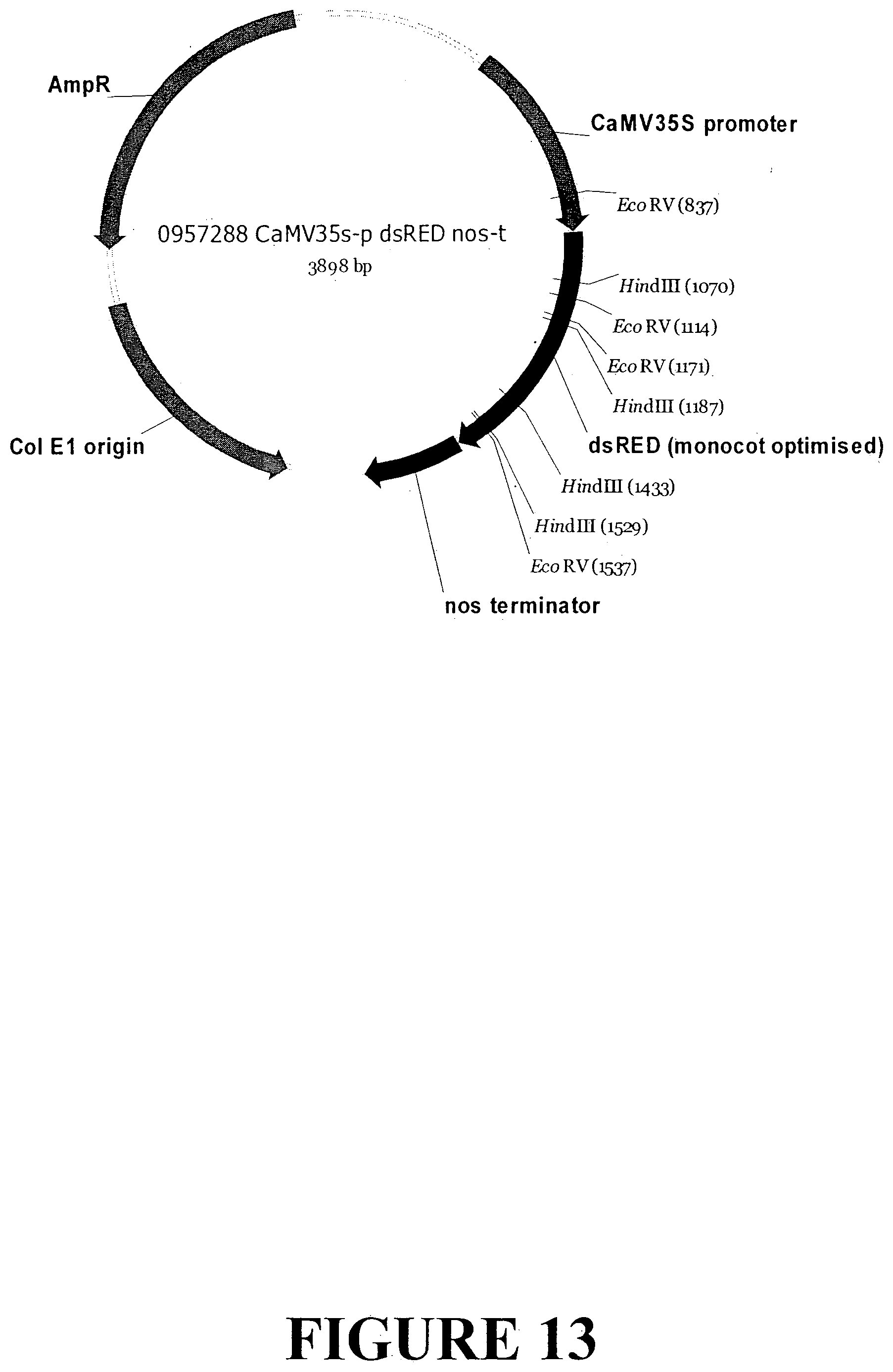
D00015
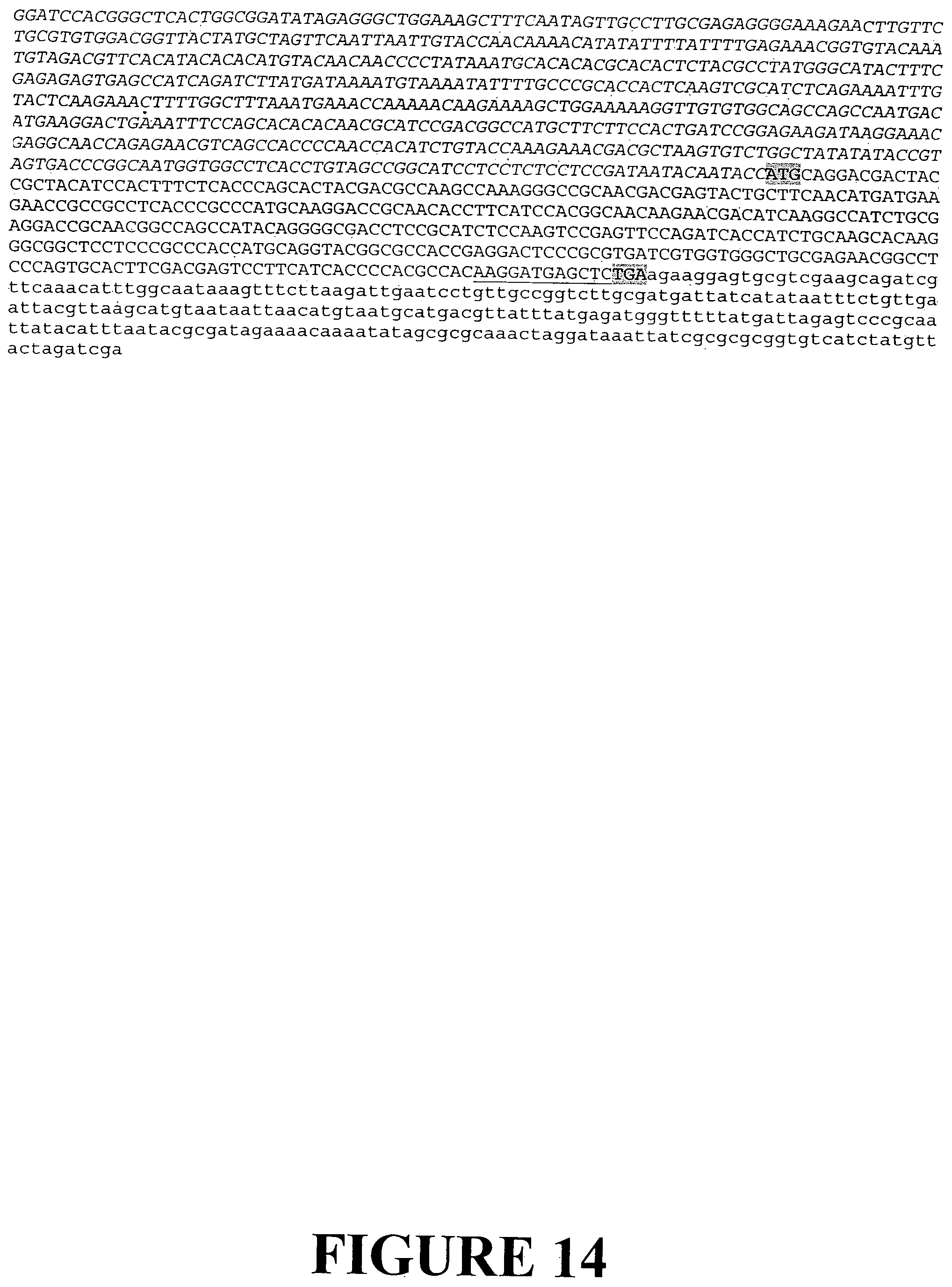
D00016
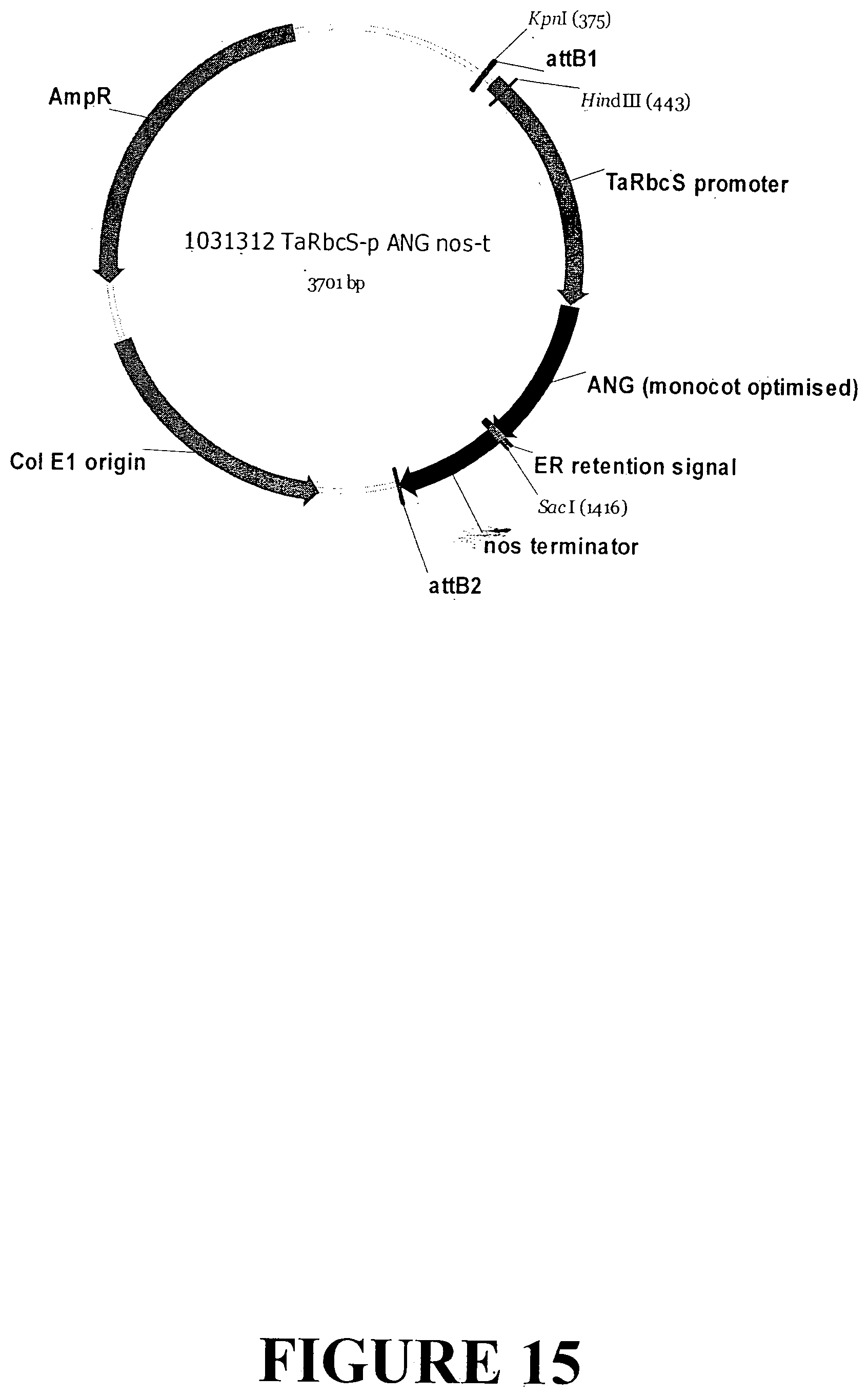
D00017
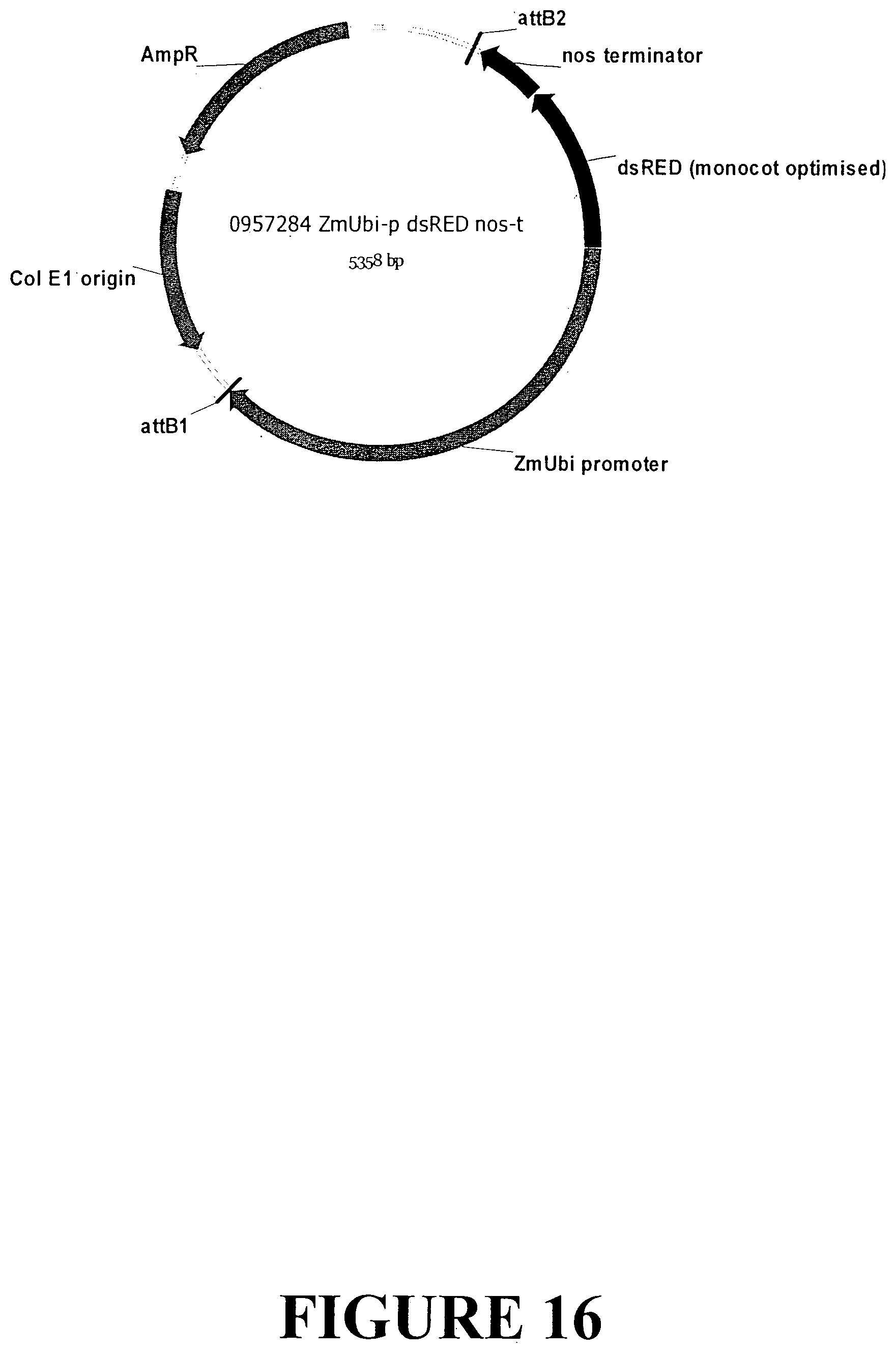
D00018
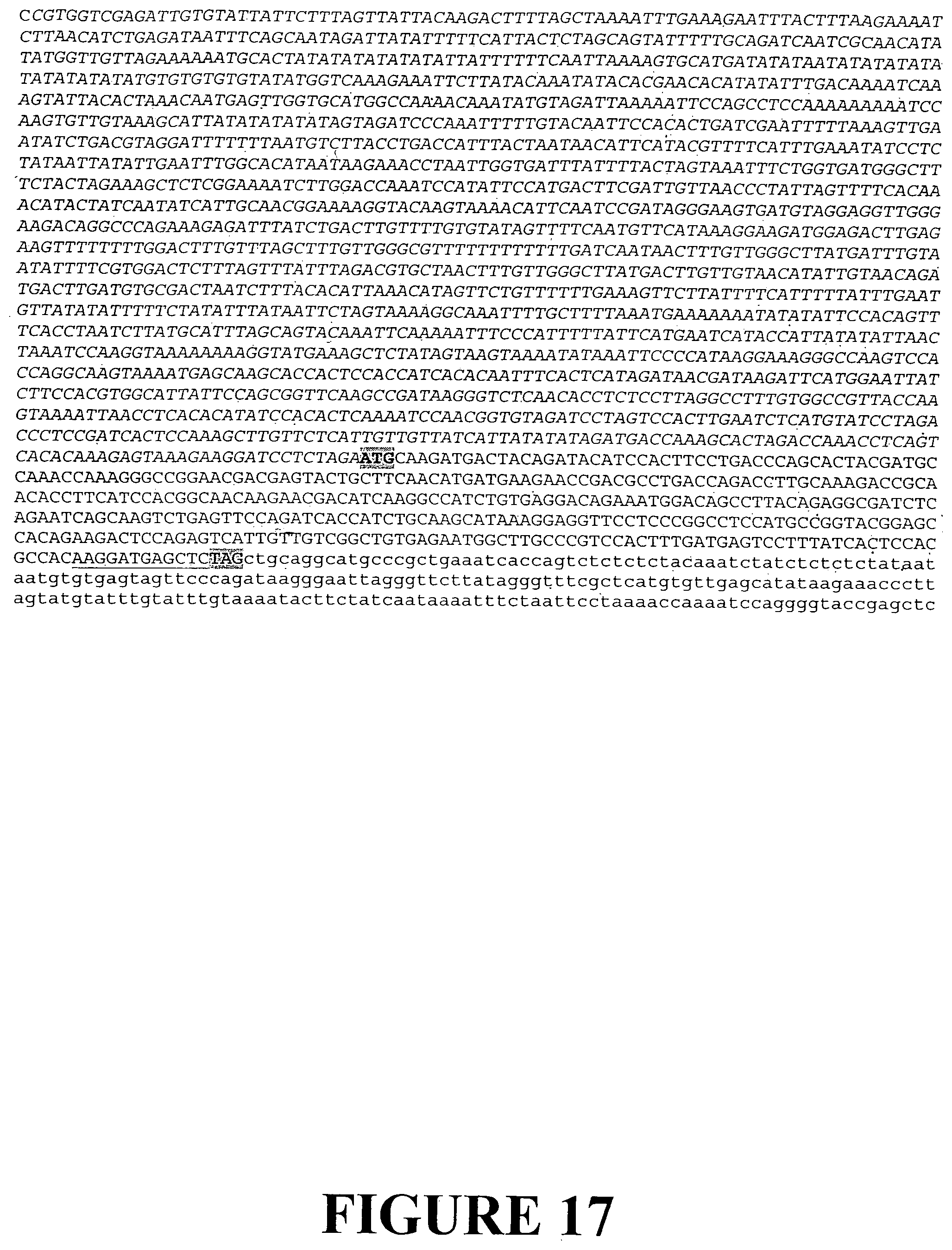
D00019
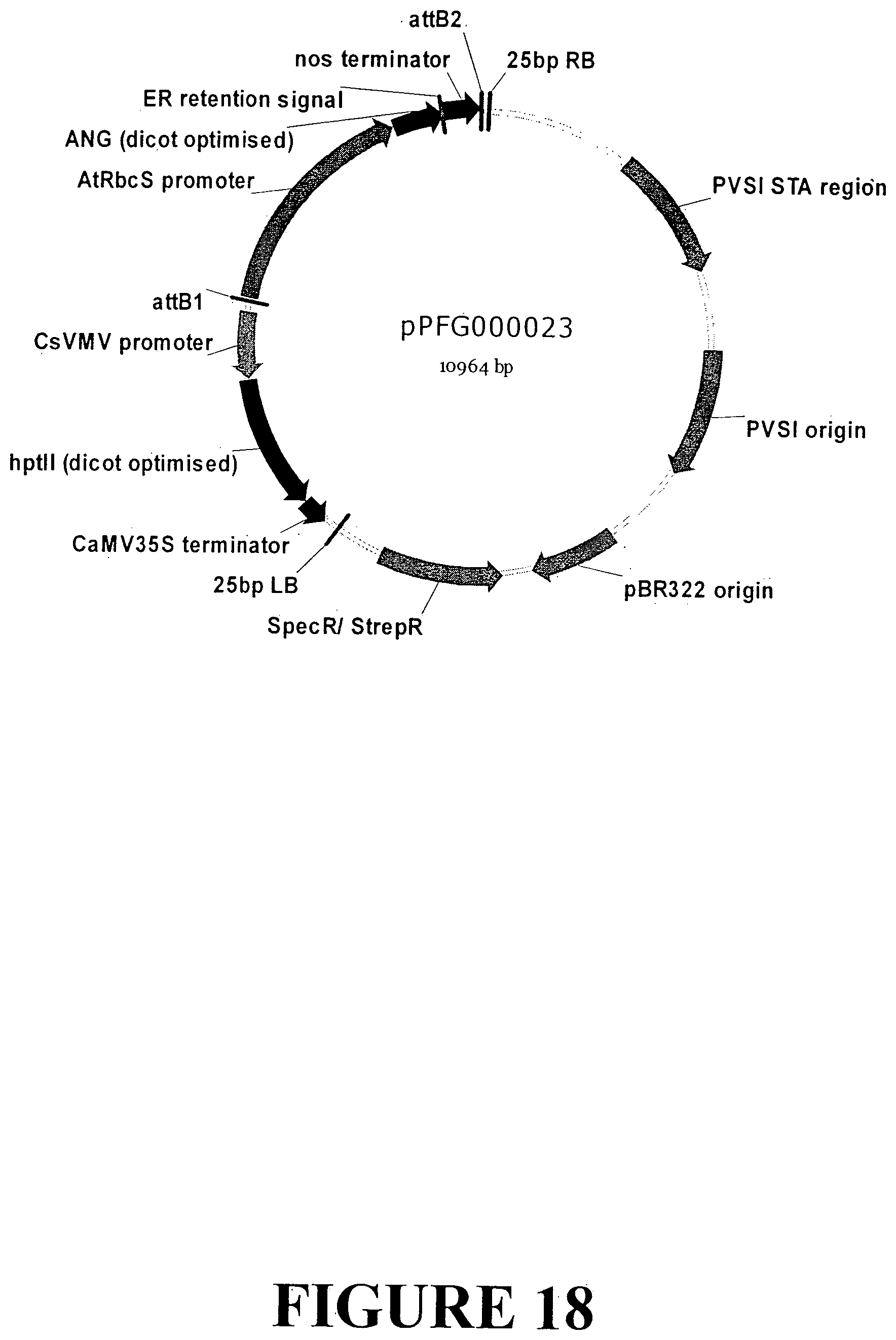
D00020
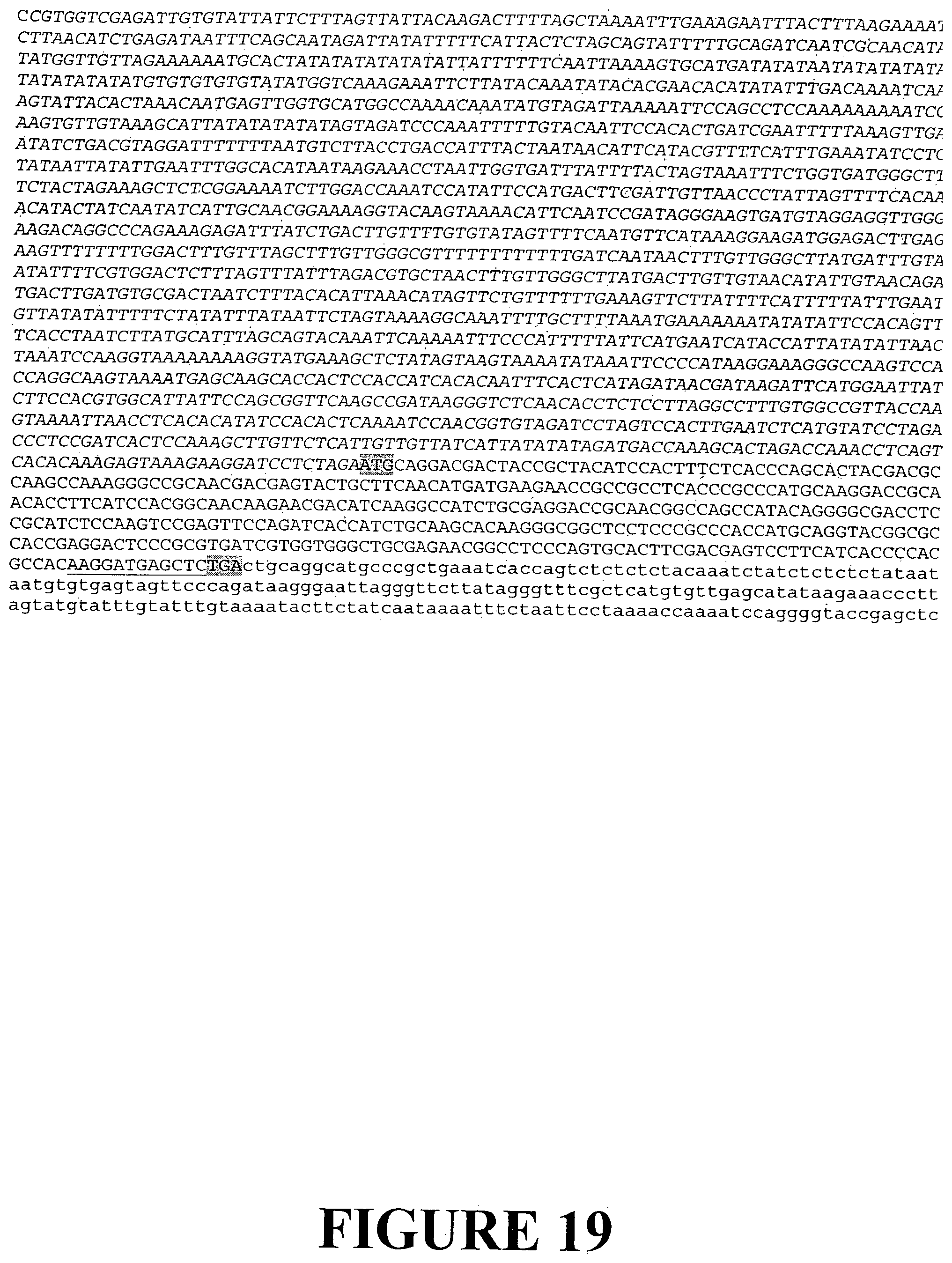
D00021
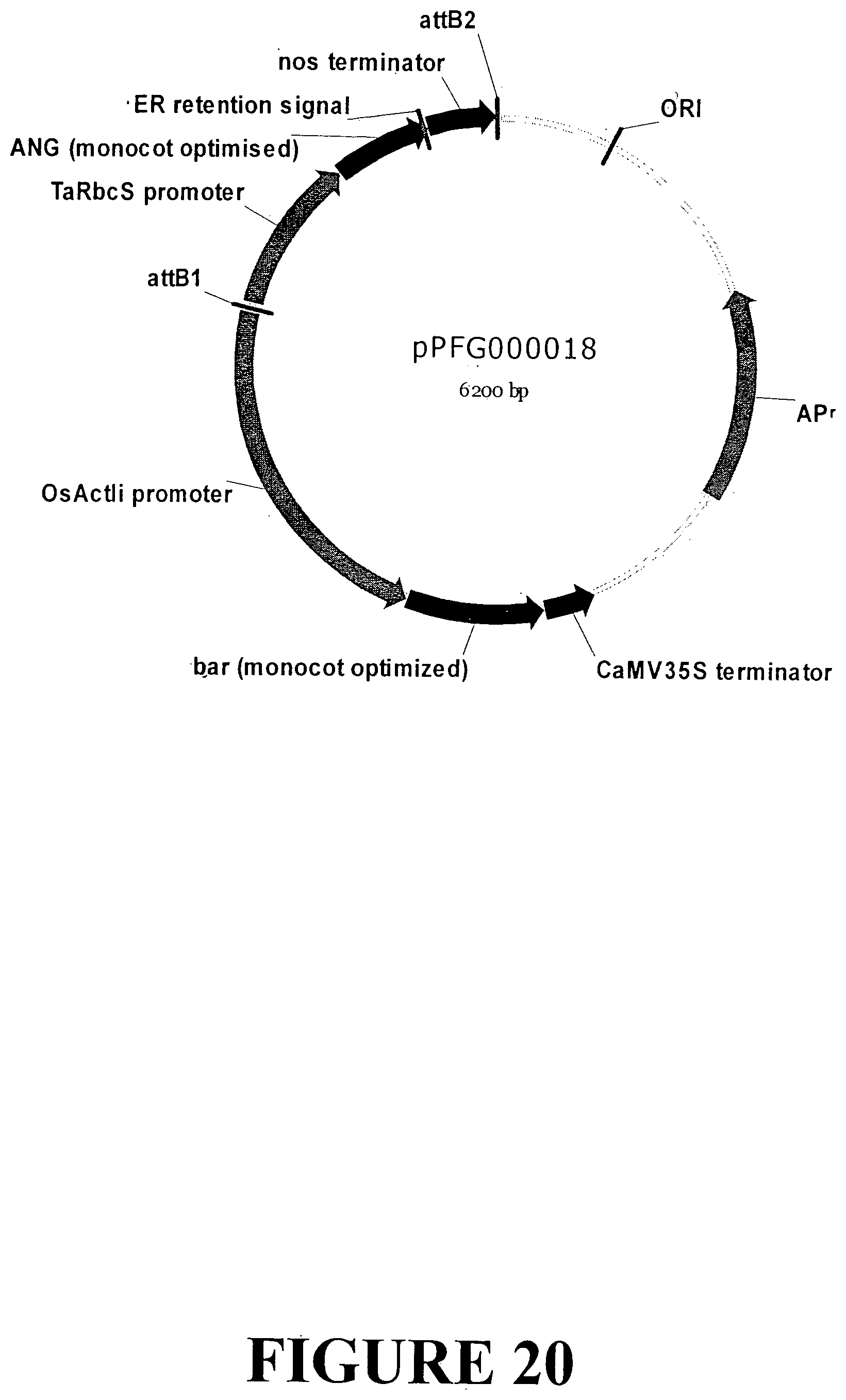
D00022
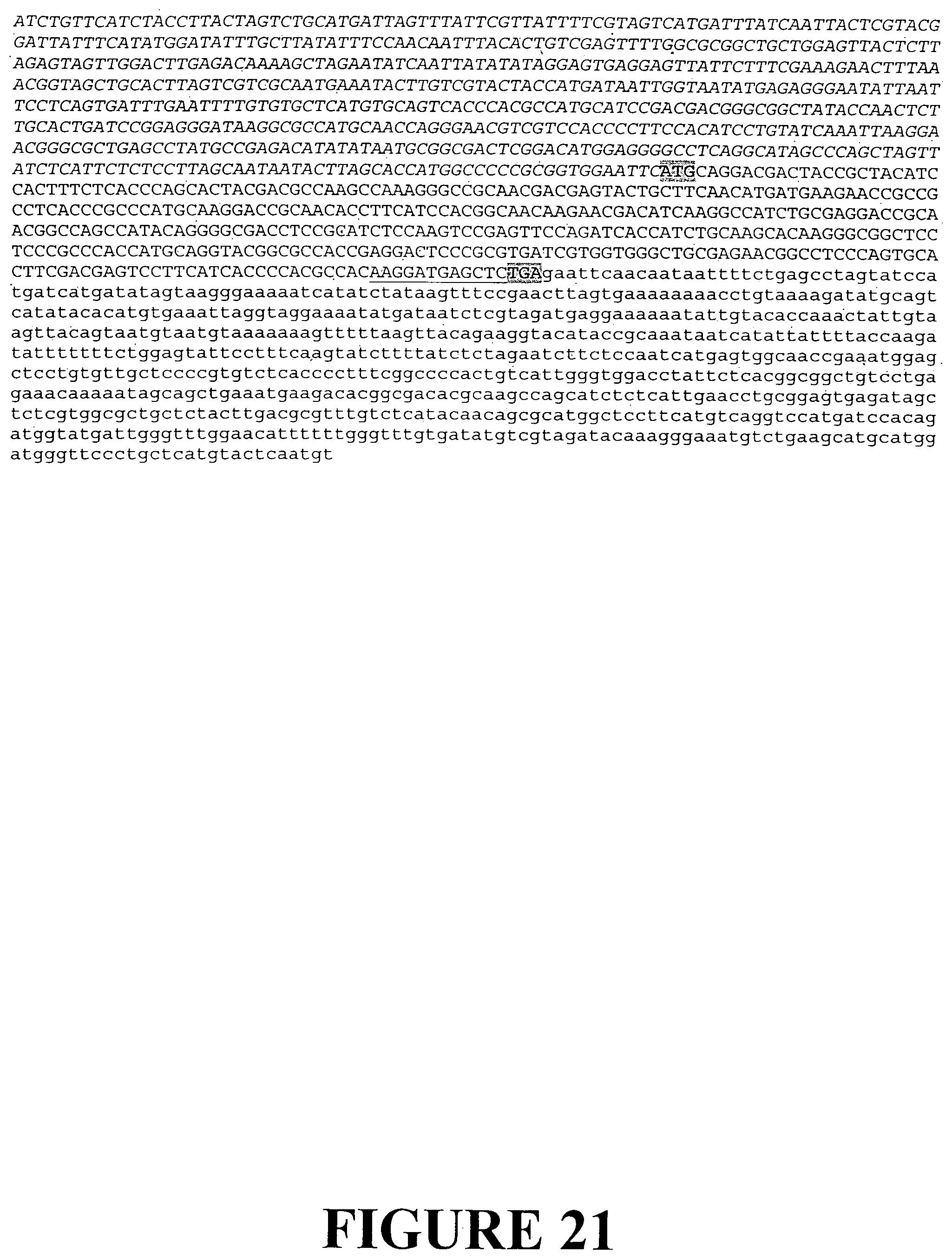
D00023
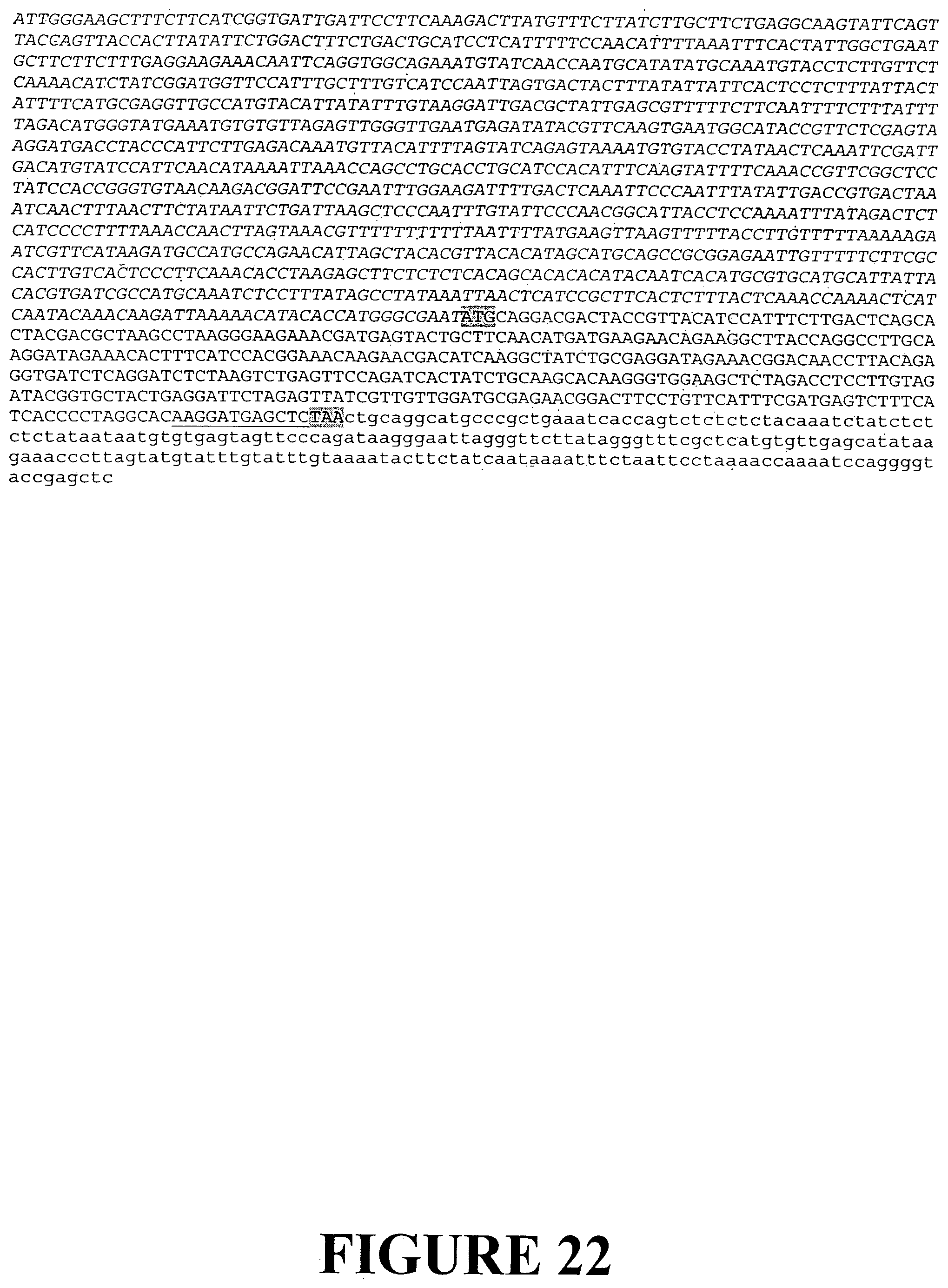
D00024
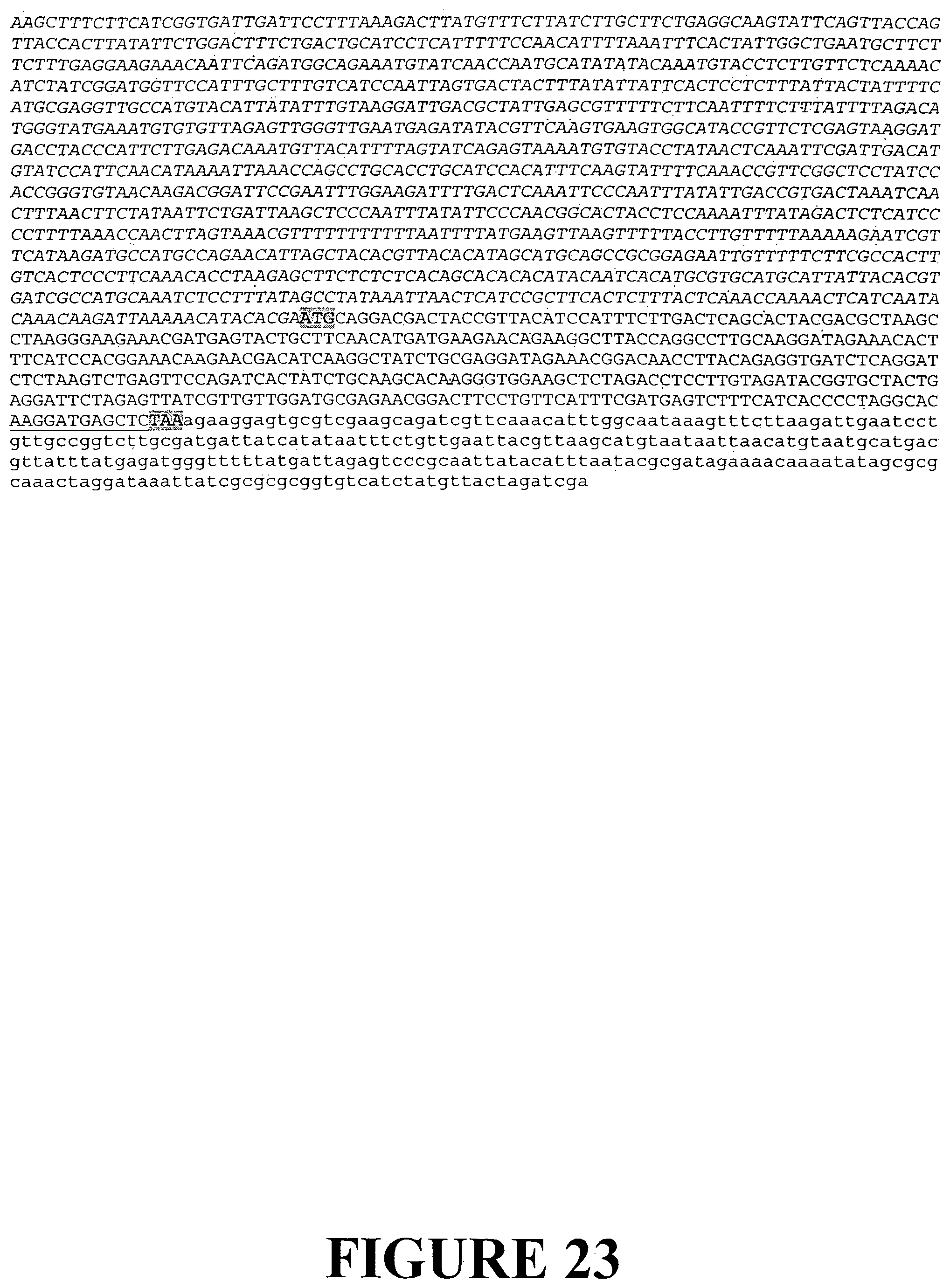
D00025
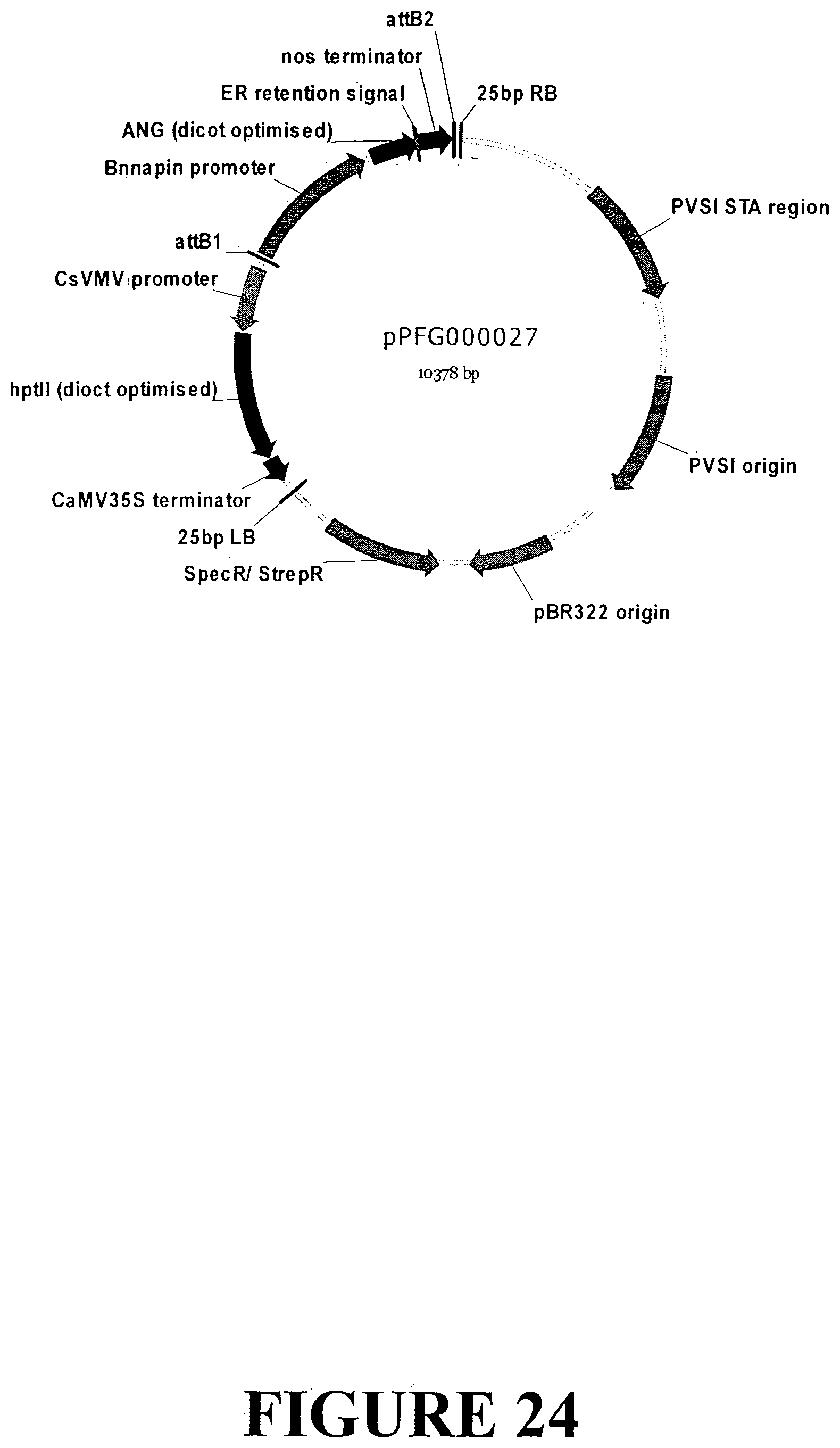
D00026
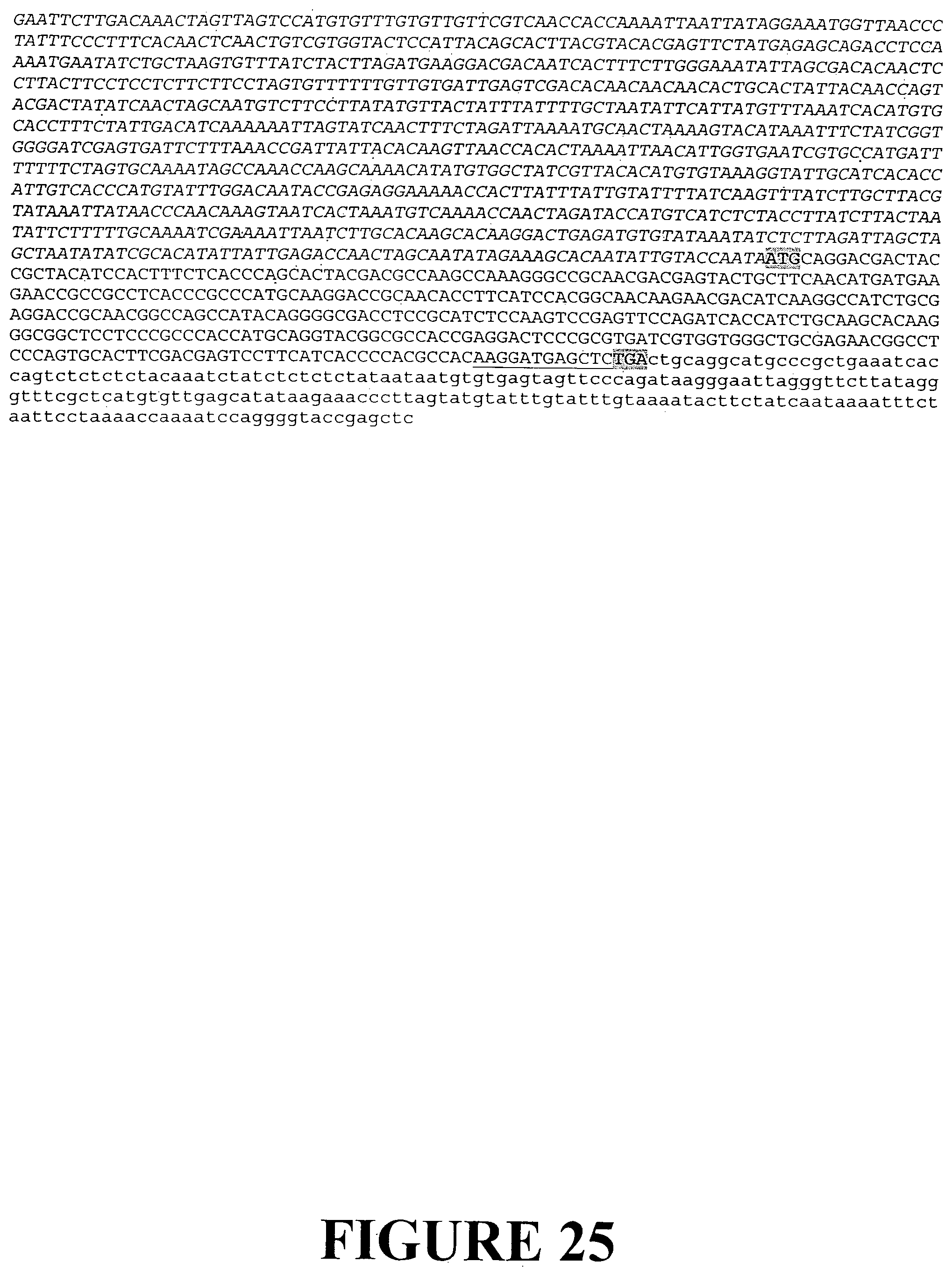
D00027
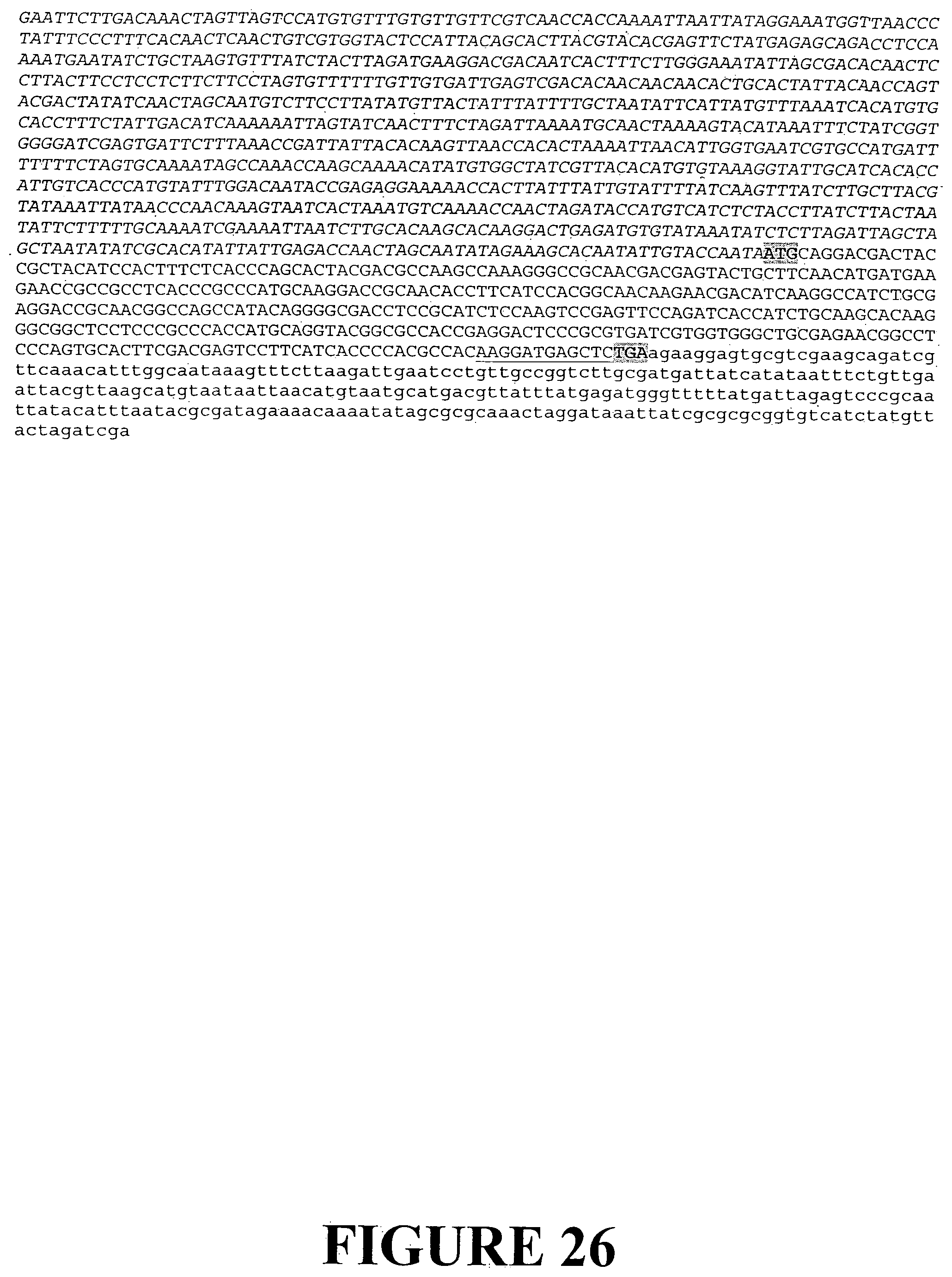
D00028
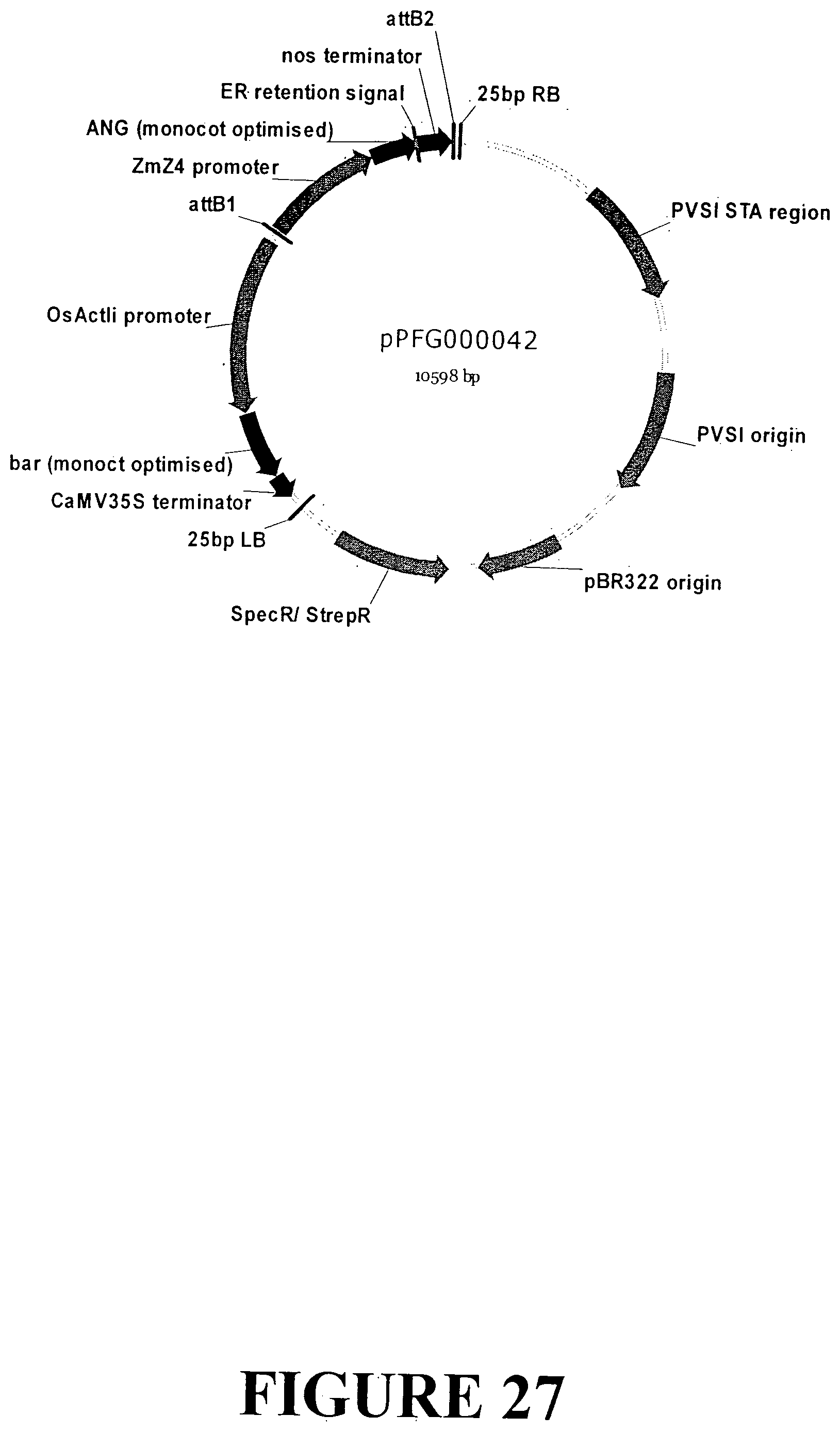
D00029
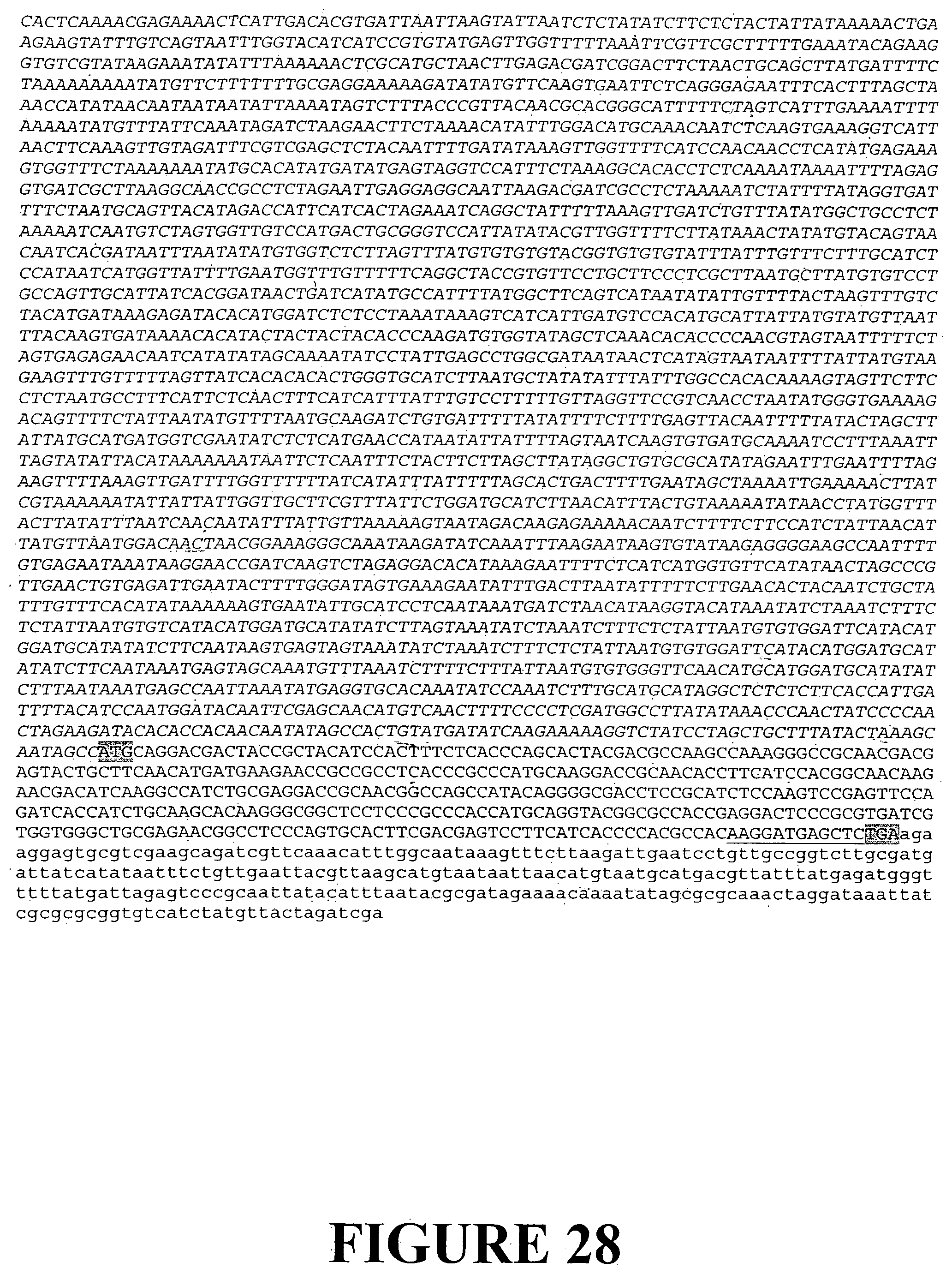
D00030
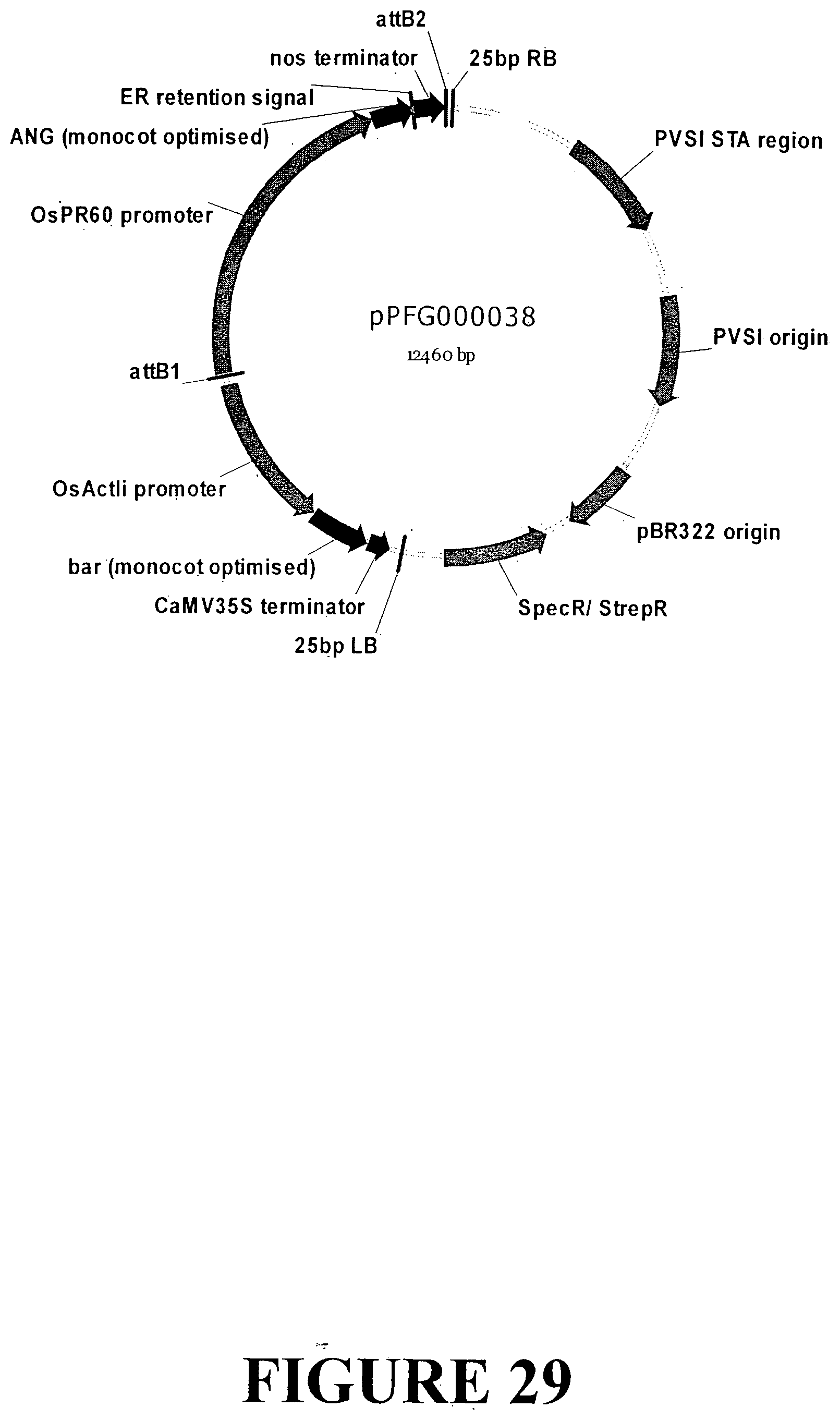
D00031

D00032
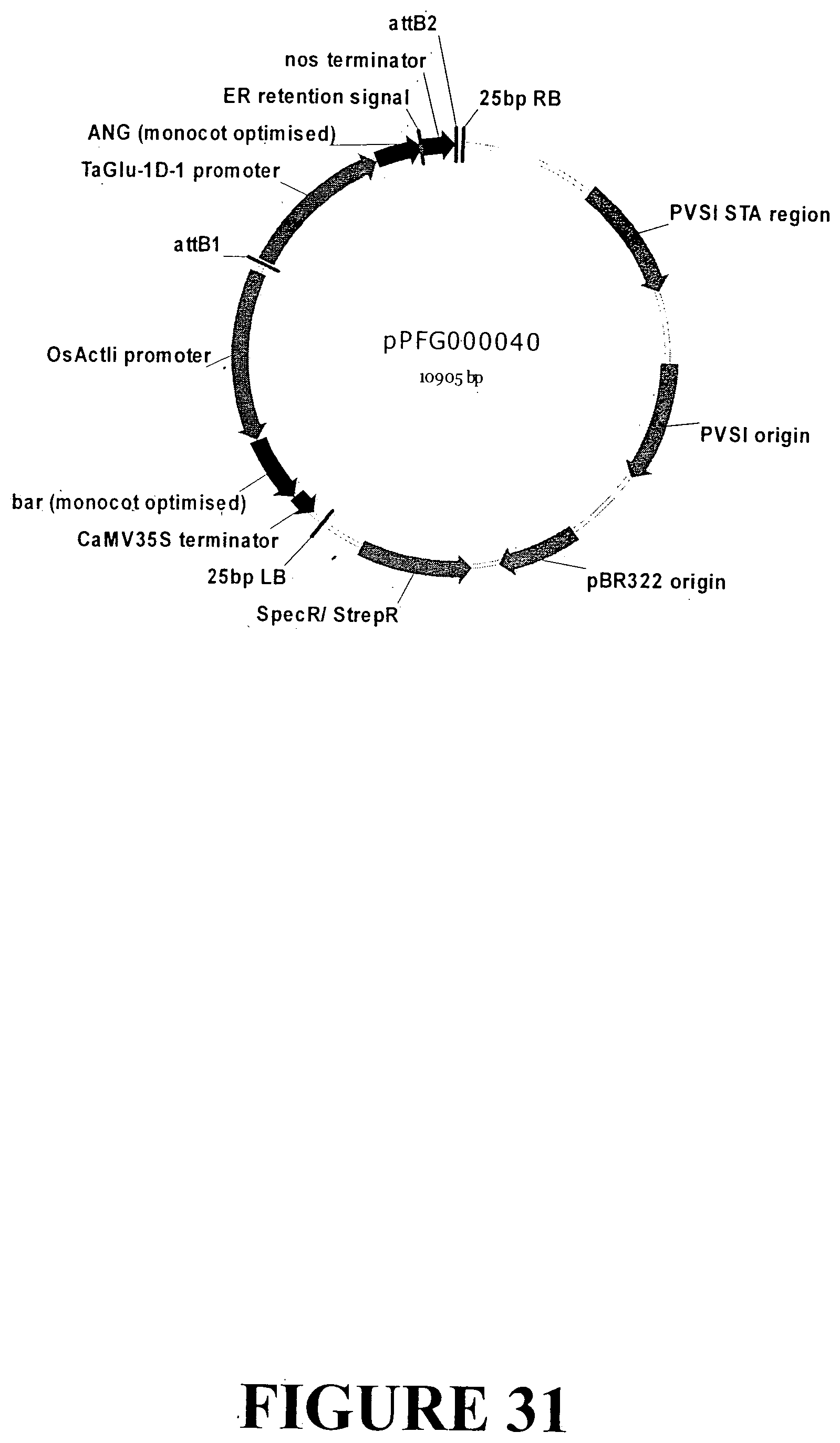
D00033
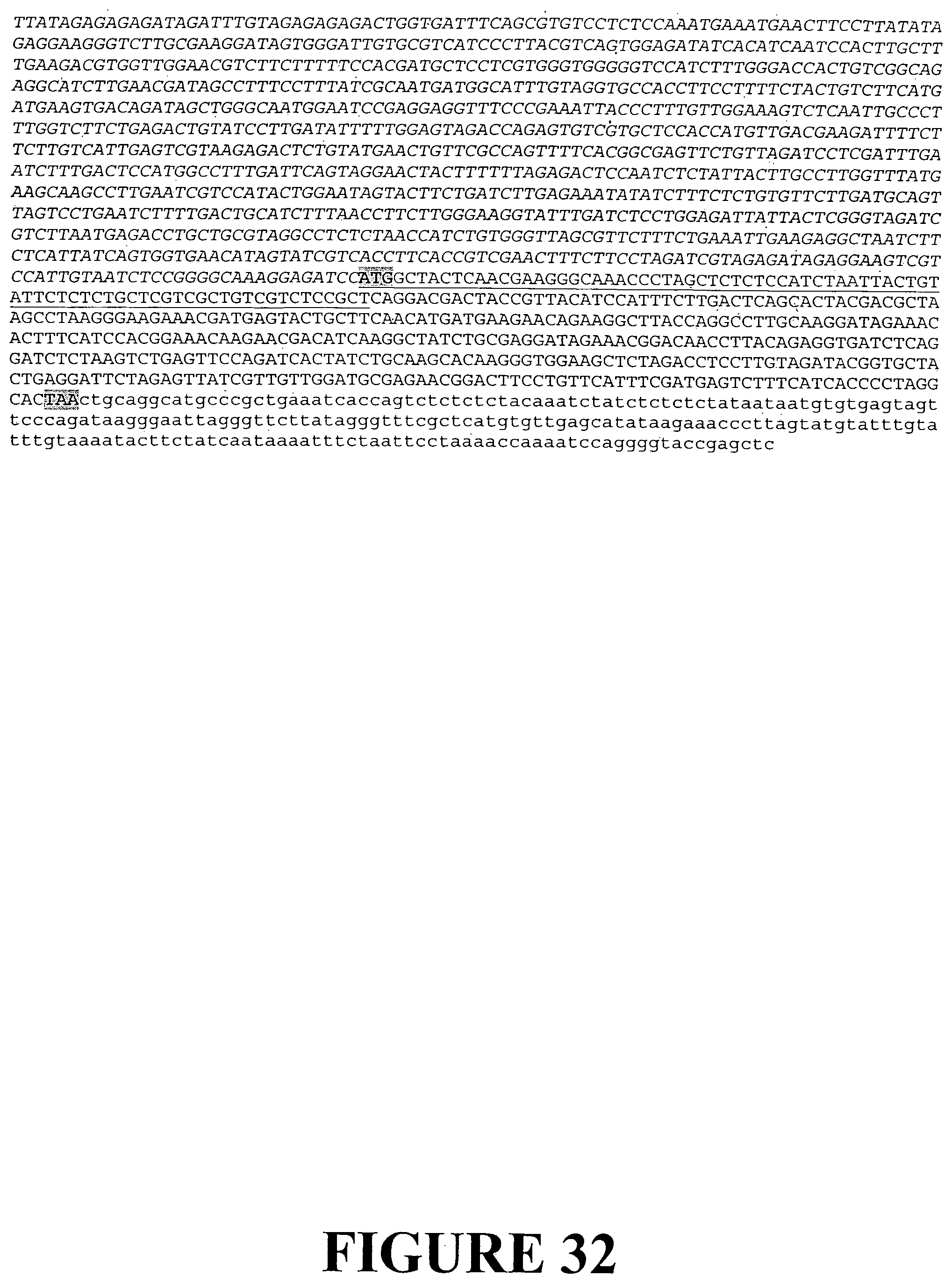
D00034
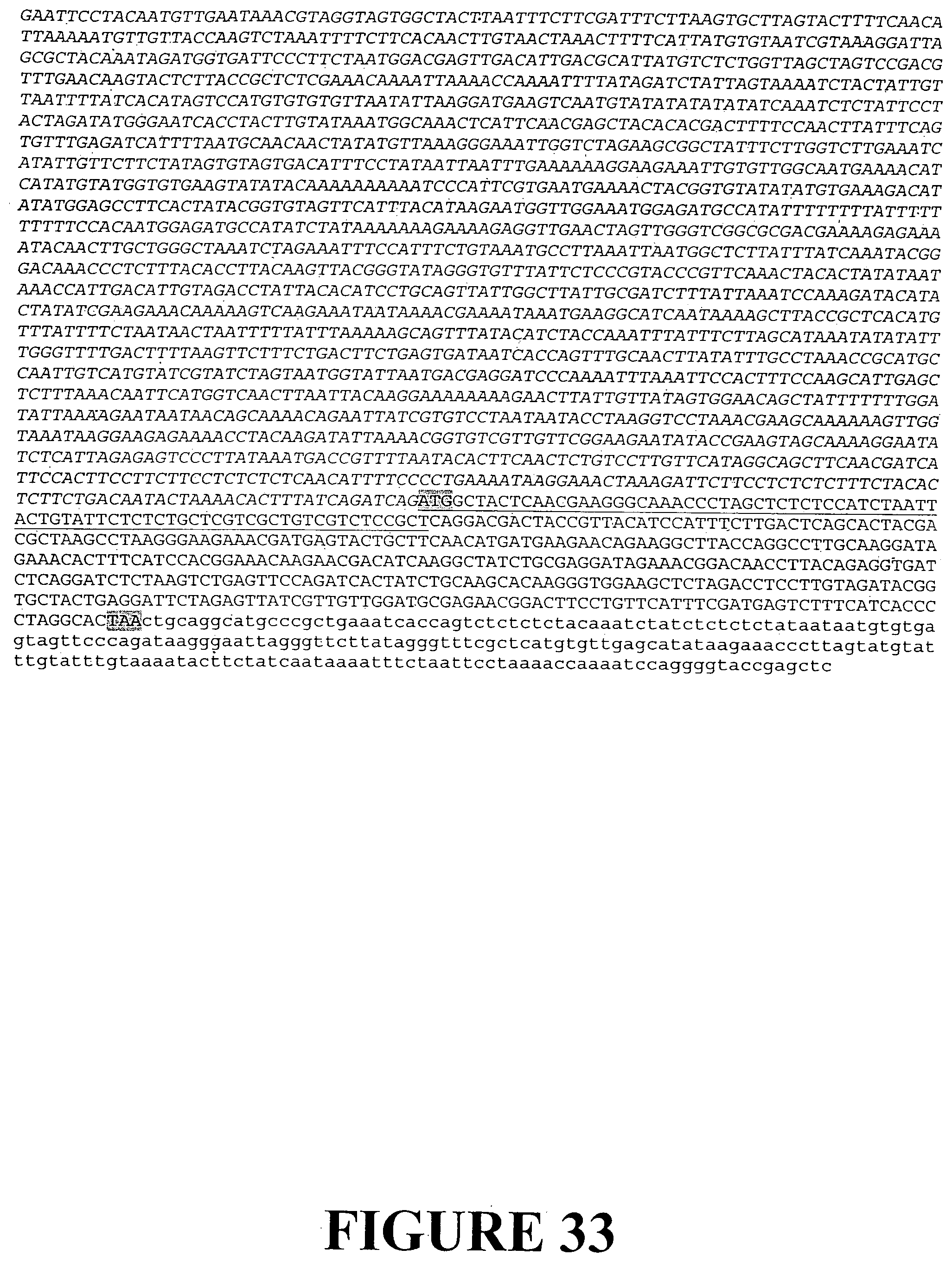
D00035

D00036
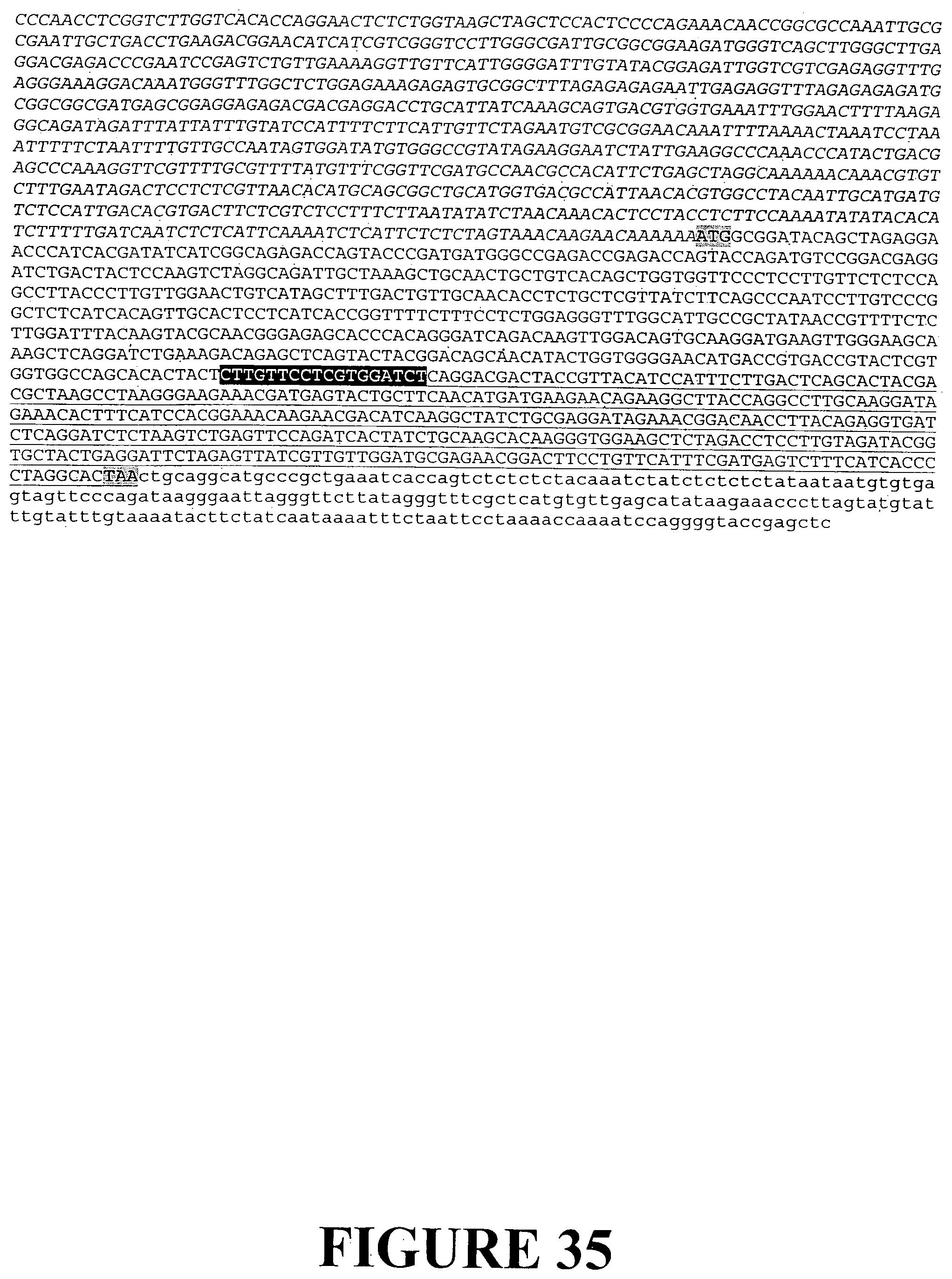
D00037
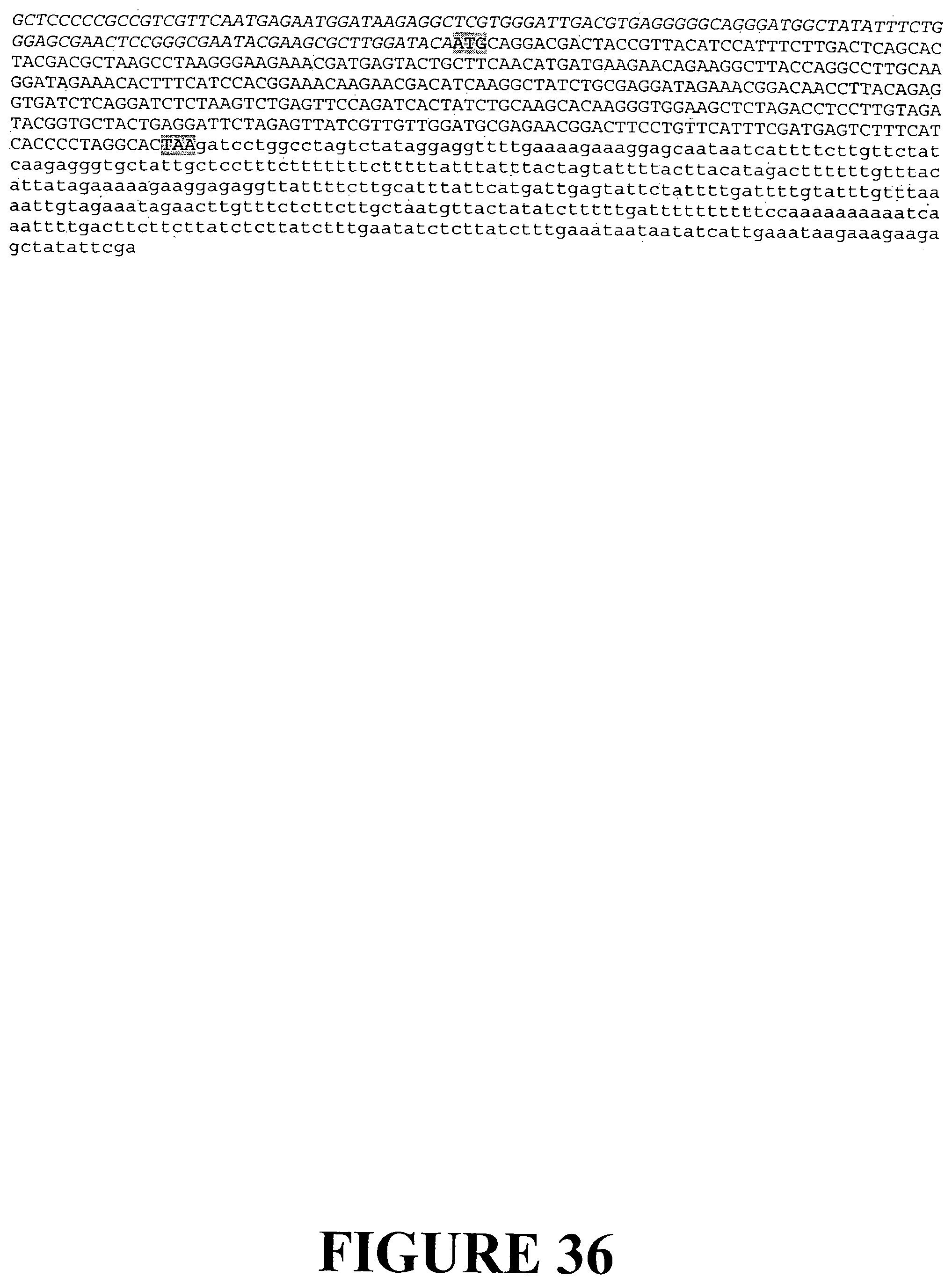
D00038
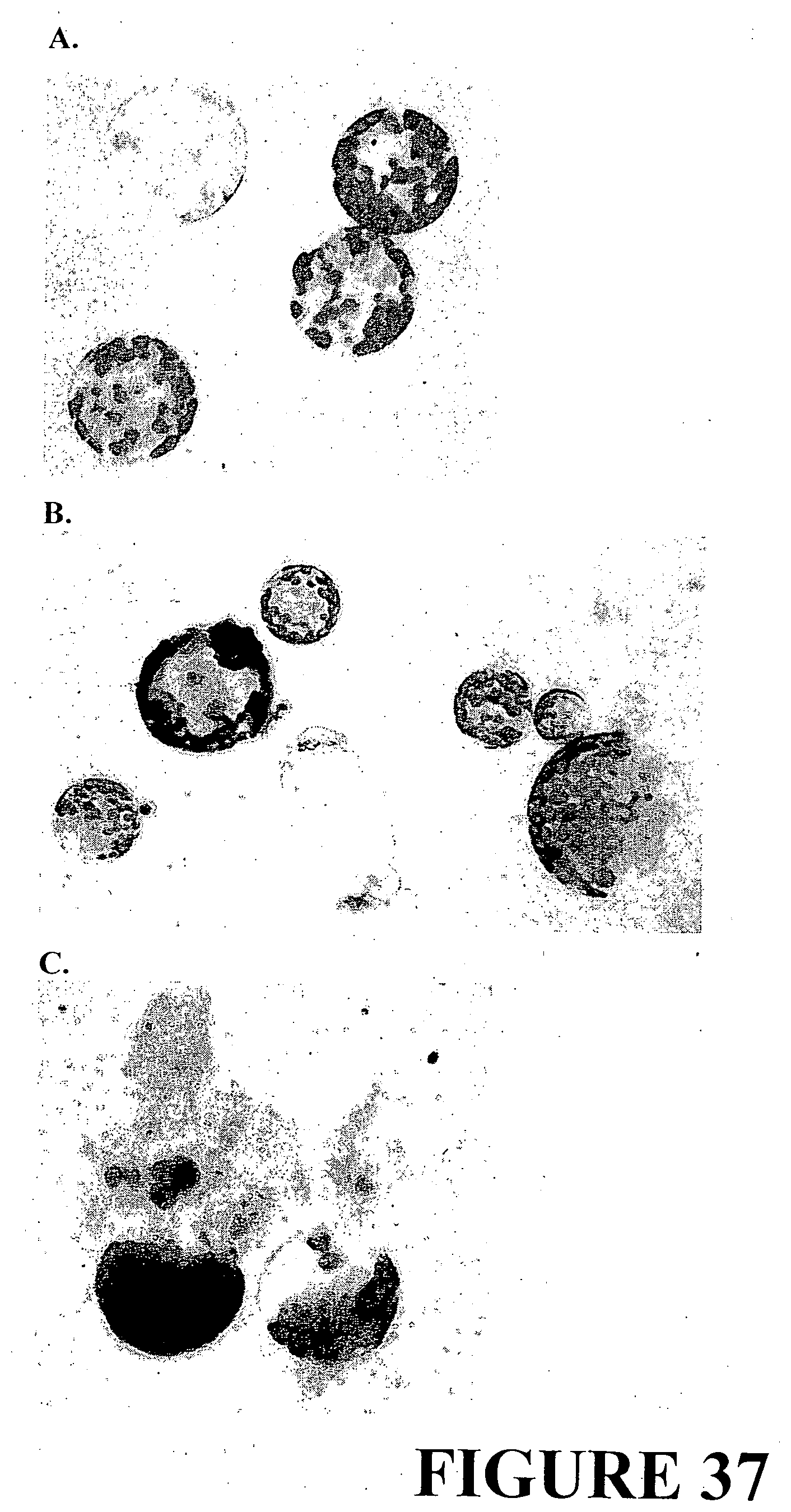
D00039
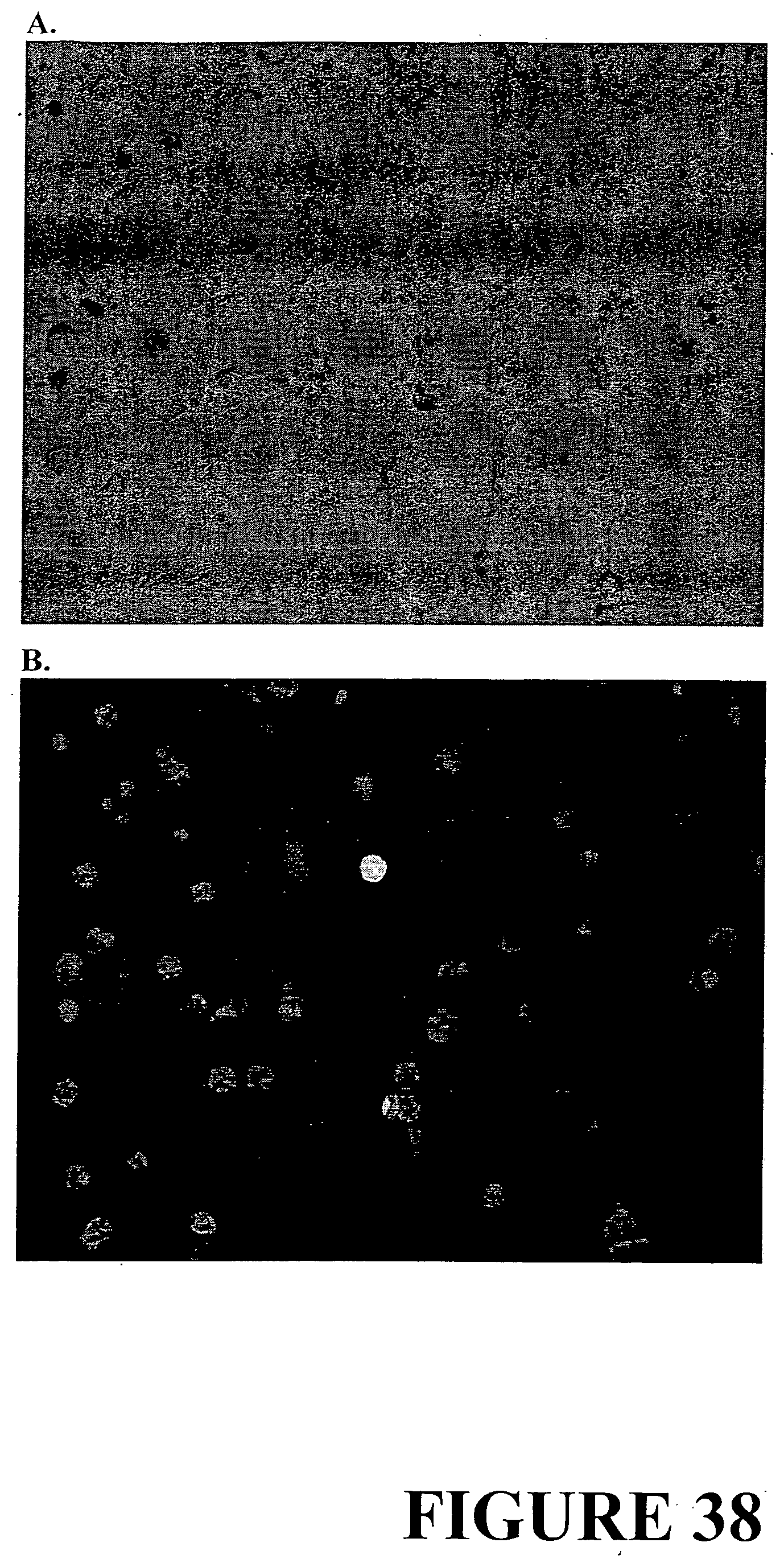
D00040
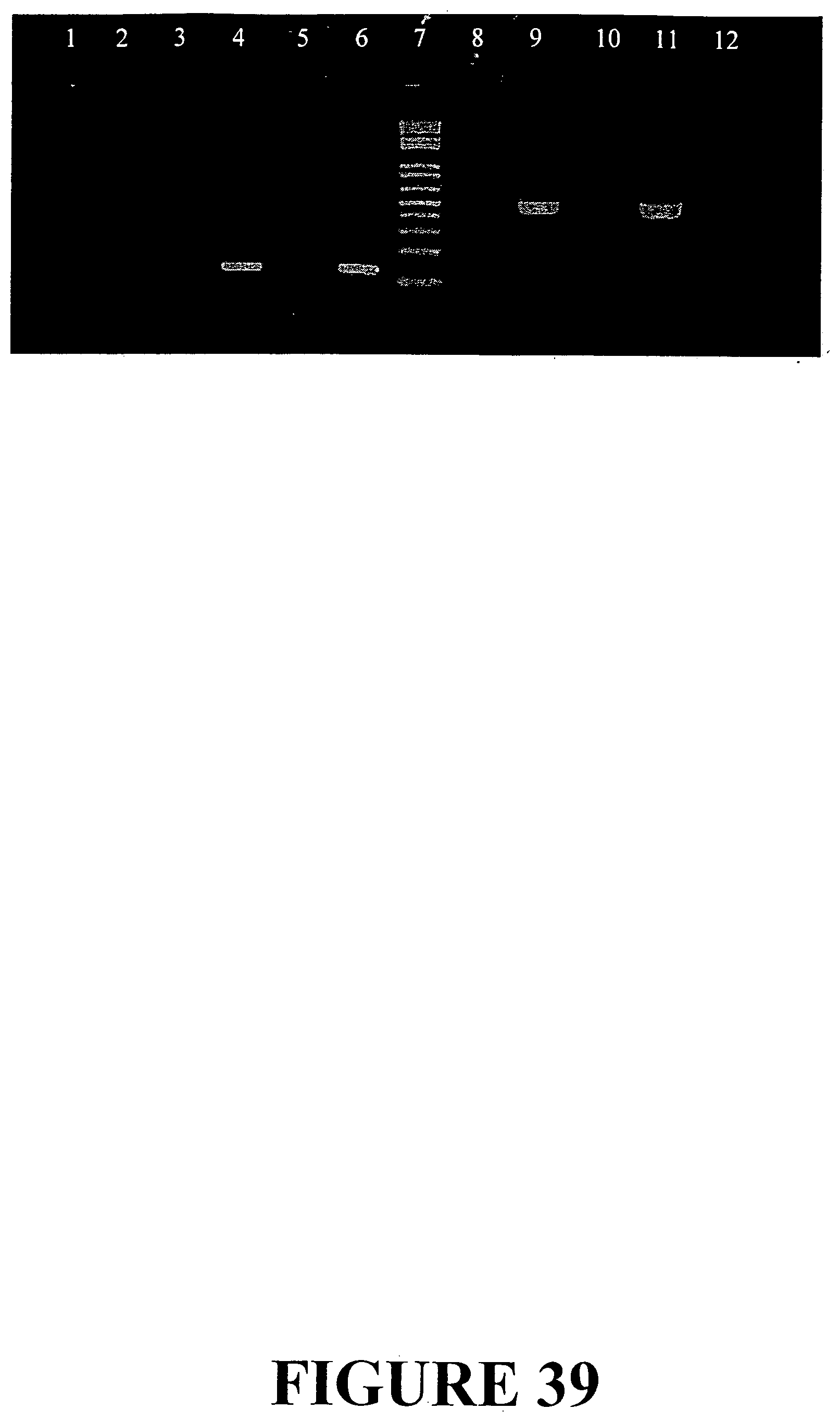
D00041
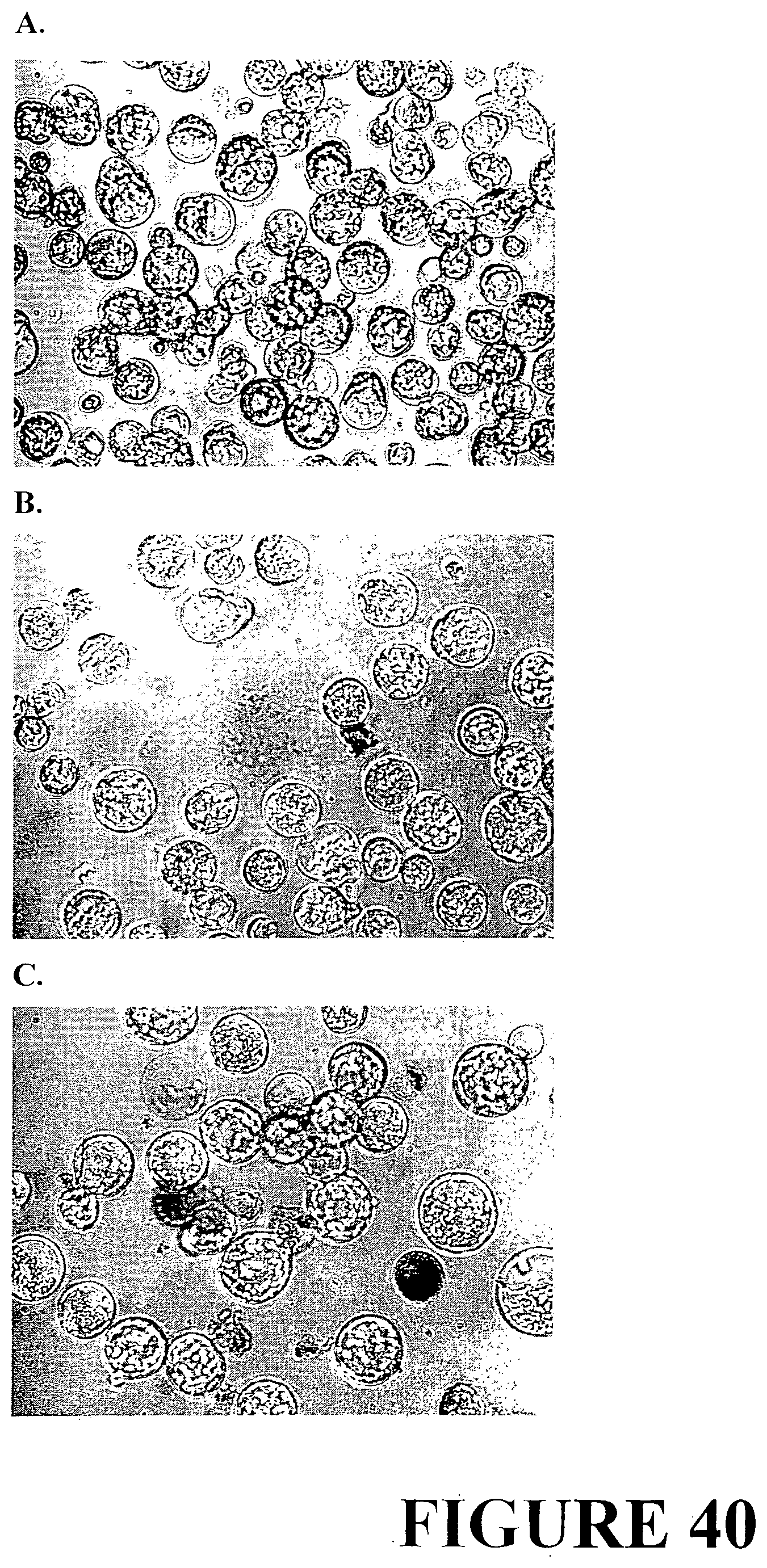
D00042
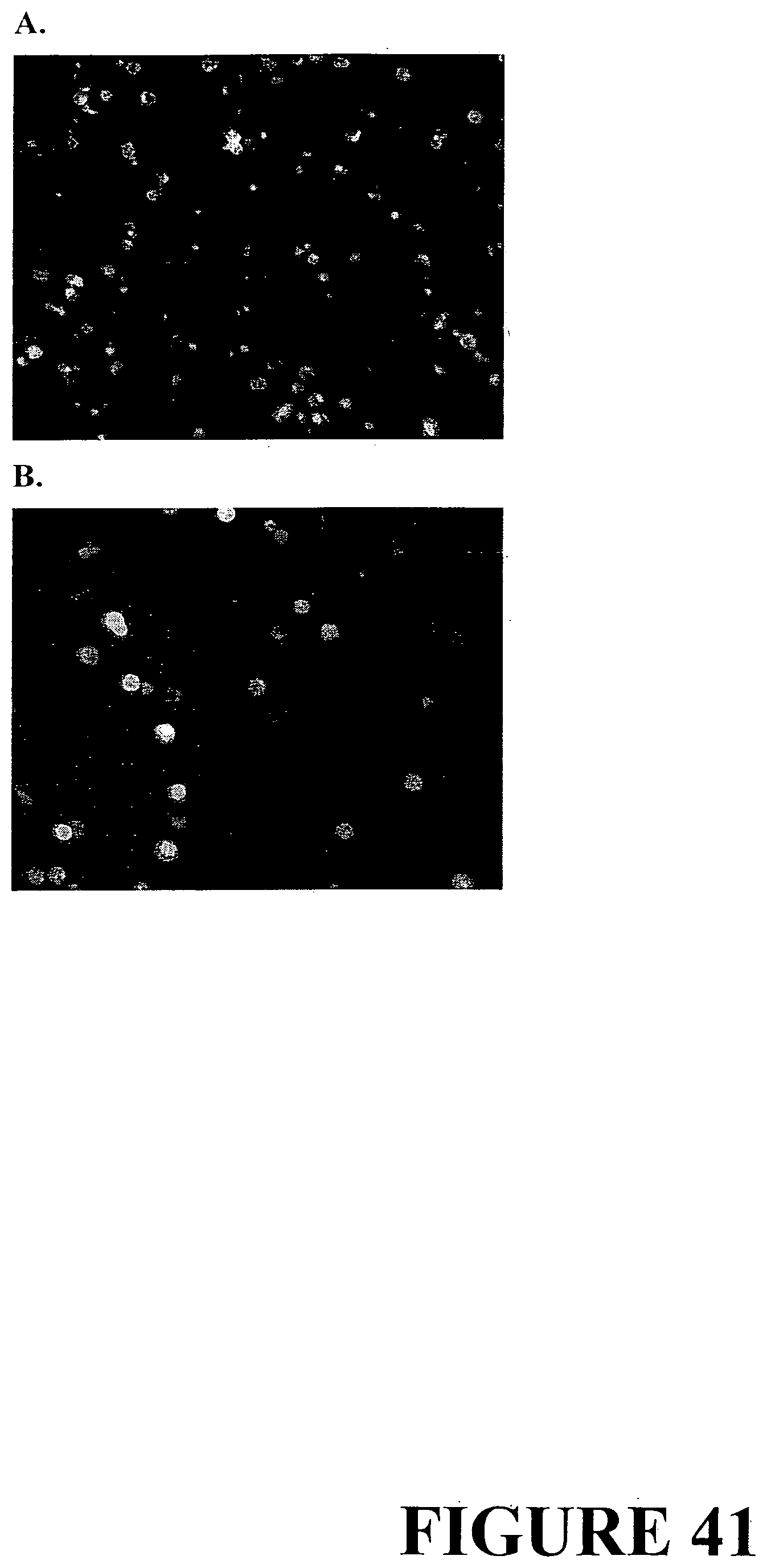
D00043
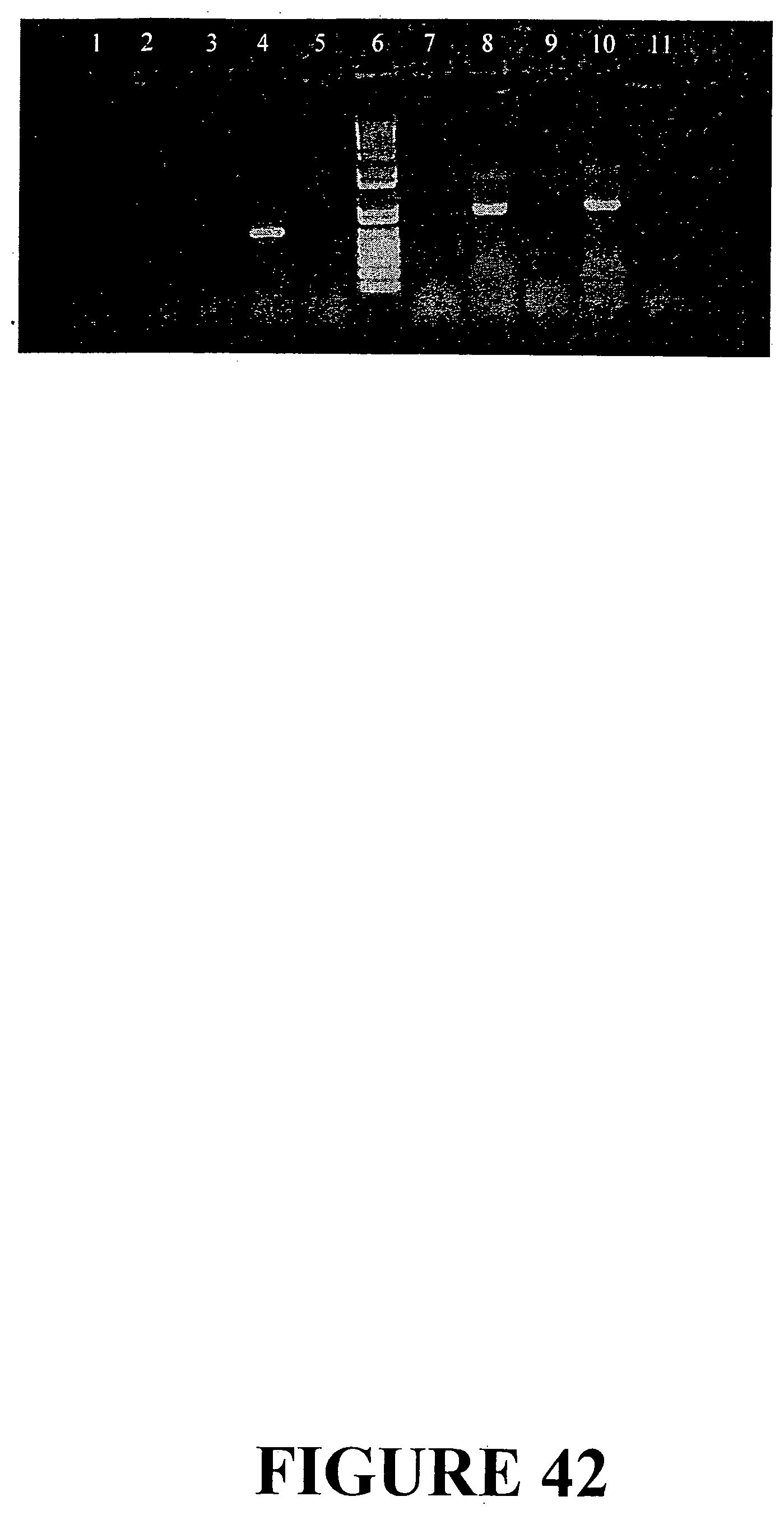
D00044
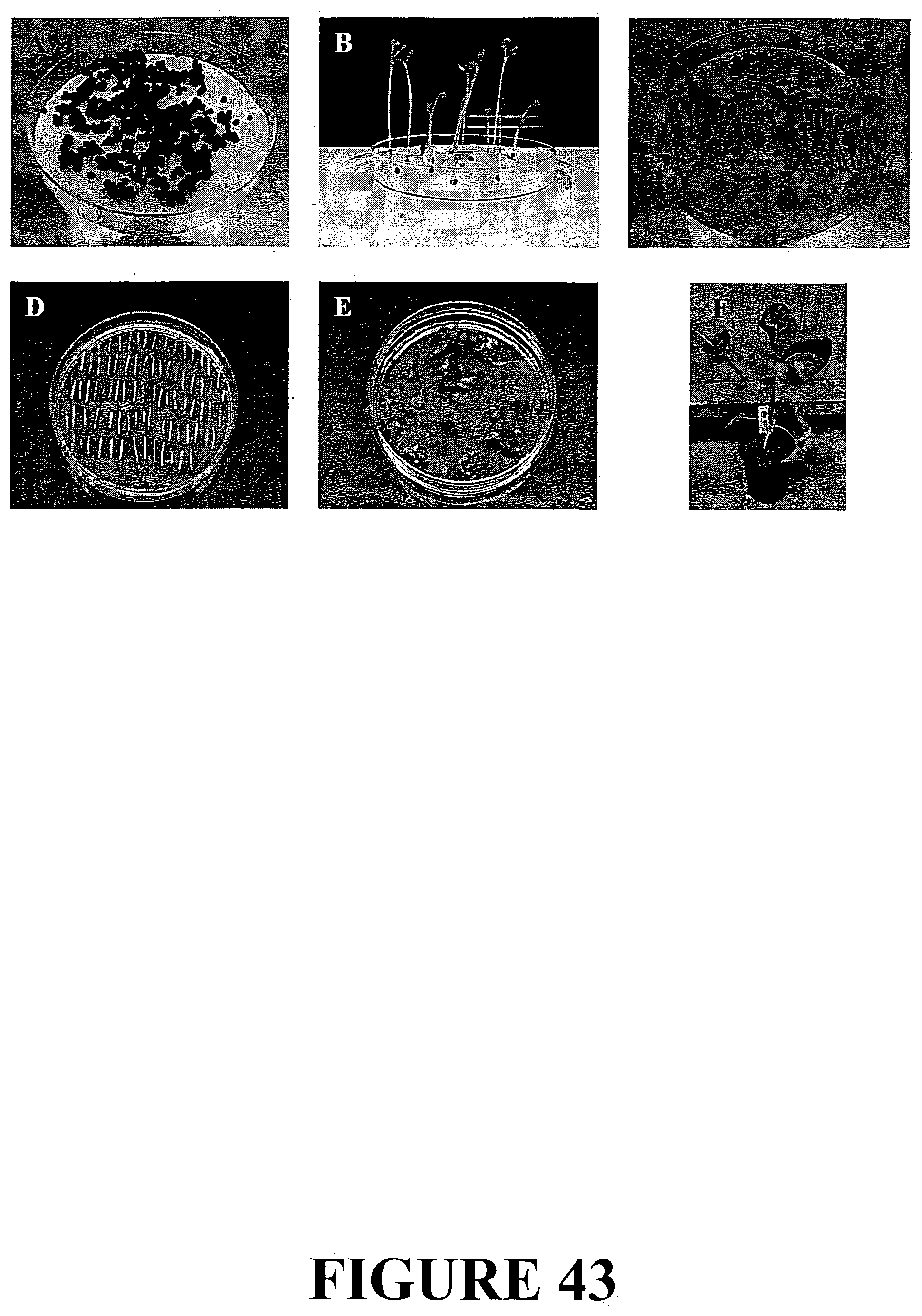
D00045
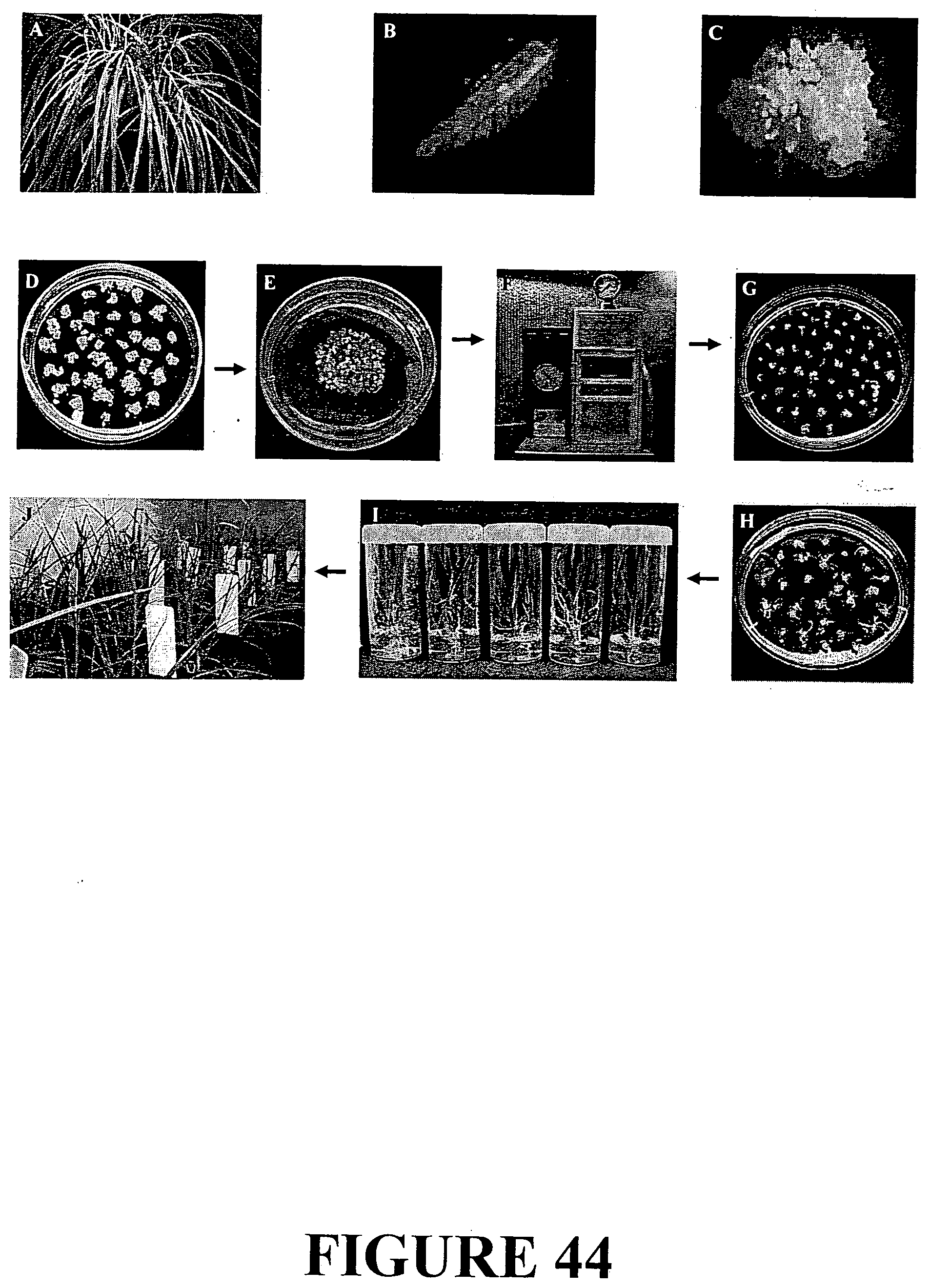
D00046
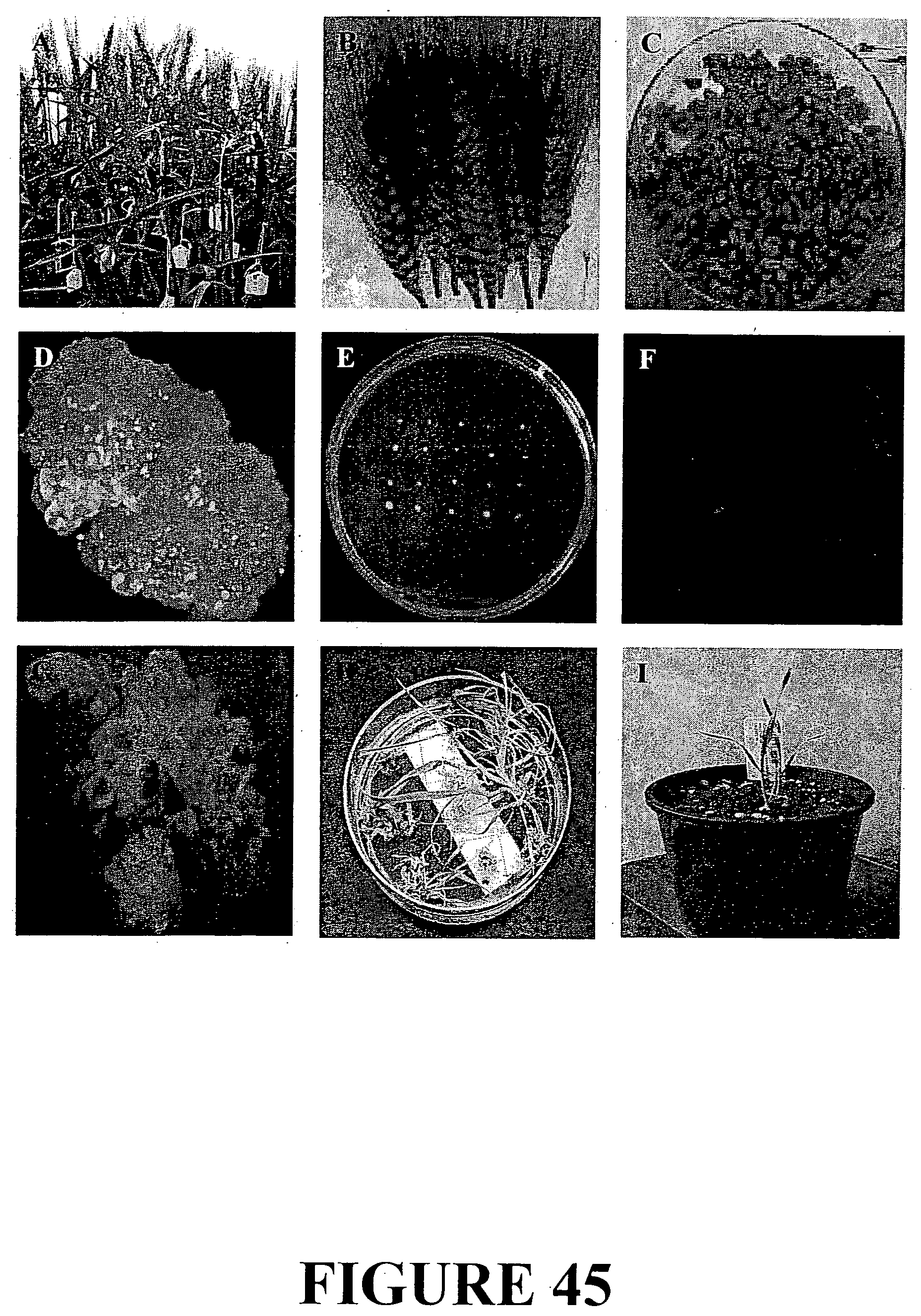
D00047
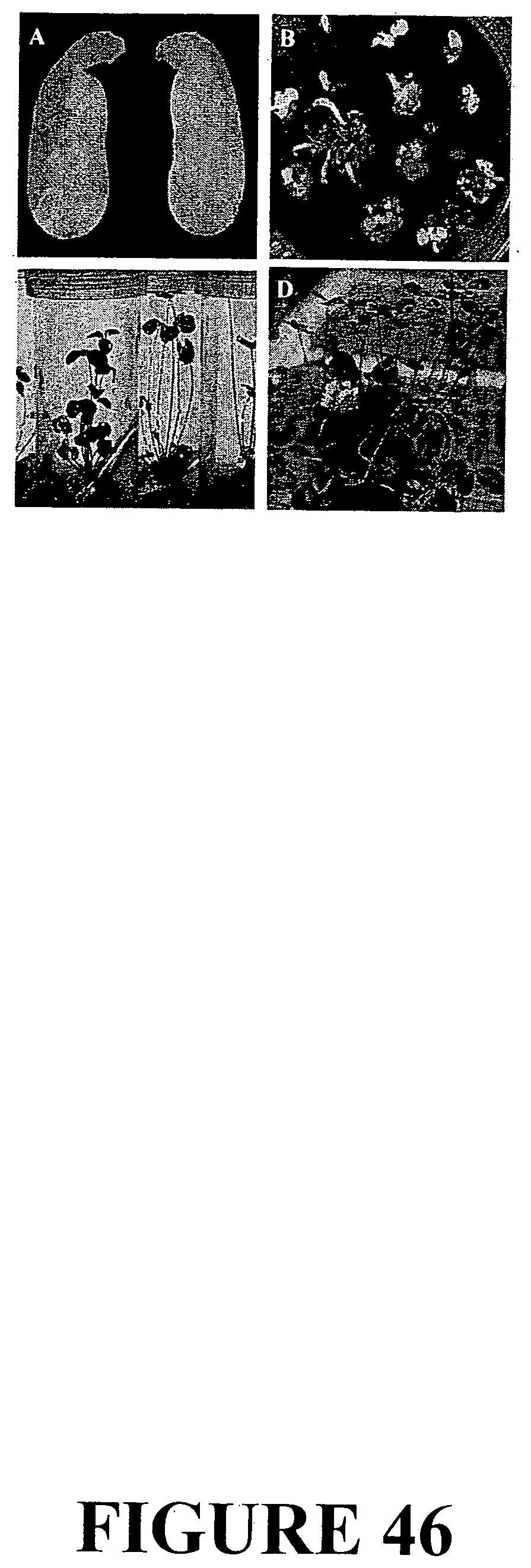
D00048
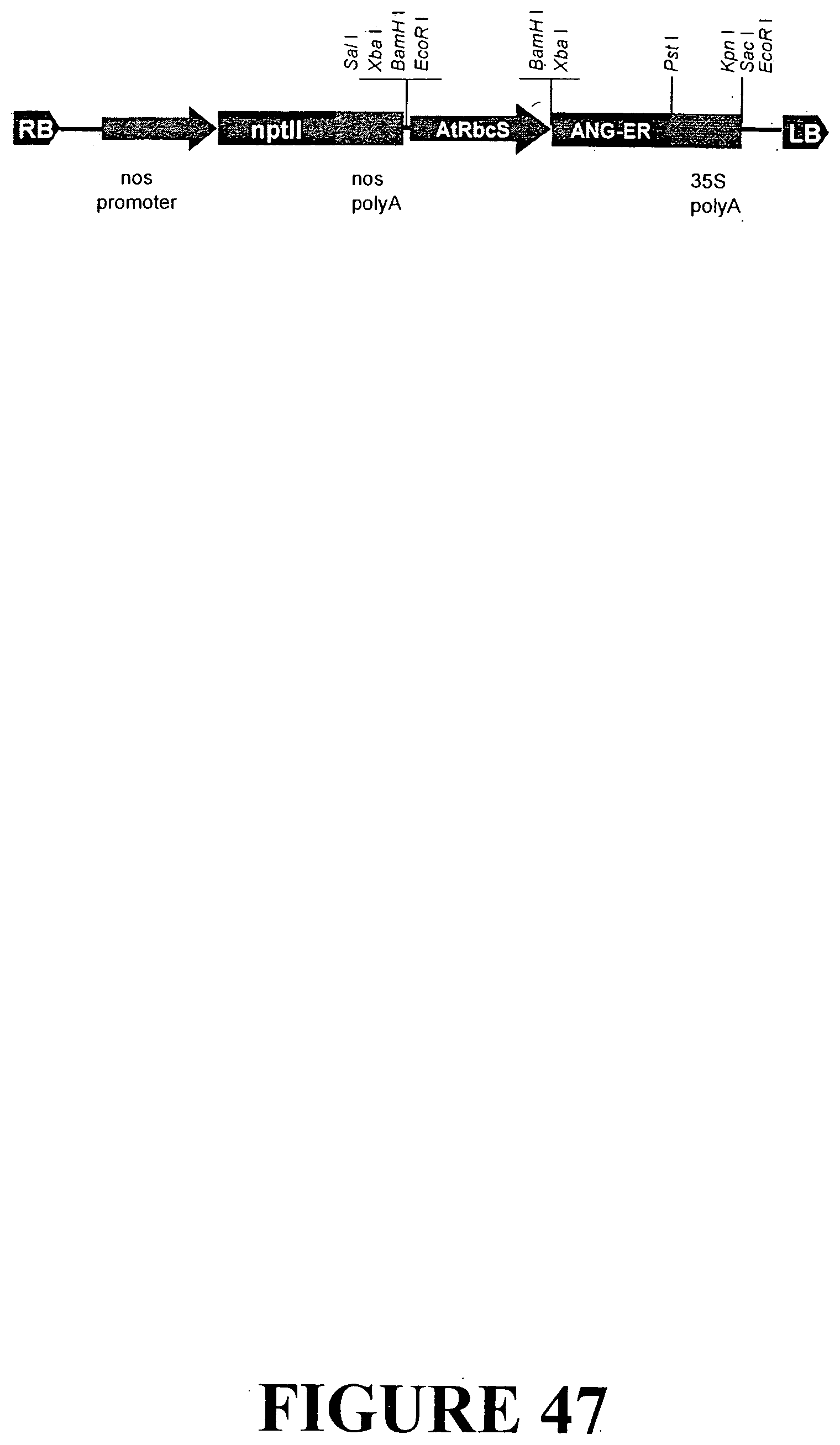
D00049

D00050
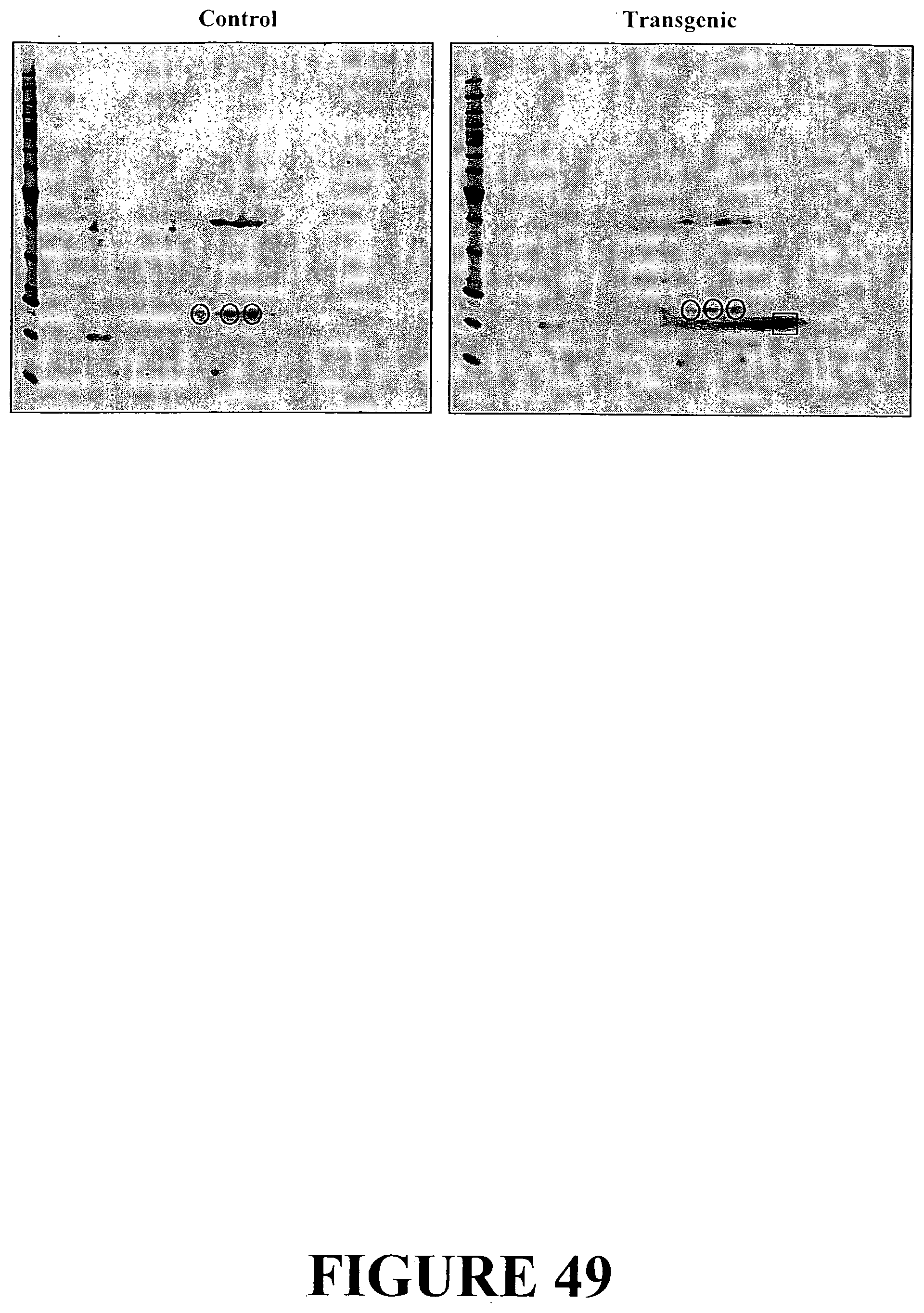
D00051
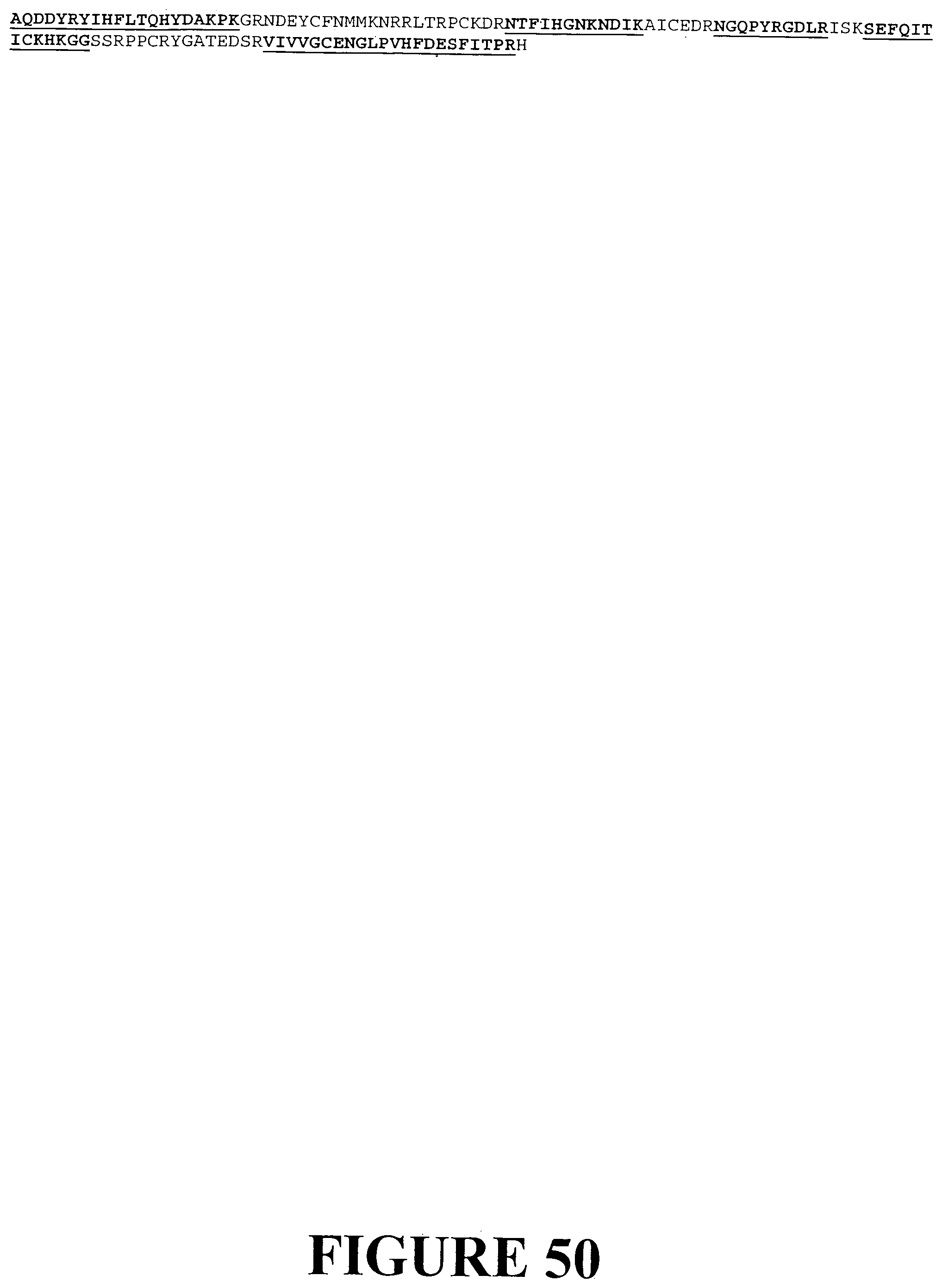
D00052
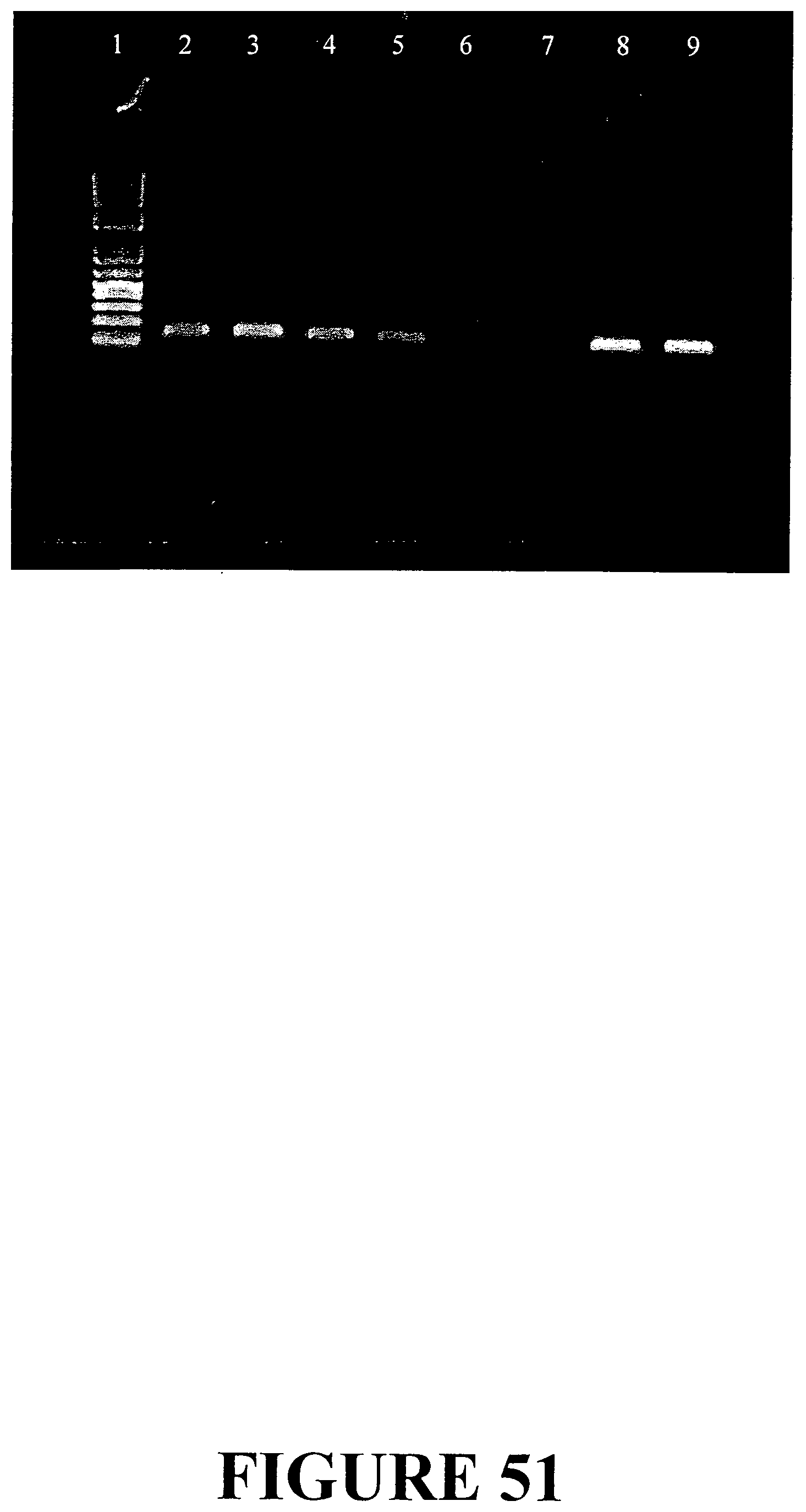
S00001
XML
uspto.report is an independent third-party trademark research tool that is not affiliated, endorsed, or sponsored by the United States Patent and Trademark Office (USPTO) or any other governmental organization. The information provided by uspto.report is based on publicly available data at the time of writing and is intended for informational purposes only.
While we strive to provide accurate and up-to-date information, we do not guarantee the accuracy, completeness, reliability, or suitability of the information displayed on this site. The use of this site is at your own risk. Any reliance you place on such information is therefore strictly at your own risk.
All official trademark data, including owner information, should be verified by visiting the official USPTO website at www.uspto.gov. This site is not intended to replace professional legal advice and should not be used as a substitute for consulting with a legal professional who is knowledgeable about trademark law.